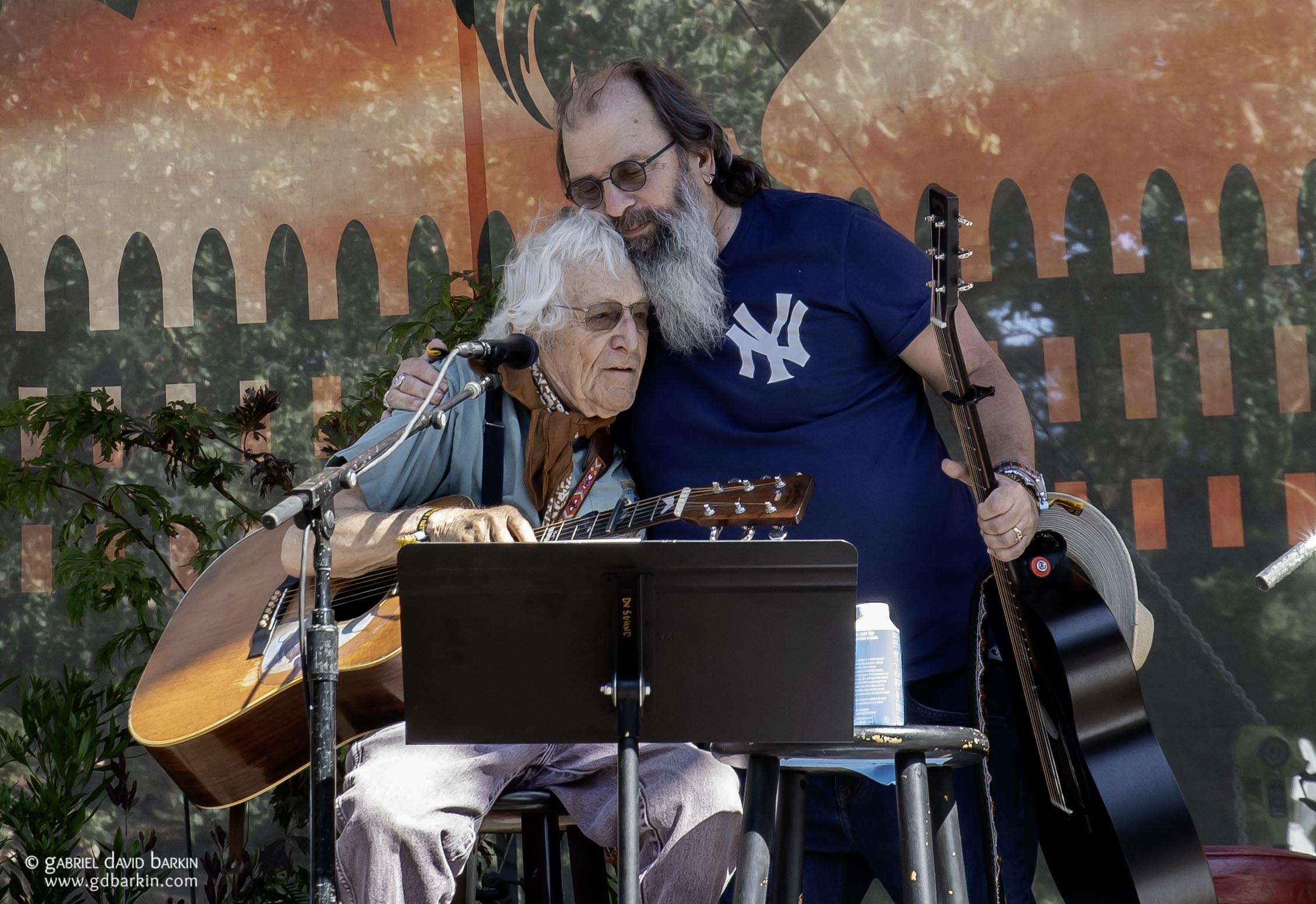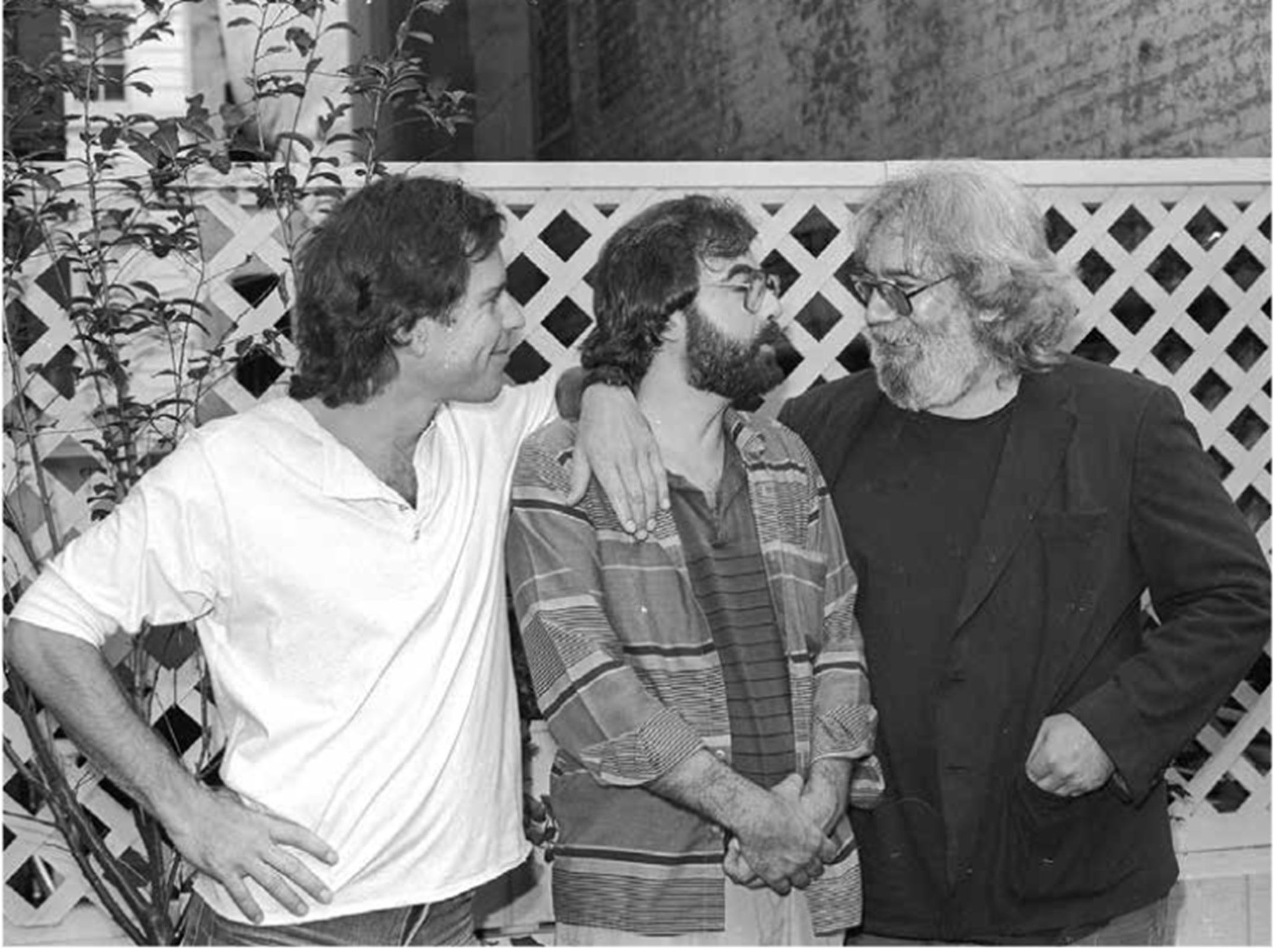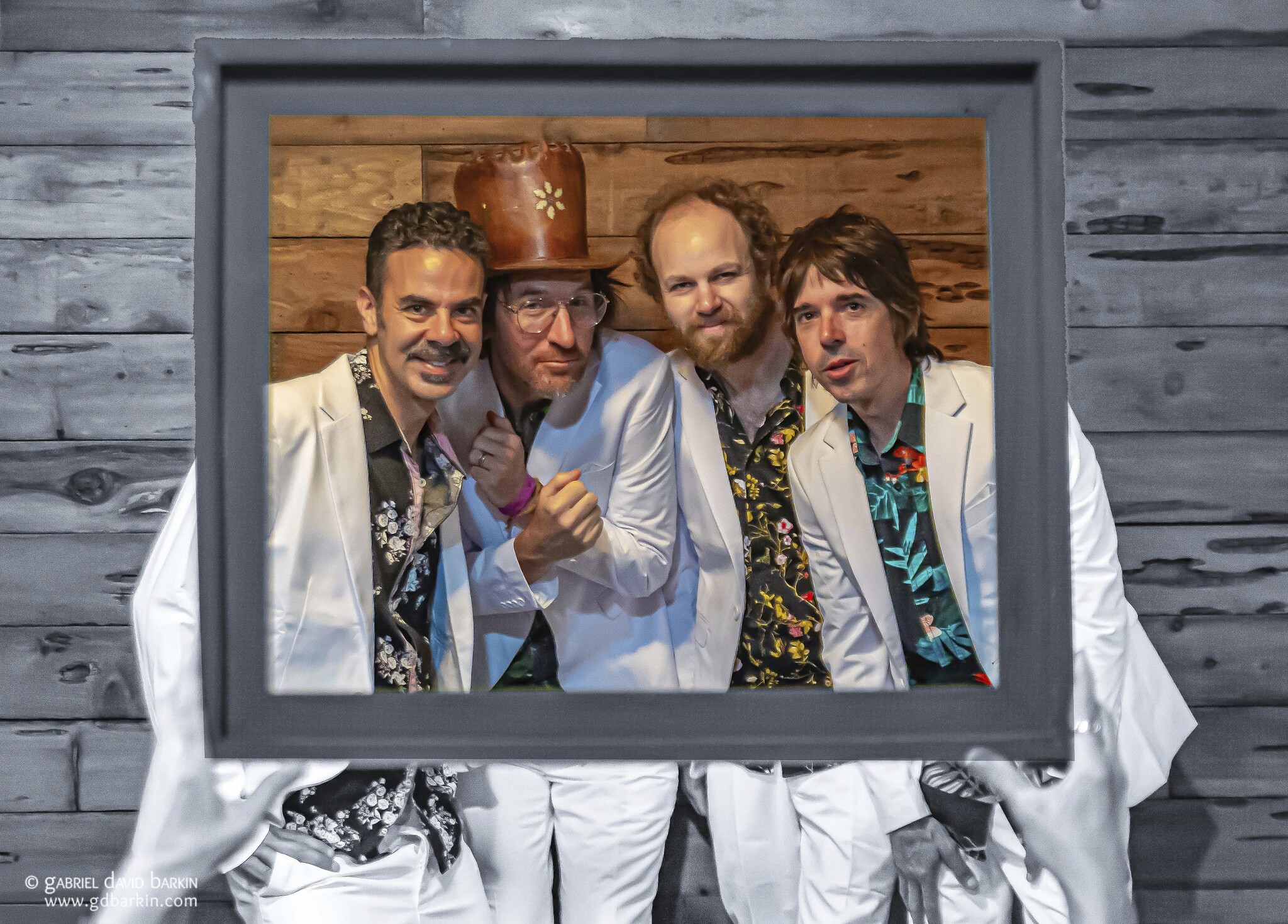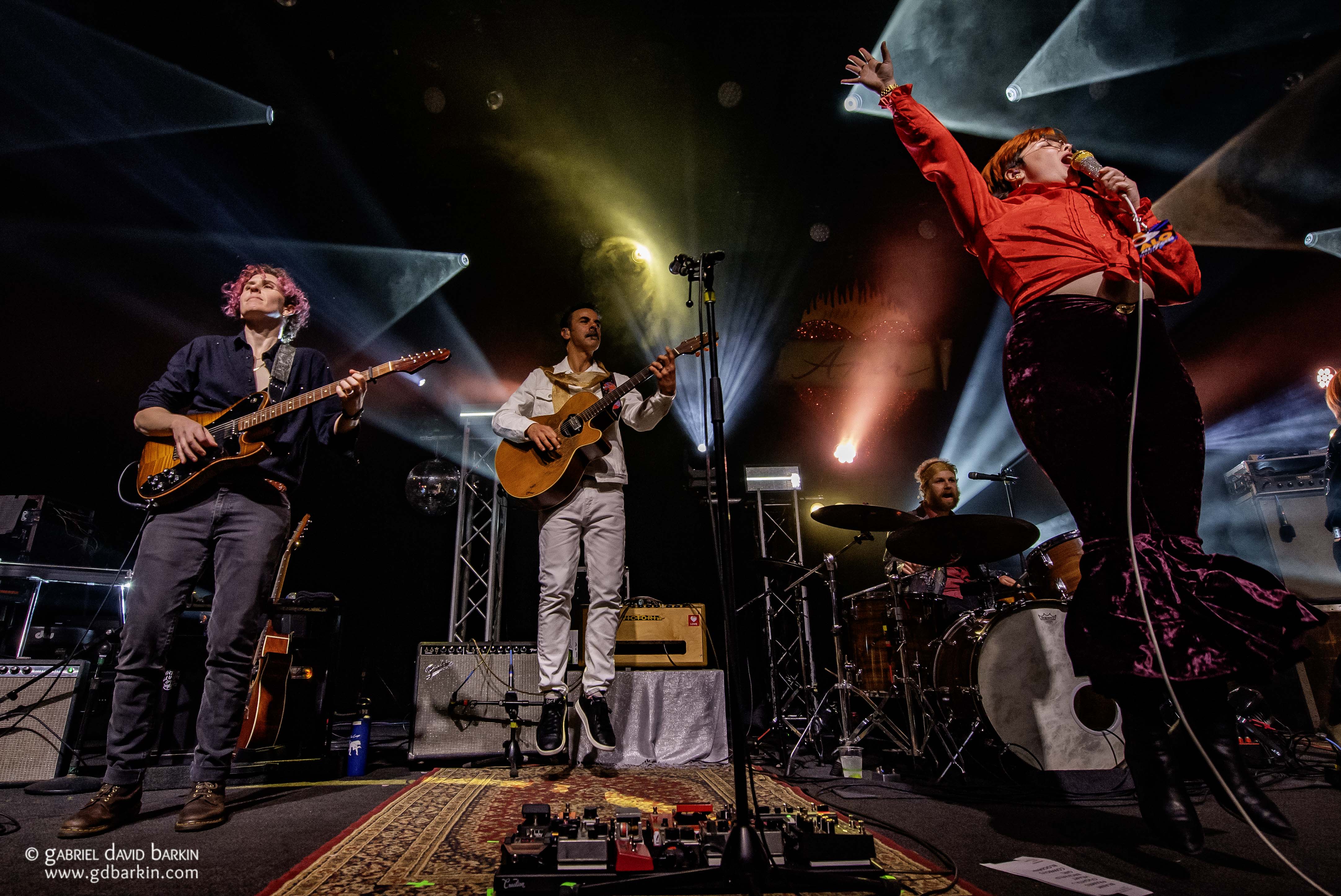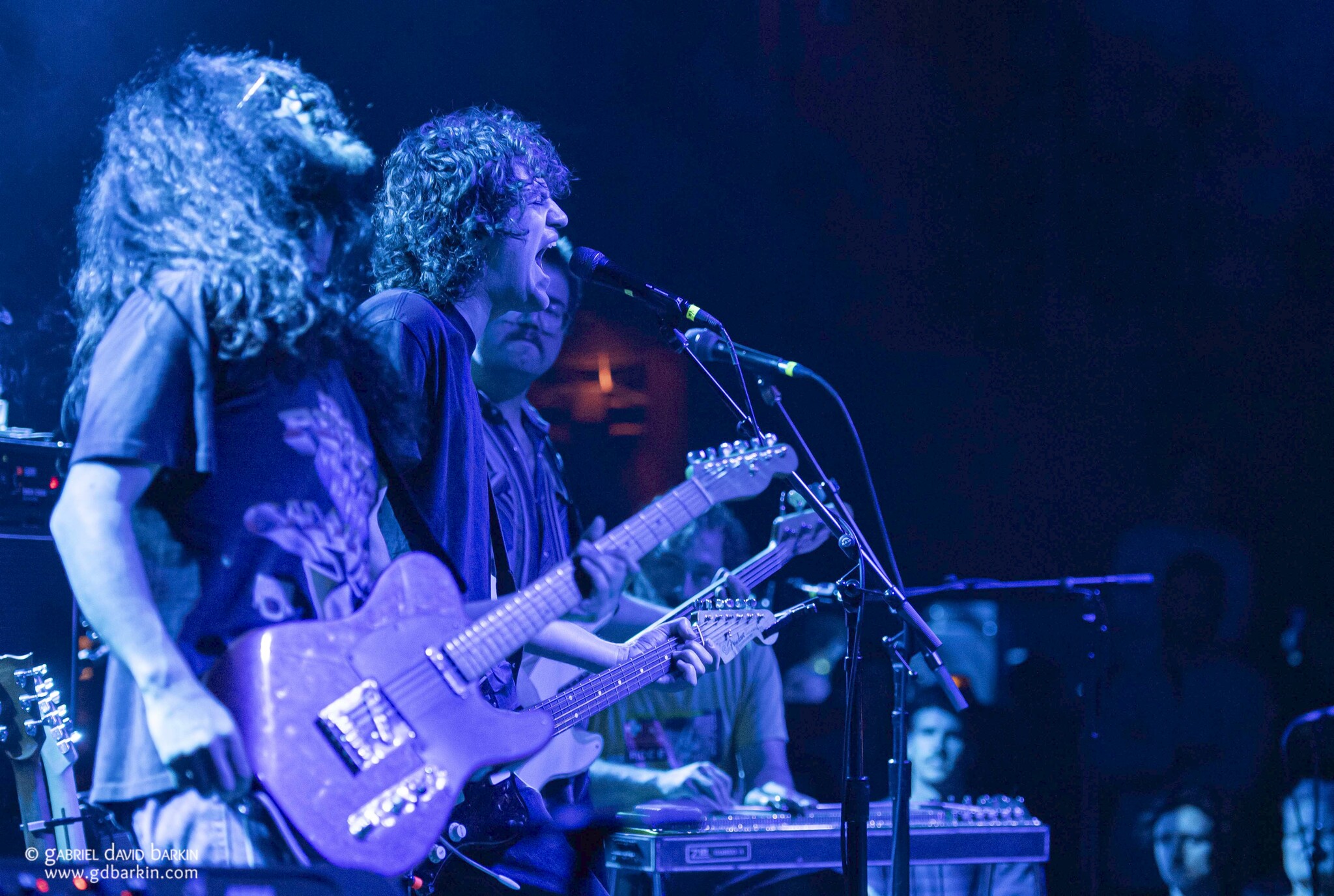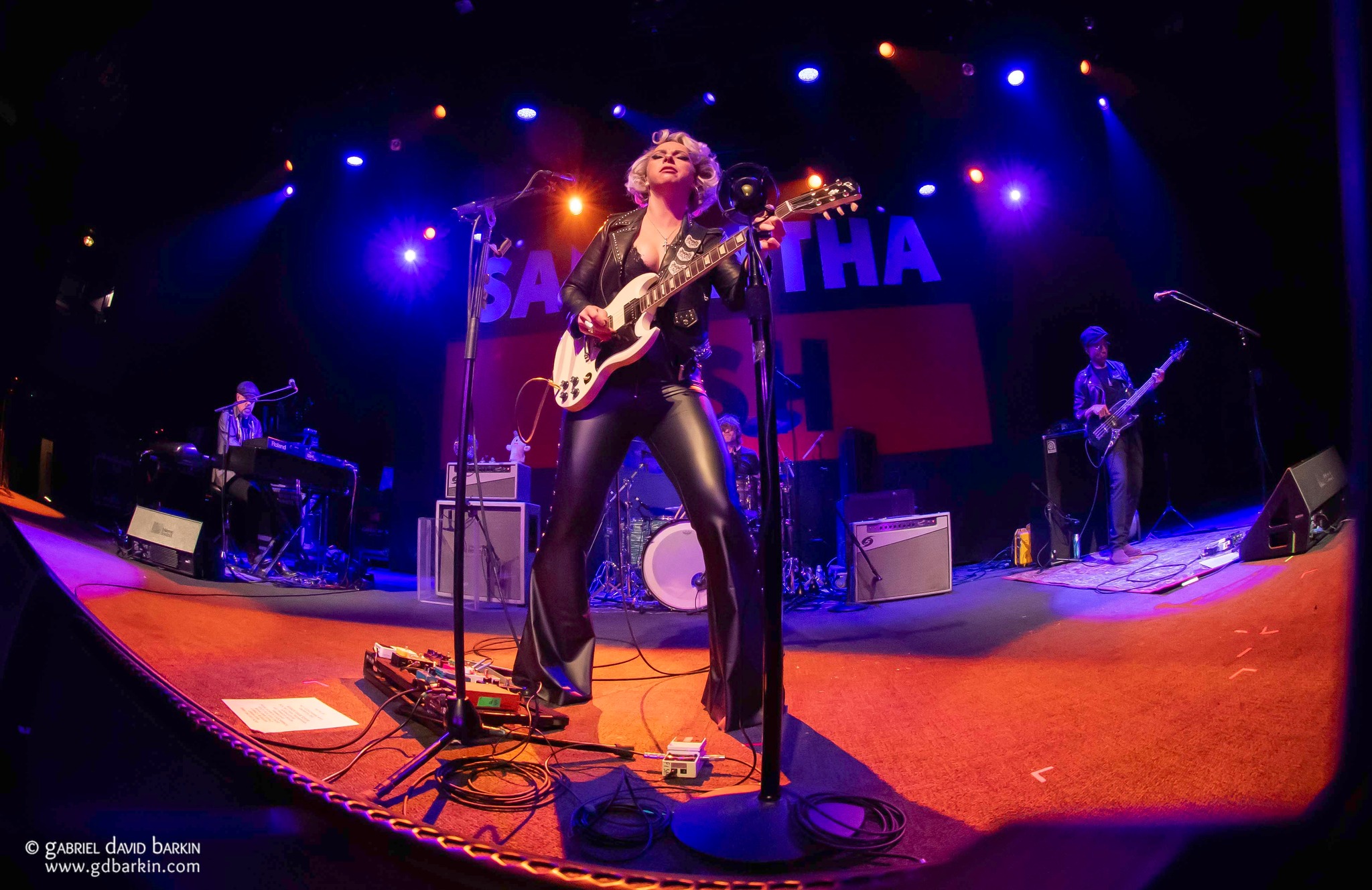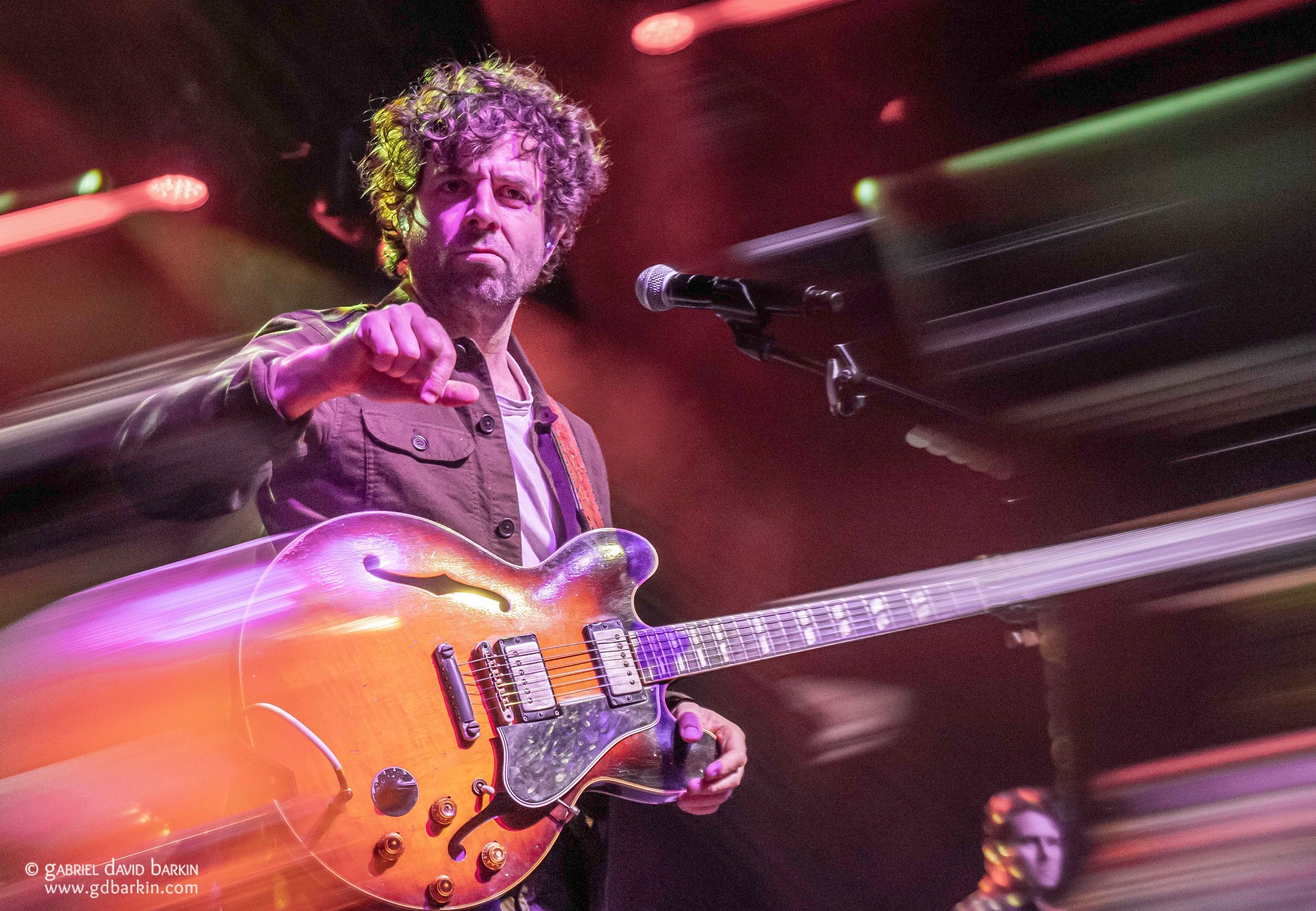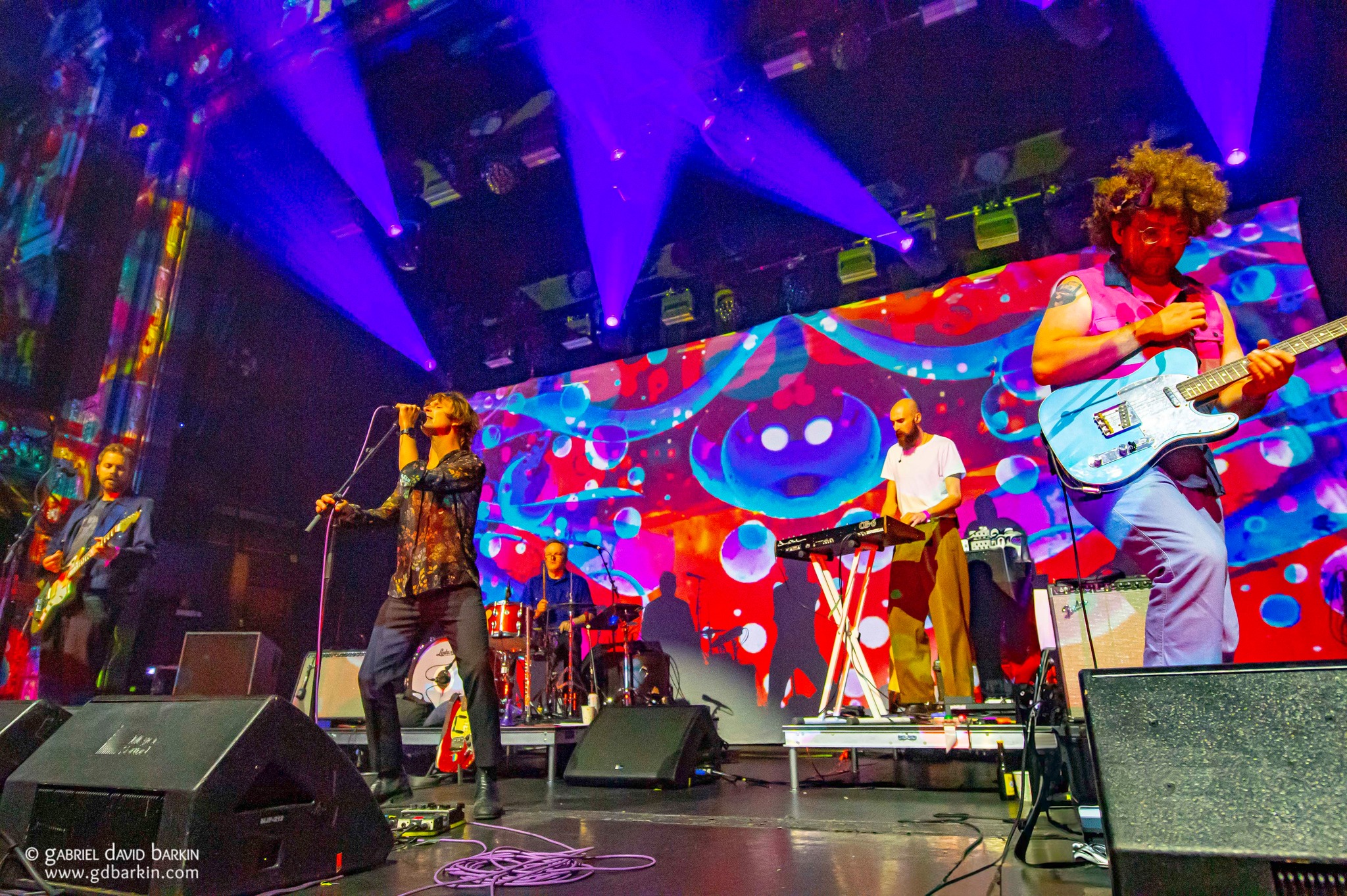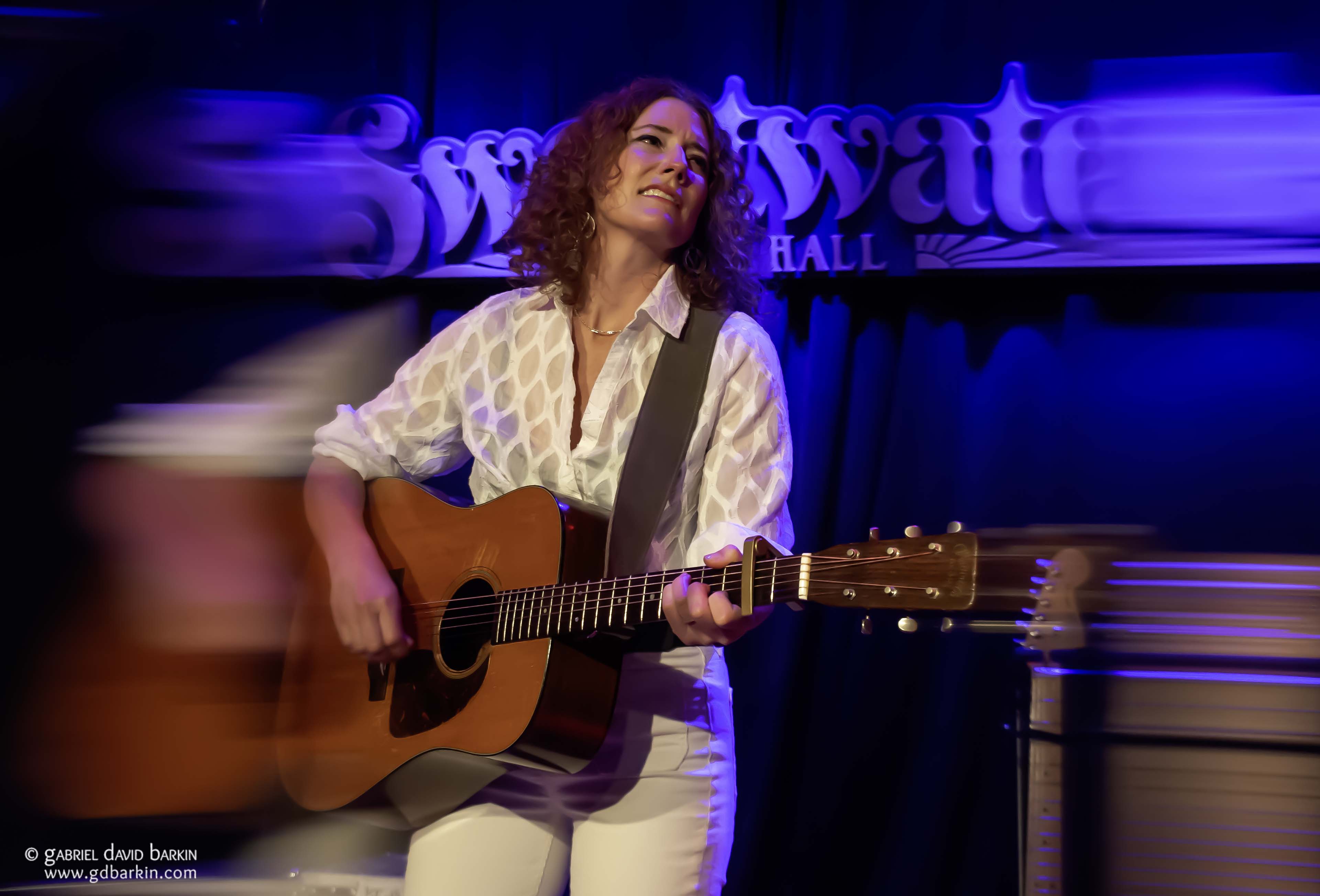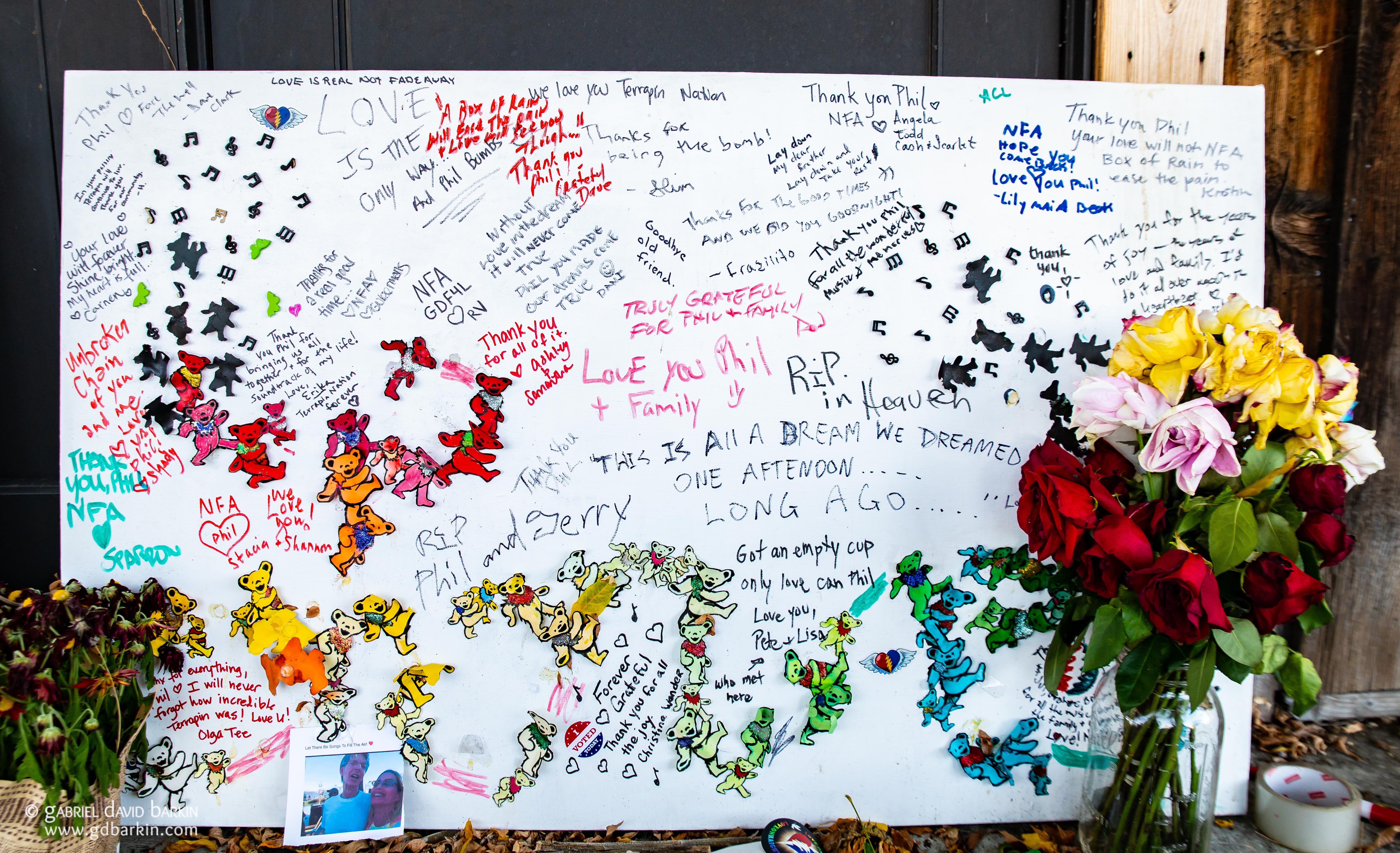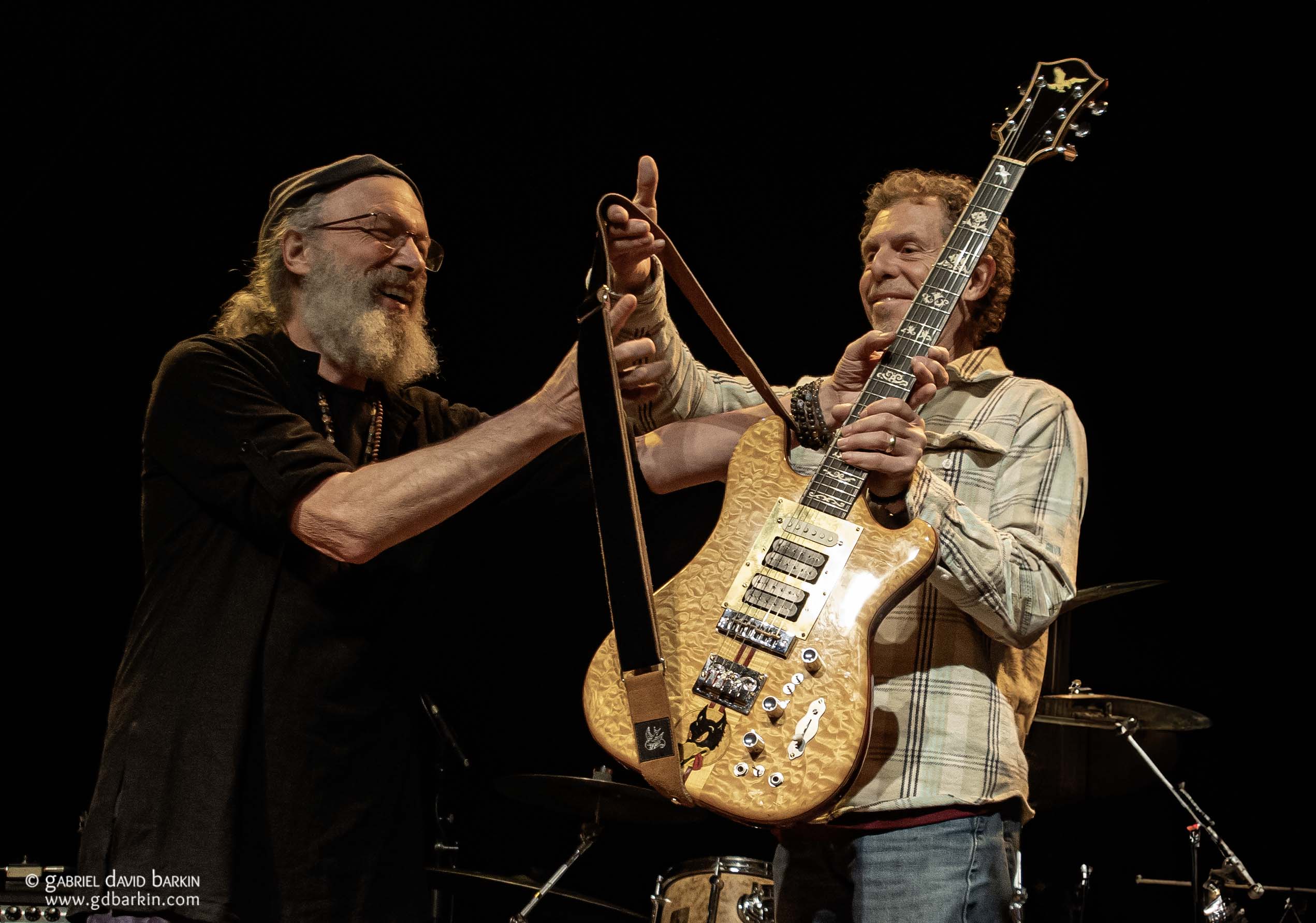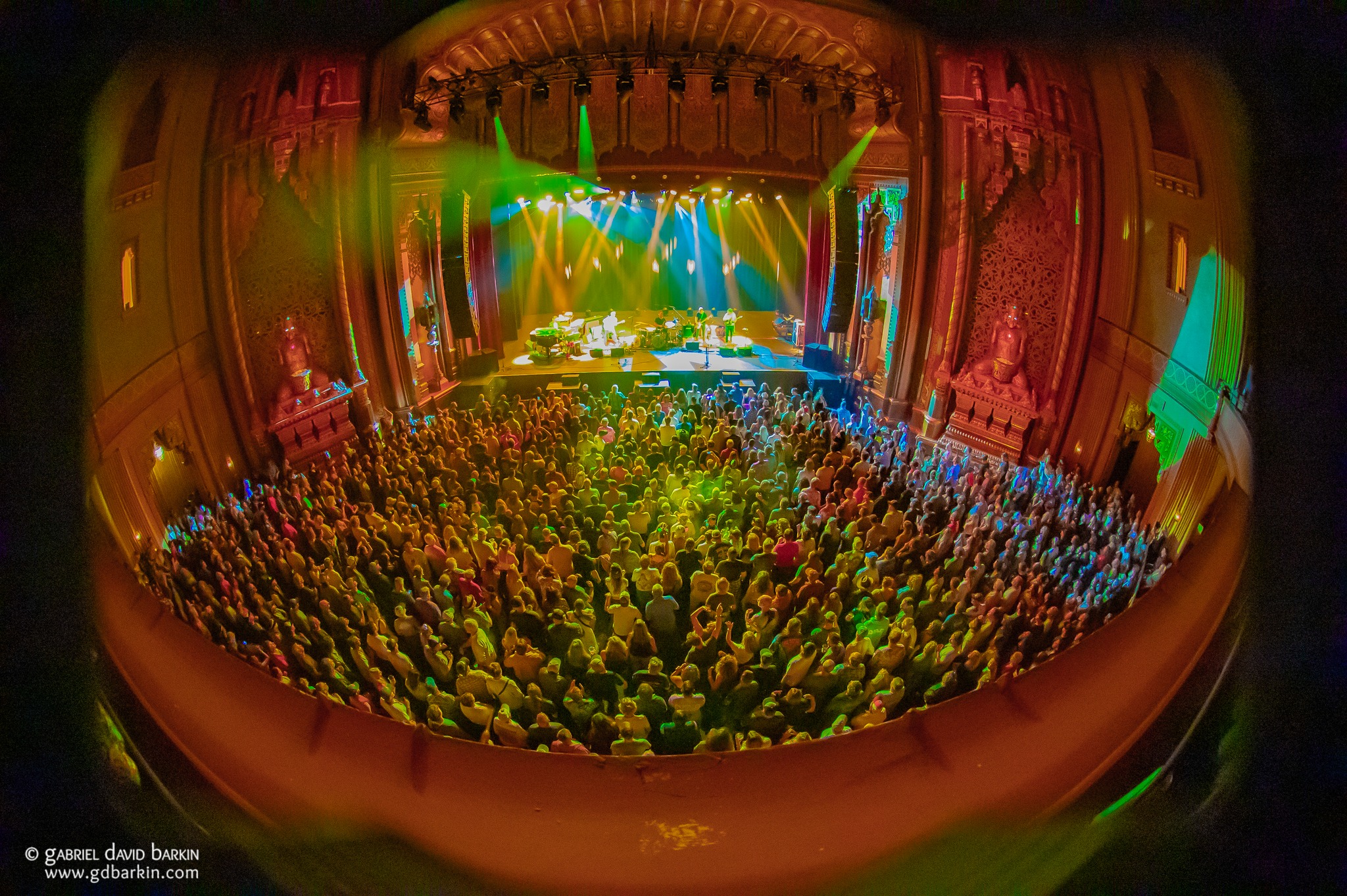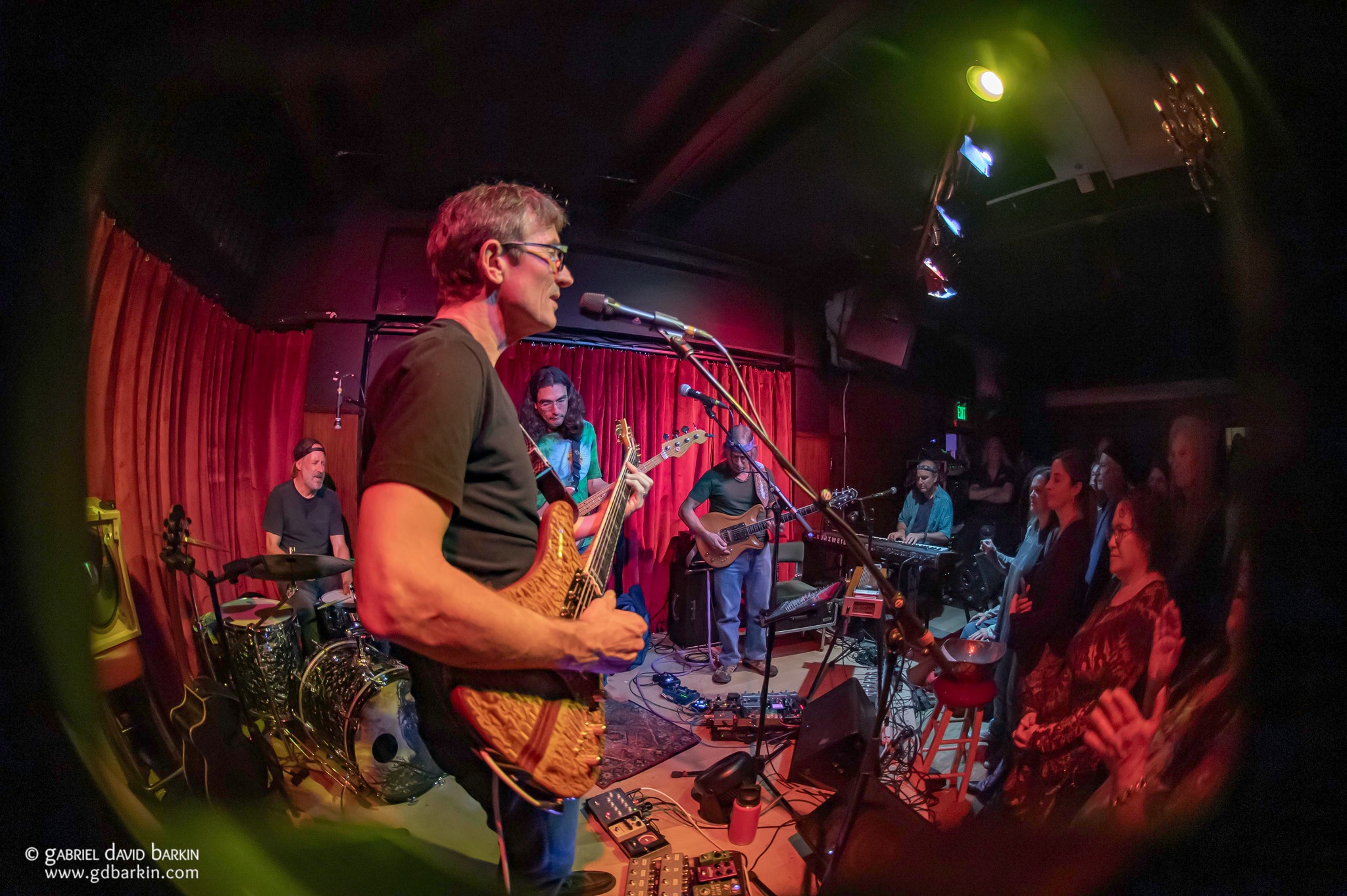This year's Hardly Strictly Bluegrass Festival (“HSBG”) in San Francisco's Golden Gate Park was—as usual, and as expected—a joyous and magical celebration for young and old, family and friends, musicians and music fans.
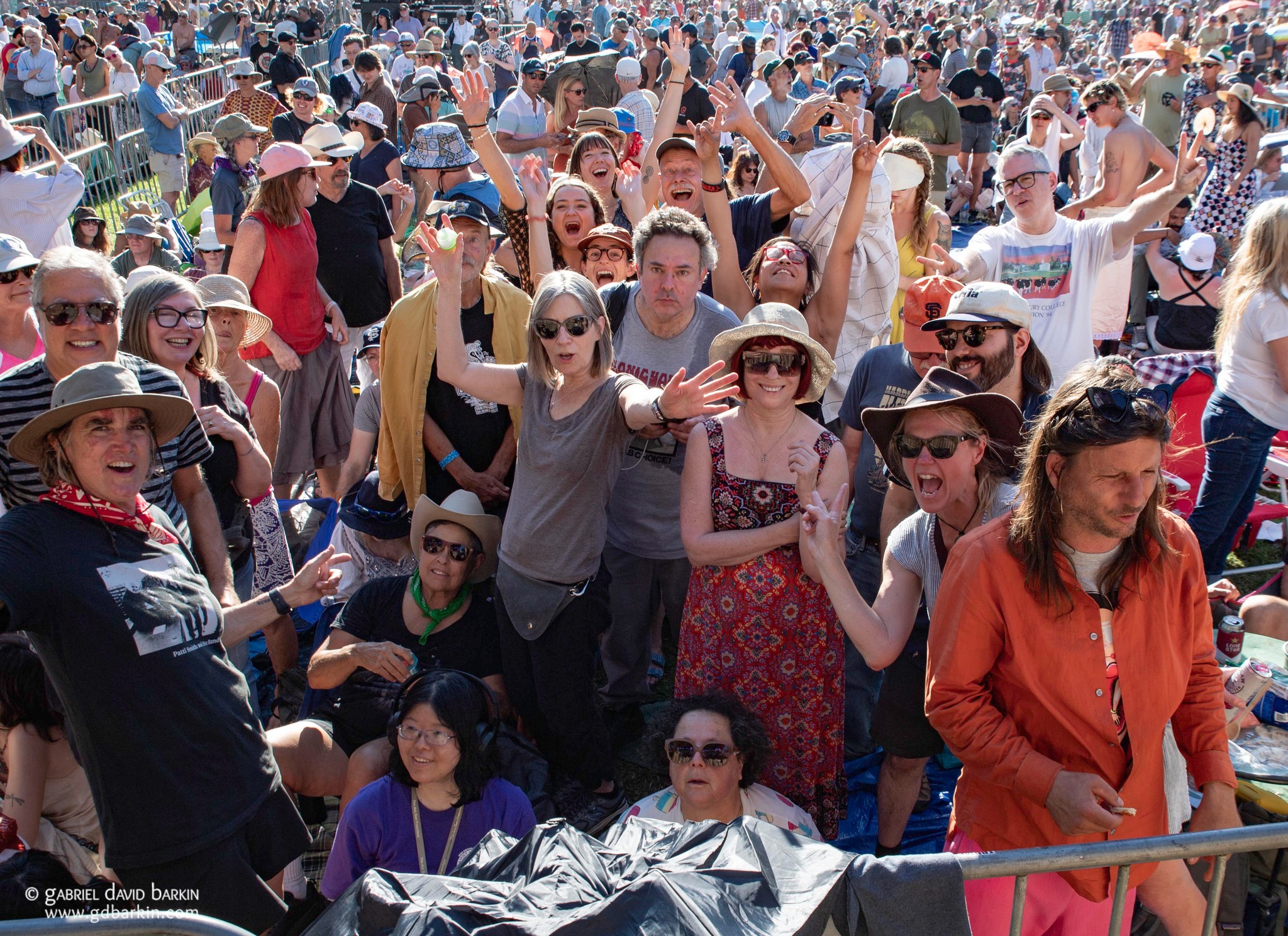
Despite the unseasonably warm October weather, tens of thousands of music fans from San Francisco, the surrounding Bay Area, and far beyond made the trek to the park for this year’s free festival. The relentless sun was challenging for some people, but the music was even hotter. Attendees huddled in the shady spots beneath trees between acts to keep cool, but they filled in the space in front of each stage during the performances. Frequent reminders from stage announcers to hydrate, apply sunscreen, and take care of each other helped too.
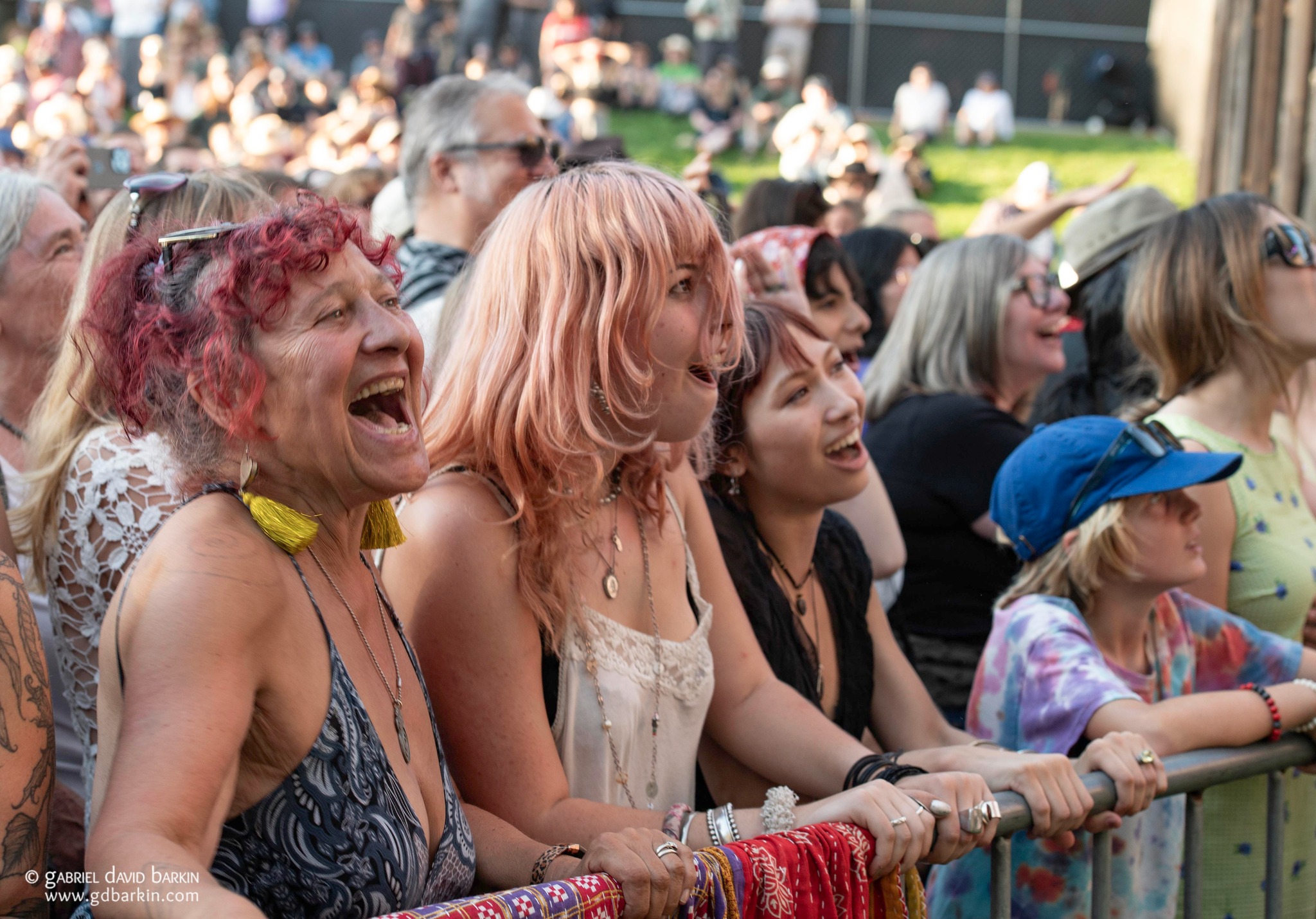
The heat may have kept many people from coming to HSBG this year, perhaps opting instead to head for beaches or stay home to watch the HSBG livestream from the comfort of their air-conditioned living rooms. Certainly, the event has seen larger crowds—but nobody was complaining this year that the Port-o-Potty lines weren’t long enough.
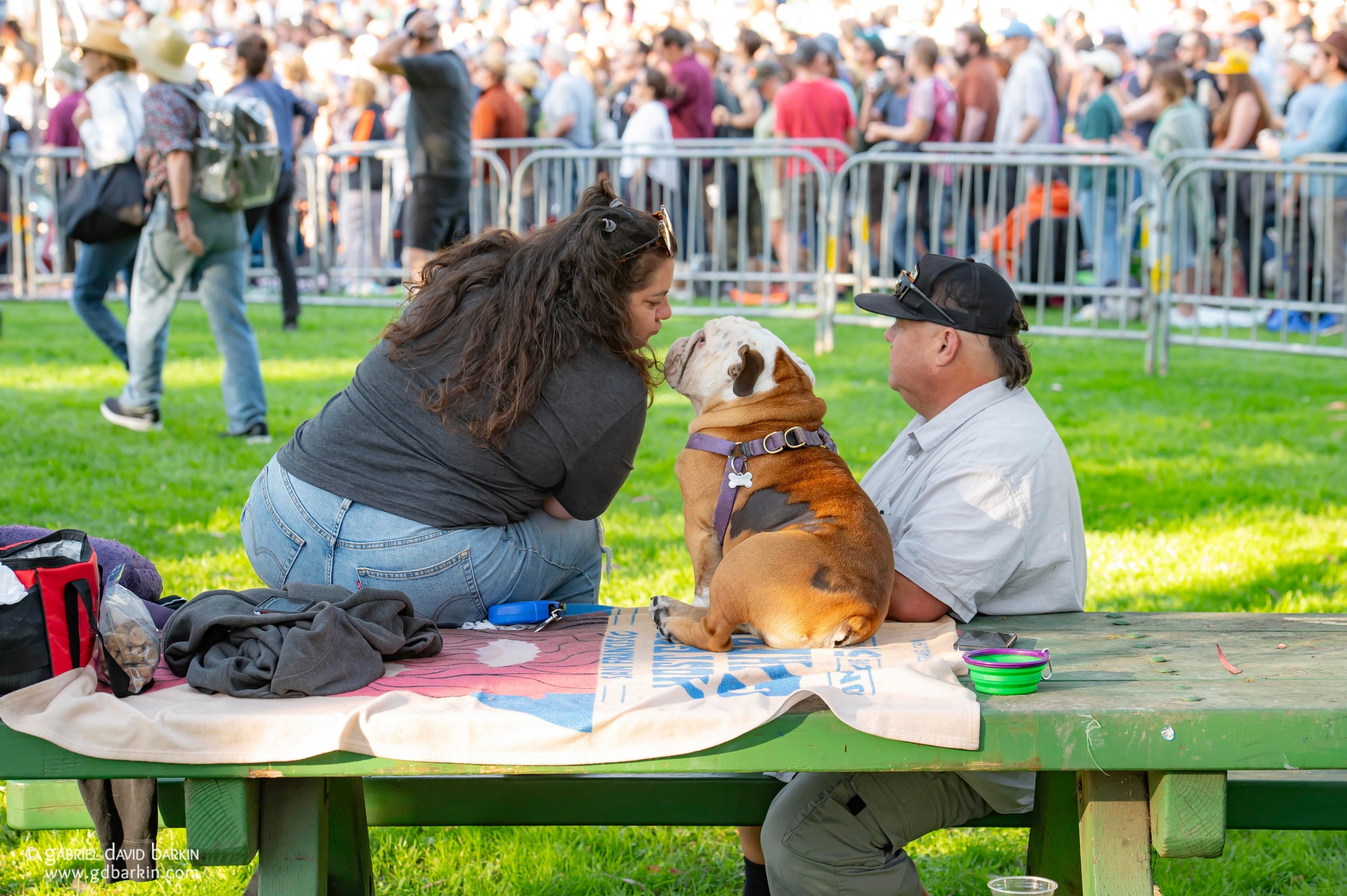
As usual for multi-stage festivals, it’s impossible to catch every act. Some concertgoers said they were conserving energy in the heat, traveling less between stages and hunkering down in one spot. Others said they were just getting too old to rush around and compete with friends to tally who could see the most acts. And let’s face it, traversing a half-mile across the park at the end of Sunday to see Emmylou Harris has a high cost if your car is parked all the way out at 37th Avenue. But no matter where you are at HSBG, you’ve got good music to fill your ears and good friends nearby to share the good times.
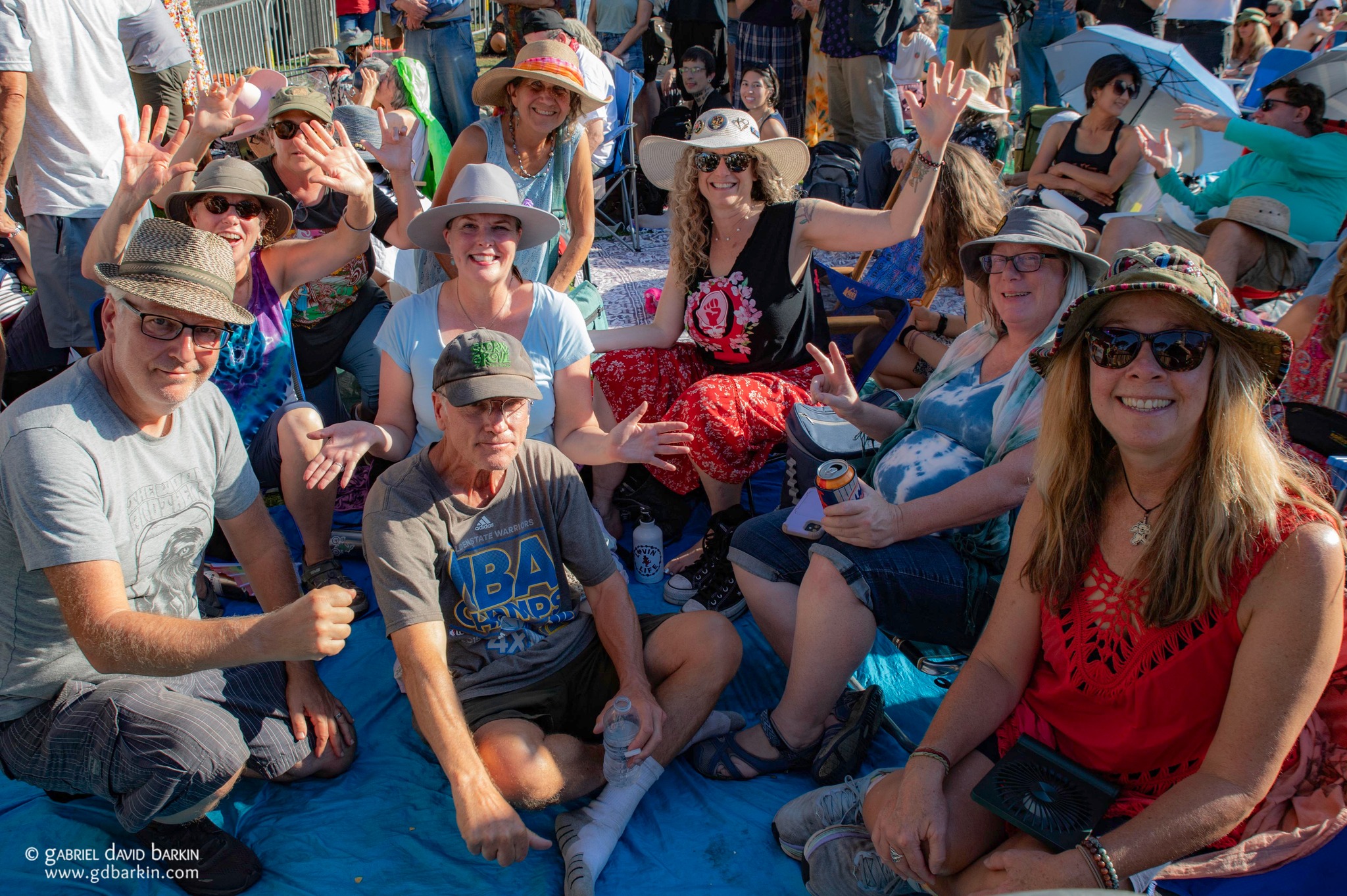
For me, my wife, and a wide circle of friends, the weekend of HSBG is celebrated as an annual holiday. Like kids before Christmas, our anticipation grows throughout the summer as we hear the first lineup teases. (HSBG announces ten new acts every two weeks during mid-summer via a “guess who?” medley of song snippets posted on their website before unveiling the entire roster of acts.) We share group texts and Facebook threads to discuss which acts we will see and coordinate which stages we will prioritize to throw down our tarps and blankets.
HSBG by the Numbers – Interlude #1:
- First year of the festival: 2001.
- Number of HSBG Festivals to date (including 2024): 22.
- Number of years without an HSBG since inception: 2 (due to COVID).
- Number of times Emmylou Harris has closed the festival on the main stage: 22.
I have only missed two of the 63 days of HSBG since 2001, one due to debilitating back pain (though I managed to hobble out for the other days that year), and one for reasons I can’t recall but I nonetheless regret. For me, missing a day of HSBG is like forgetting to breathe.
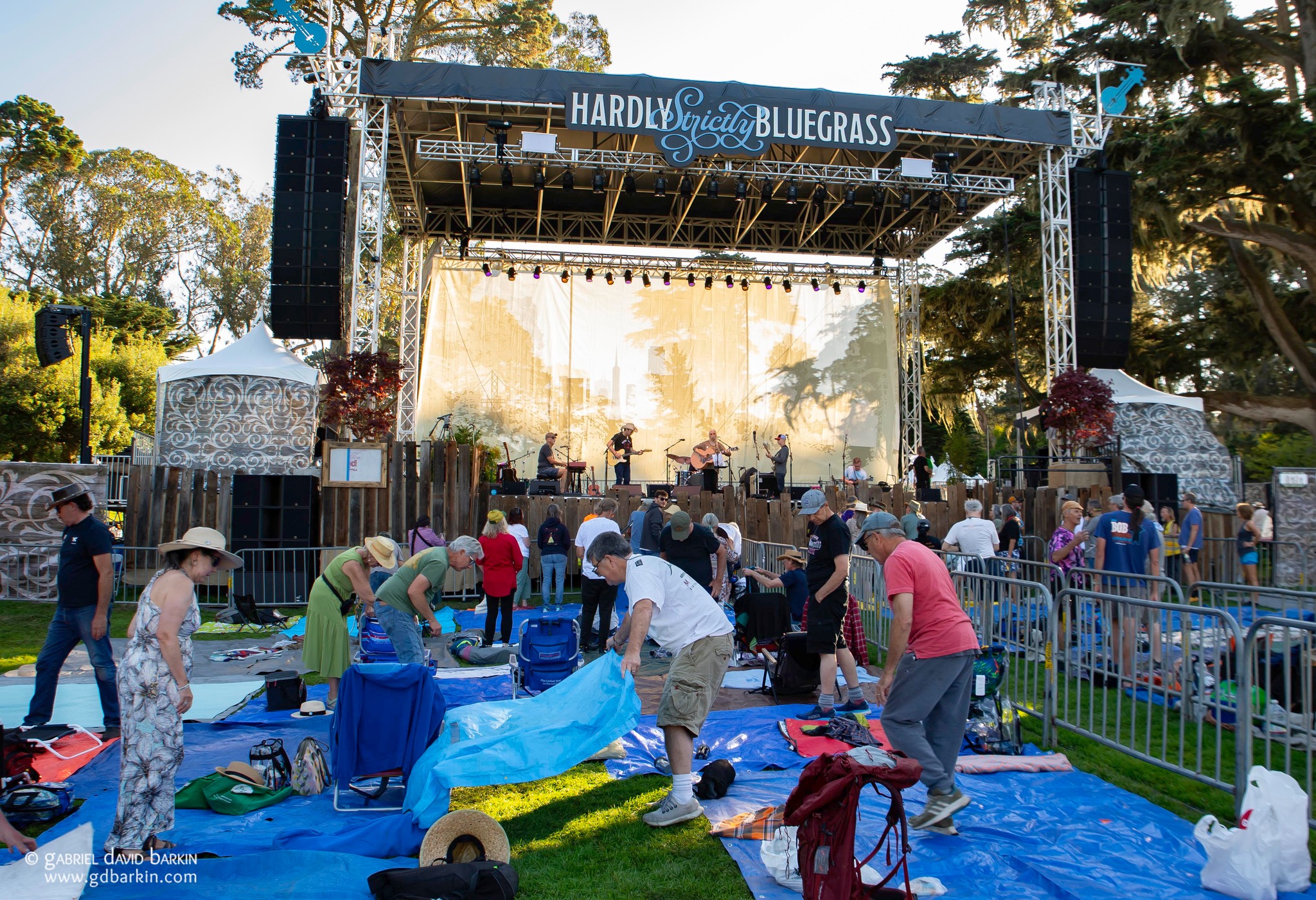
For many years, I was an early arrival in the park, throwing down a tarp or two for my crew by 7 am. I spent many early Sunday mornings listening to Emmylou Harris—one of only two singers to appear at all 22 HSBG festivals (the other is Steve Earle)—run through her traditional soundcheck before a small audience at the Banjo Stage. A few years ago, in the wake of increasing security concerns at events throughout the U.S., HSBG began erecting fences and conducting backpack searches, requiring lineups before the gates opened each morning. Harris, who used to do her soundchecks at around 8:30 am, obliged by moving her soundcheck to shortly after the gates opened so early arrivals could still enjoy the sneak peek. (No pictures allowed!)
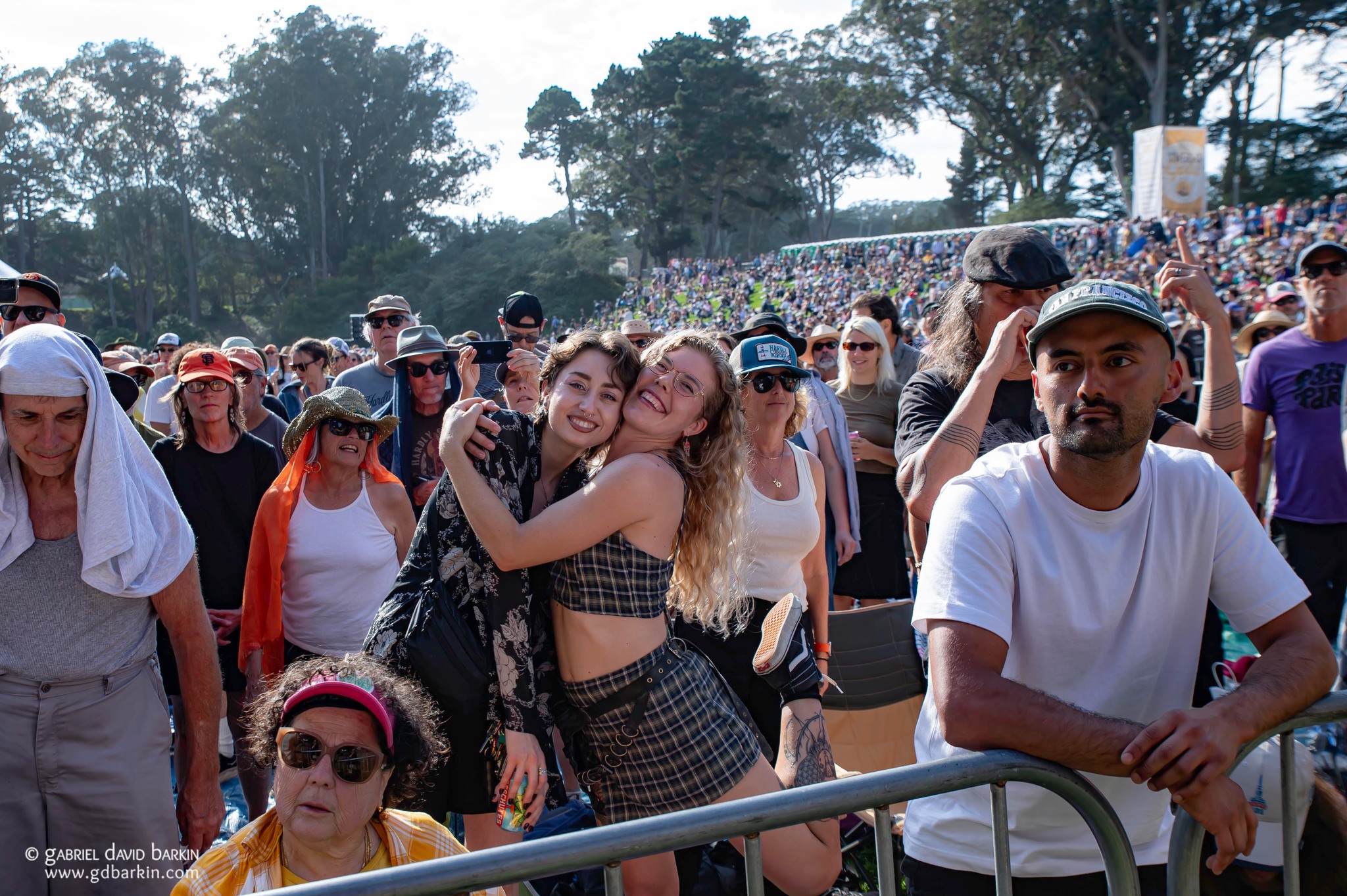
The festival was founded by Warren Hellman, a successful investment banker and philanthropist who was also a passionate bluegrass fan. His goal was to share his passion and provide an opportunity for people to experience the joy of music. In addition to funding HSBG, Hellman also provided financial backing to organizations that provide music education to youth in the Bay Area and beyond. Hellman died in 2011, but his legacy includes funding for HSBG for many years to come. Hellman’s family continues to take the lead as producers of HSBG.
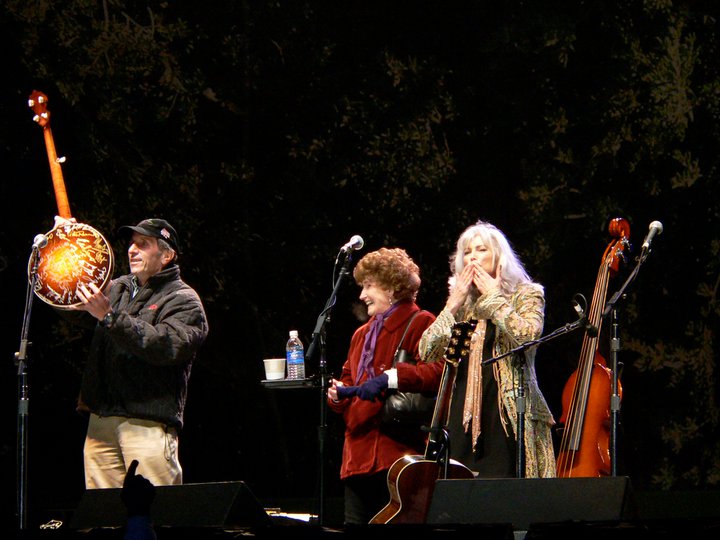
Hellman himself was a banjo player. One of my all-time favorite HSBG moments was watching in 2007 as Emmylou Harris and Hazel Dickens presented Hellman with a gift of a banjo signed over the previous year by “just about everyone in bluegrass.” Hellman also played several sets himself over the years with his band The Wronglers.
HSBG by the Numbers – Interlude #2:
- Number of HSBG Festivals that were “Strictly Bluegrass”: 2 (the inaugural and second years, 2001 and 2002).
- Number of HSBG days each year: The first year was just one day, and the second year was expanded to two days, but it's been a three-day event since the third year.
- Scheduled number of performances in 2001: 9.
- Scheduled number of performances in 2024: 72.
HSBG is notable for being “Hardly Strictly” bluegrass music. As noted above, the first two years were deemed “strictly” bluegrass (although even then, there were some tangential performers). Bluegrass pioneers including Doc Watson, Earl Scruggs, and Ralph Stanley have graced the Banjo Stage with performances. Over the years since becoming “Hardly Strictly,” however, the festival’s genre range has included hip-hop (e.g., MC Hammer), funk (e.g., Trombone Shorty), African pop (e.g., Angelique Kidjo), jam bands (e.g., String Cheese Incident), and alt rock (this year features Sleater-Kinney).
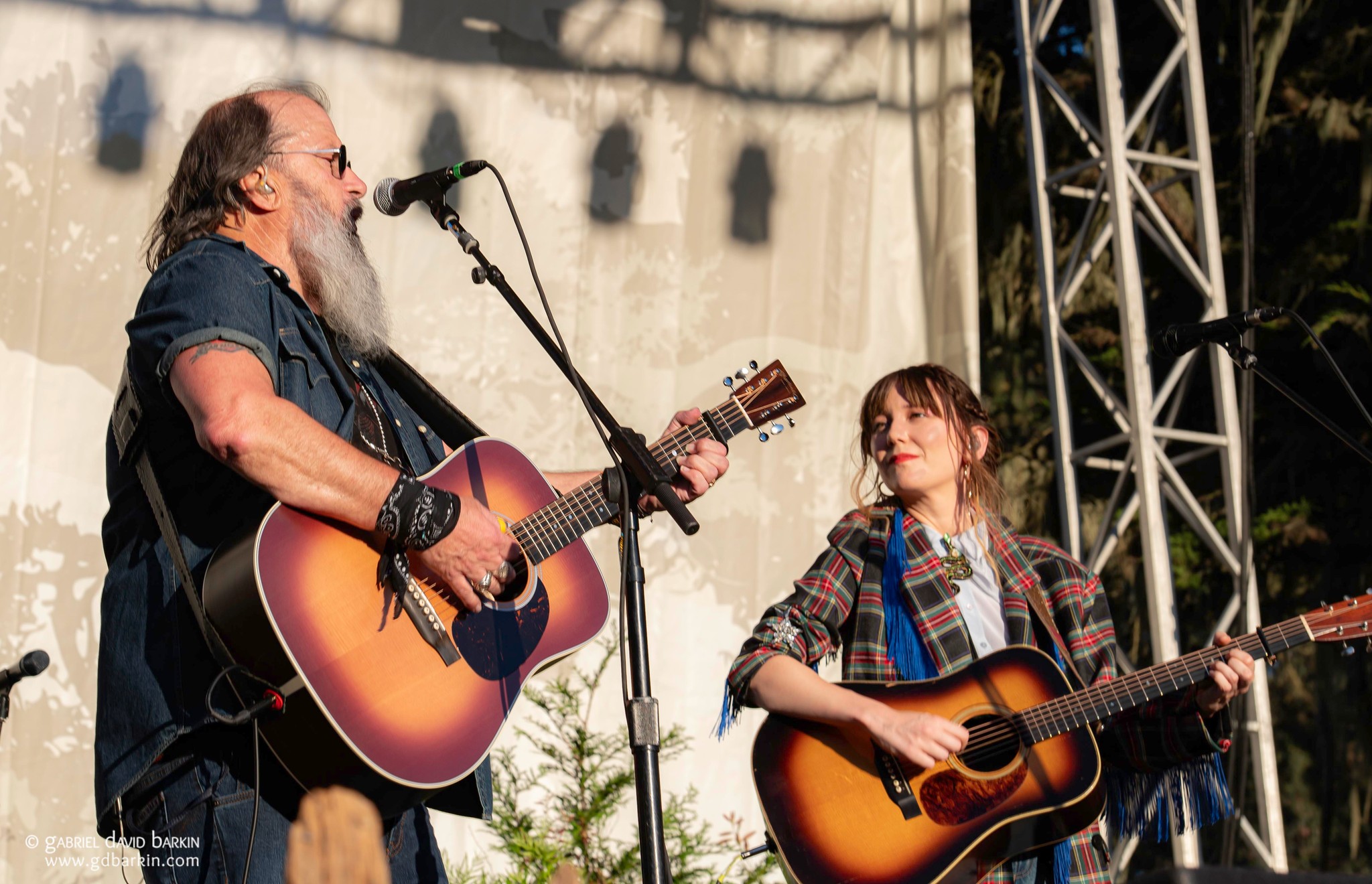
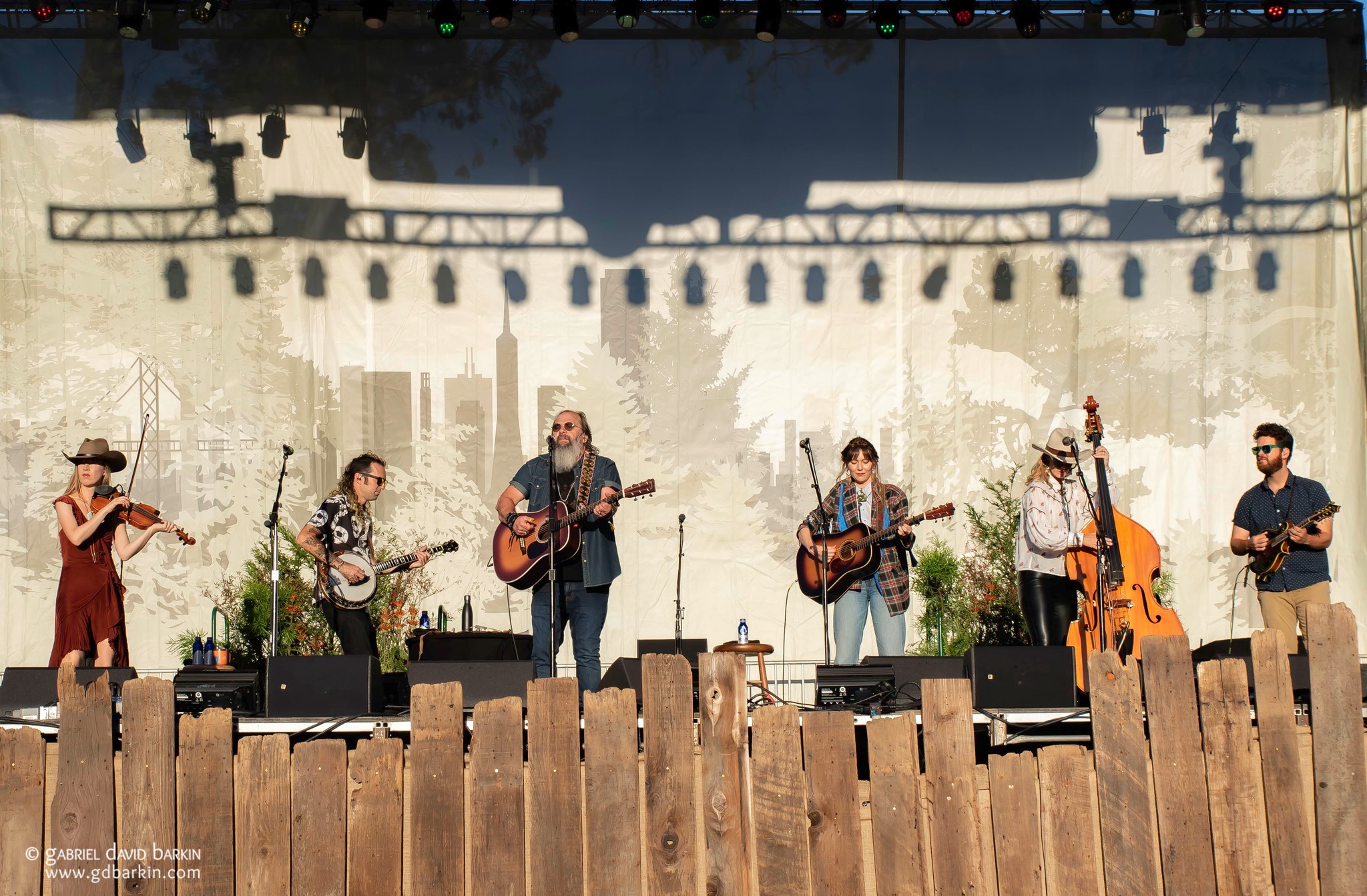
The eclectic, genre-eschewing range of headliners for 2024 included bluegrass from Steve Earle (backed by Molly Tuttle and Golden Highway), Greensky Bluegrass, and The Infamous Stringdusters; alt/punk rock from Sleater-Kinney and Yo La Tengo; Americana from Ramblin’ Jack Elliott and The Wood Brothers; and the stylized not-quite-traditional Ukrainian folk of DakhaBrakha. Patti Smith made her fourth appearance at HSBG. For Emmylou Harris, it was her twenty-second time closing the Banjo Stage.
HSBG by the Numbers – Interlude #3:
- Members of Led Zeppelin who have appeared over the years: 2 (Robert Plant, both solo and with Alison Krauss; John Paul Jones with Dave Rawlings Machine).
- Number of appearances over the years by Dolly Parton, Merle Haggard, Cheap Trick, Aimee Mann, Willie Nelson, Wynonna Judd, Michael Franti, Marty Stuart, Dwight Yoakam, the String Cheese Incident, Jackson Browne, and Rufus Wainwright: 1 each (so far).
- Number of acts with different names fronted by Mekons singer and guitar player Jon Langford over the years: at least 13, but ordinary math may not be applicable in this instance.
- Number of times Steve Earle has asked the crowd to join him in flipping off the ear-shattering “Blue Angels” (the U.S. Air Force elite flying squad, often in town the same weekend as HSBG for "Fleet Week") for interrupting his set with jet aircraft noise: at least 1, my wife says more.
DAY ONE: FRIDAY, OCTOBER 3
The Banjo Stage kicked things off with a tribute to Lucinda Williams. (My wife says it’s nice when festivals have tributes to artists before they die.) Steve Earle, Chuck Prophet, Kelly Willis, and Ismay sat together and took turns on selections from Williams’ legendary songbook. Earle’s spin on “2 Kool 2 Be 4-Gotten” was delivered in an iconic Steve Earle growl that was almost Tom Waits-ish. Willis invited her fellow Wonder Women of Country Melissa Carper and Brennen Leigh on stage for a few songs. The four-plus-two ensemble closed the set sharing verses on “Jackson.”
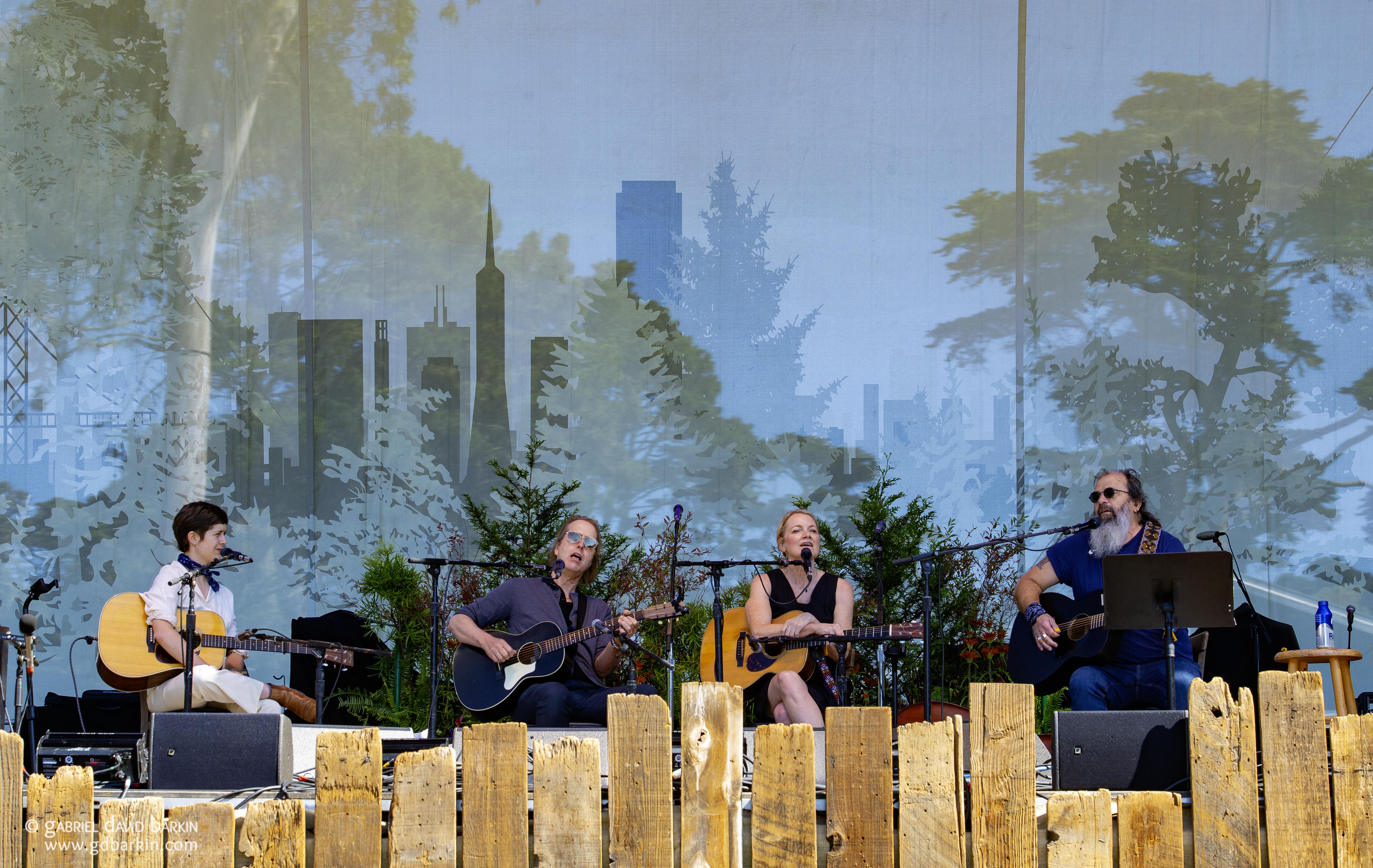

Over at the intimate Arrow Stage, Lindsay Lou and her band had festooned their mic stands with yellow flowers. Lou, who can sing the phone book (as they say), sang entire verses to introduce each of her band members. She also displayed some mad whistling skills and hypnotized the adoring audience with what might best be described as human Theremin yodeling.
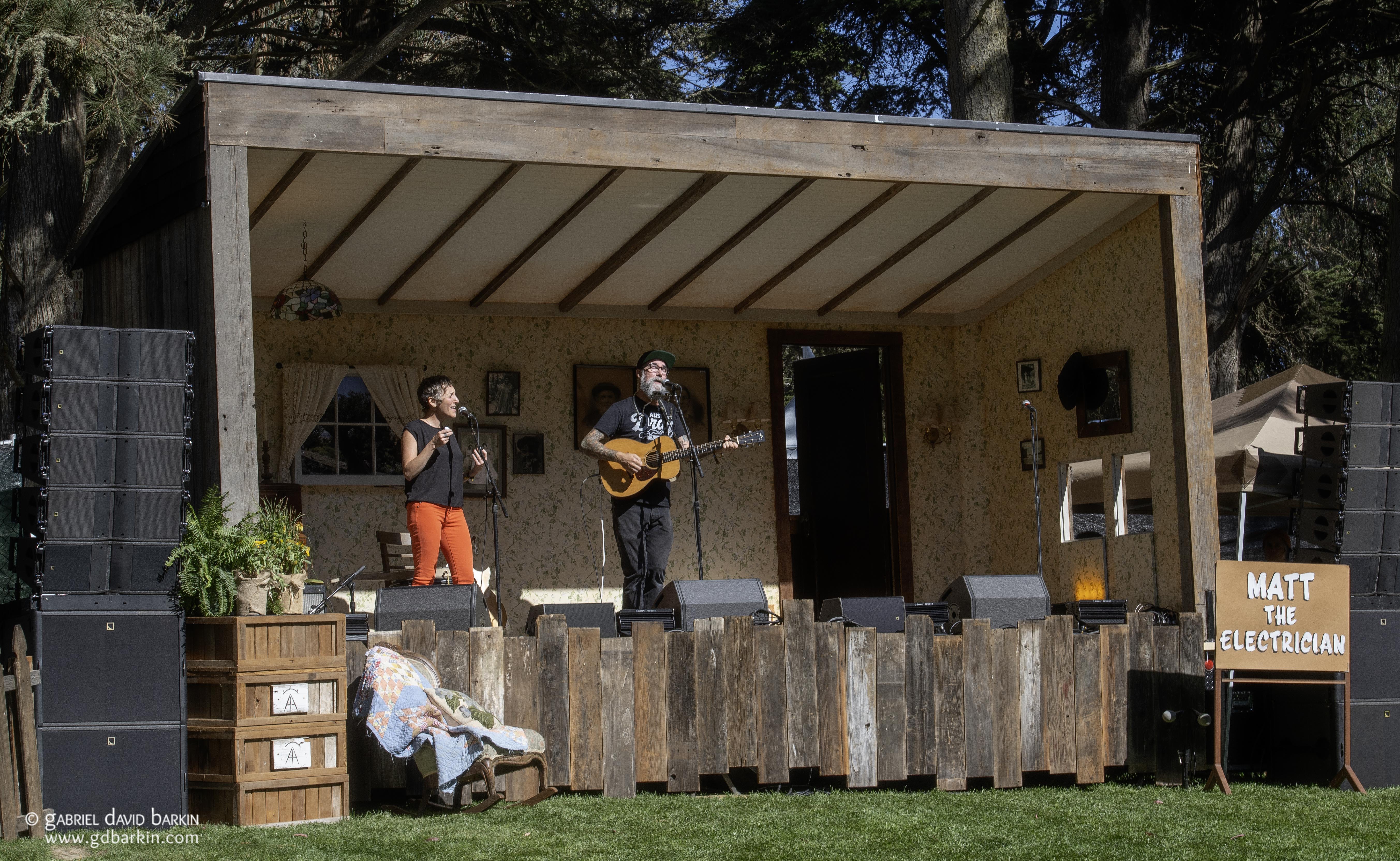
On the even more intimate Horseshoe Hill Stage, decorated like a backwoods living room, Matt the Electrician gave a taste of his lyrical mastery. For instance, in “The Ocean Knocked Me Down”:
Let’s feel sad together
Let’s stay mad forever
Let’s build roads where nobody goes
Let’s all help to carry when it’s big and scary
Let’s give hands to hold till we let go
Matt (who, yes indeed, used to be a real professional electrician) also threw in a few lyrics from the opening number of “Jesus Christ Superstar” and—despite teasing that he was going to play a Mr. Bungle cover to close his set—chose to ask* the audience to sing along on the Indigo Girls’ “Closer to Fine.” (*Actually, he didn’t give the audience a choice about singing: “If you don’t wanna sing along, well, you have to sing along.”)

It’s a mystery both why and how Devendra Banhart wore a sleeveless sweater for his set in 85-degree weather. Maybe the lyric of “Seahorse” gave a clue: “Well I’m high and I’m happy and I’m free.”
“Seahorse” was a highlight of the set, a classic San Francisco sound with a long reverb-infused psychedelic jam in the middle à la Quicksilver Messenger Service. A cover of the Grateful Dead’s “Shakedown Street,” sung by Banhart in his distinctively twee accent, got the crowd to its feet. For bonus points, Banhart’s bass player taught everyone how to say “love” in Welsh. (It’s “cariad,” and you roll the Rs.)

That was on the Towers of Gold Stage. Fun fact: This stage took its name from a book written by fest founder Hellman's cousin Frances Dinkelspiel about their great-grandfather: Towers of Gold: How One Jewish Immigrant Named Isaias Hellman Created California. The Towers Stage sits back-to-back with the Swan Stage, and the two venues are scheduled so one act begins when the other ends. It’s common for people to bounce back and forth between these two stages all day, or to stay put at one where you can hear the other on the PA if you don’t care to see what the band on the other stage looks like.
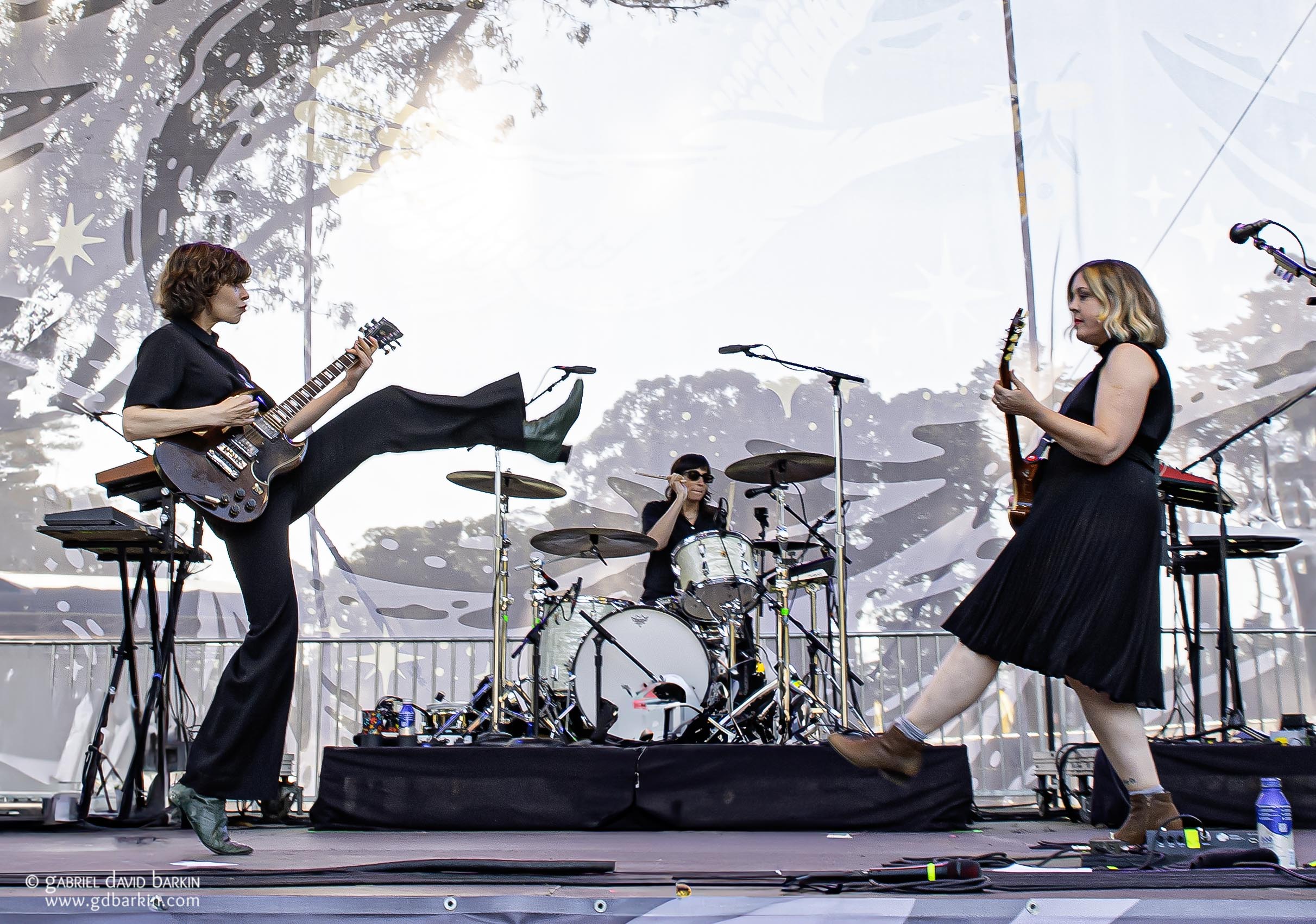
At the moment Banhart ended his set on Towers, Sleater-Kinney walked on the Swan Stage. It’s fair to say they might win this year’s award for “Hardly’est Bluegrass.” The Olympia, WA, indie punk stalwarts are celebrating 30 years since their founding (not 40 years, as the stage announcer mistakenly said in his intro). They took a hiatus in the early 2000s during which Carrie Brownstein, one of the band’s frontwomen, found television fame on “Portlandia.” Perhaps half of their fan base was fervid Sleater-Kinney devotees as far back to the riot grrrl days of the '90s, and the other half discovered them because of the TV show.
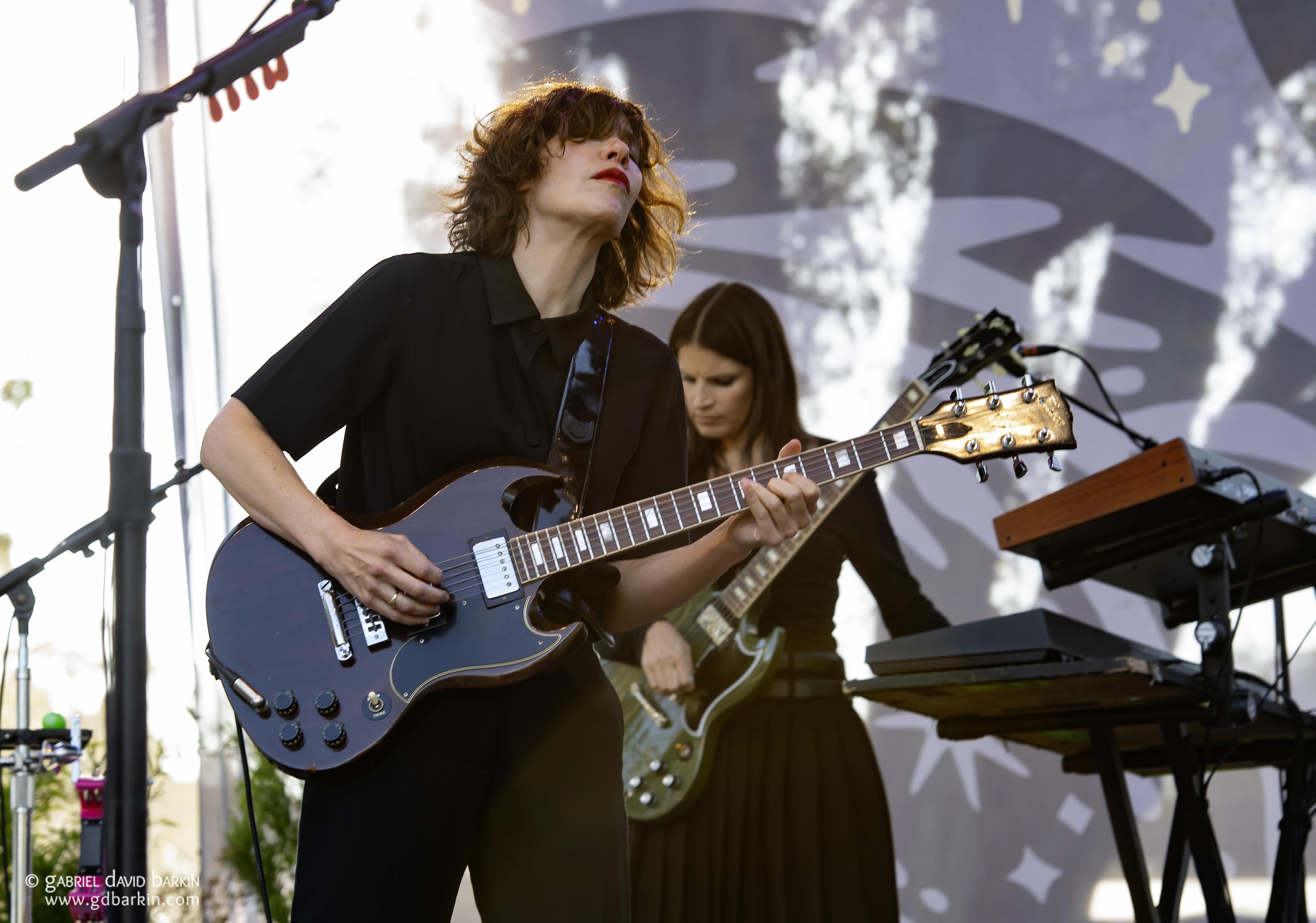
Sleater-Kinney slayed at HSBG. Brownstein and Corin Tucker, dressed all in black, alternated on their distinctive melodic yet scream-ish lead vocals. Brownstein’s iconic fuzztone guitar leads were equally matched by her well-honed guitar goddess poses, kicks, and leaps. The set mixed a number of new songs from their 2024 release Little Rope (including a few from the soon-to-be-released deluxe version of the album) with fan faves like “Modern Girl” and the poignant Golden Gate Bridge homage “Jumpers.”

I first saw Cat Power in the '90s opening for Guided by Voices in a NYC club. At that show, she had the stage lights dimmed to near-darkness, and her hair hung over her eyes. She seemed uncomfortable on stage, but her voice was transcendent. At HSBG, she performed a set of early-'60s Bob Dylan music, and her anxiety and shyness were on full display. She held her hands behind her back for the first half of her set, and no photographers were allowed in the pit.
The good news, Ms. Power, is that your interpretations of Dylan’s classics and deep cuts were magical and captivating. You’ve got nothing to be shy about.
She began with accompaniment only by acoustic guitar, electric piano, and harmonica. Her voice was clear and mighty on “She Belongs to Me.” Her message rang true on “Mr. Tambourine Man.” She seemed distracted by the onstage monitor mix, but you couldn’t hear it in her voice.
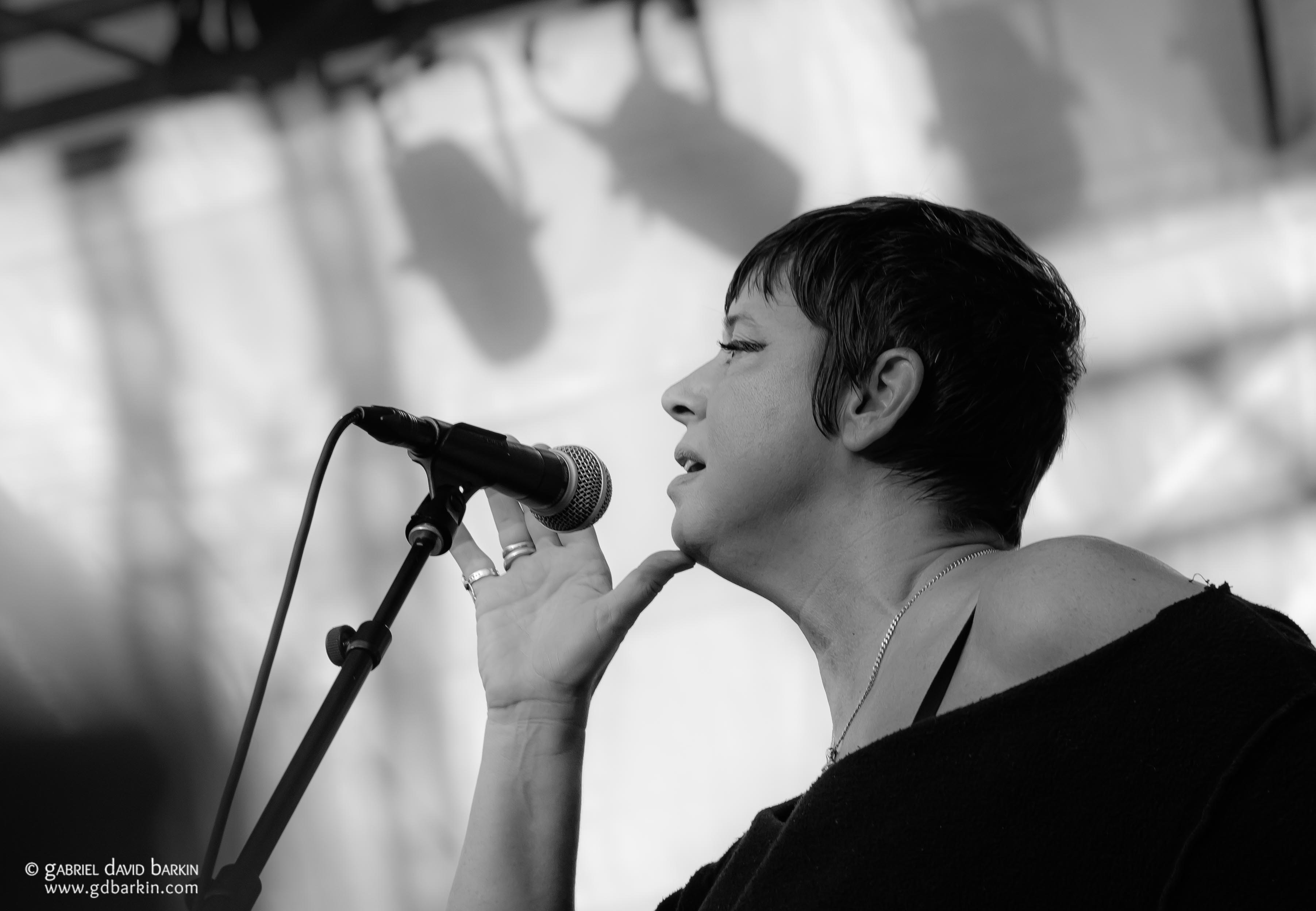
Then, like Dylan at Newport, she went electric. Backed now by two electric guitars, two keyboards, bass, and drums, she kicked into a higher gear. Power rocked out on “Baby Let Me Follow You Down” with a version akin to Dylan and The Band at “The Last Waltz” rather than Bob’s debut album folk rendition.
She got jazzy for “Just Like Tom Thumb’s Blues.” She invented her own phrasing (including some “Oh my God!” valley-girlisms) for “Ballad of a Thin Man.” Finding new ways to phrase Dylan songs is so Dylanesque!
Friday had delivered. The weekend was off to a running start.
HSBG by the Numbers – Interlude #4:
- Average daily attendance in recent years: anywhere between 35,000 to 250,000 people per day, depending on whom you ask.
- Age range of attendees: 0 to over 90.
- Number of stages in the inaugural year: 2.
- Number of stages in 2024: 6.
DAY TWO: SATURDAY, OCTOBER 5
Fridays are usually a bit lighter, crowd-wise, than the weekend. Saturdays and Sundays at HSBG can attract huge masses of humanity, depending on the weather, the lineup, and who’s playing whom on NFL television. This year, while Friday’s weather was warm, it wasn’t downright hot. But on Saturday morning, the thermometer was already at 80 degrees in the Richmond District of San Francisco by 8:30 am. For y’all folks who don’t live around here, I can tell you—that’s not “normal” in San Francisco.
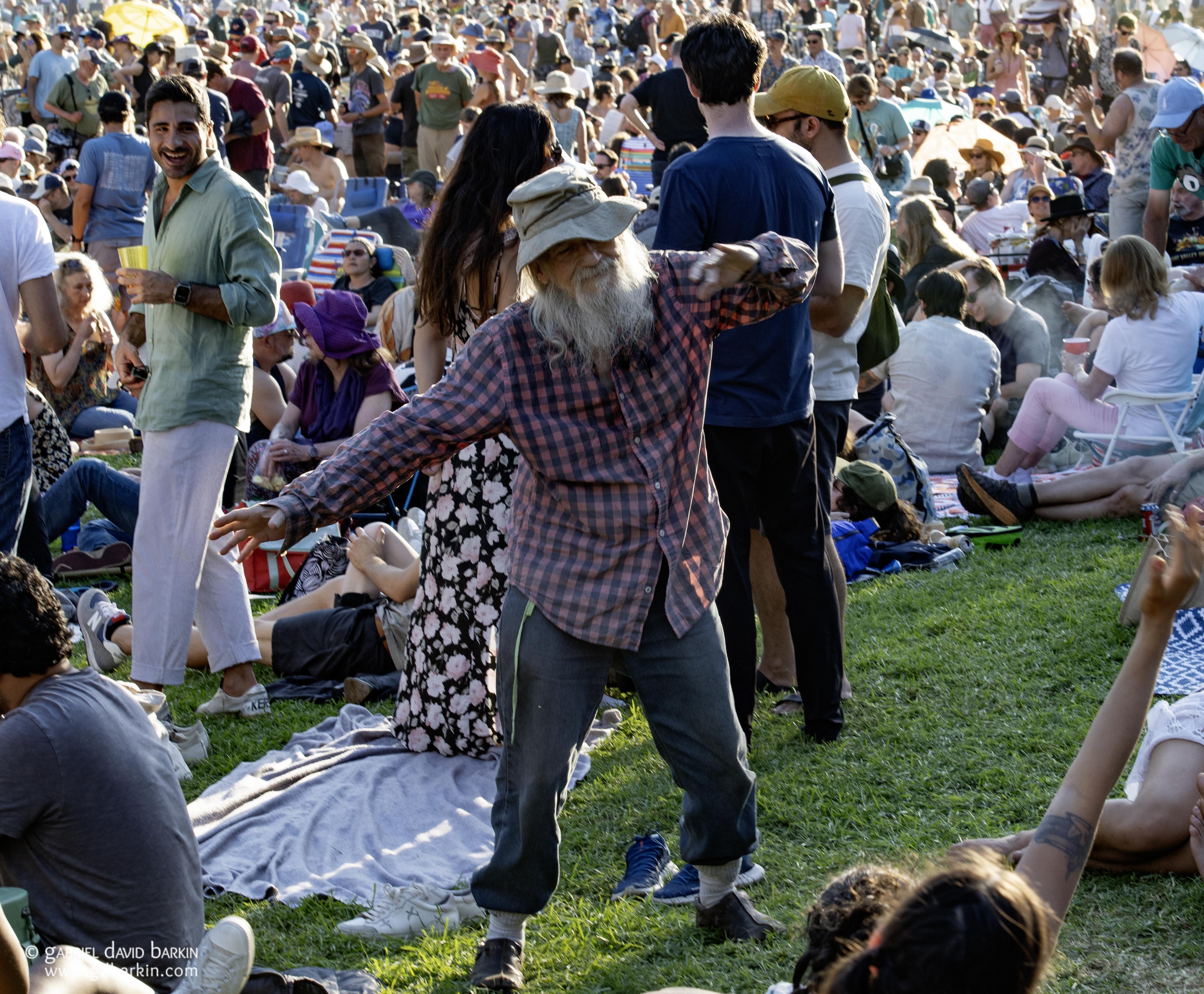
Perhaps the heat dissuaded people from making the trek to the park over the weekend, a silver lining on those sweltering, cloudless days.

The Swan Stage opened on Saturday morning with Levitation Room. The East LA quintet styles themselves as a '60s Brit psychedelic thing. Their songs are floaty and cosmic, with hints of Oasis and Vampire Weekend, kind of an alt-rock twist on the genre. Fun, high-energy stuff.
The Rooster Stage is in a narrow glen shaded at times by towering eucalyptus trees. While the Banjo Stage hews close to bluegrass, and the Towers of Gold and Swan Stages feature a wide range including rock and funk, the somewhat more intimate Rooster Stage is primarily dedicated to Americana and folk music. Buddy Miller, one of the premier conservators and promoters of both up-and-coming and well-established Americana performers, gets the keys to the Rooster Stage for one day each year to schedule a lineup they call “Buddy Miller’s Cavalcade of Stars.” Miller will invite some well-known artists, but he also gives slots to little-known acts who deserve to fly over the radar for a change. (Among my own discoveries at past “Cavalcades” is The War and Treaty, who won me over in about three seconds.)

The first “Cavalcade” act this year was a set by Emmylou Harris’s band The Red Dirt Boys. Untethered to Emmylou, the Boys hewed close to the folk and country roots that brought acclaim to Harris and Gram Parsons. Will Kimbrough (guitar) and Phil Madeira (keyboards) took advantage of their turn to shine and rocked the glen for a spirited thirty-minute set. Given the ilk who attends HSBG on a regular basis, it’s no surprise that a song named “Thank God for Weed” got big applause.
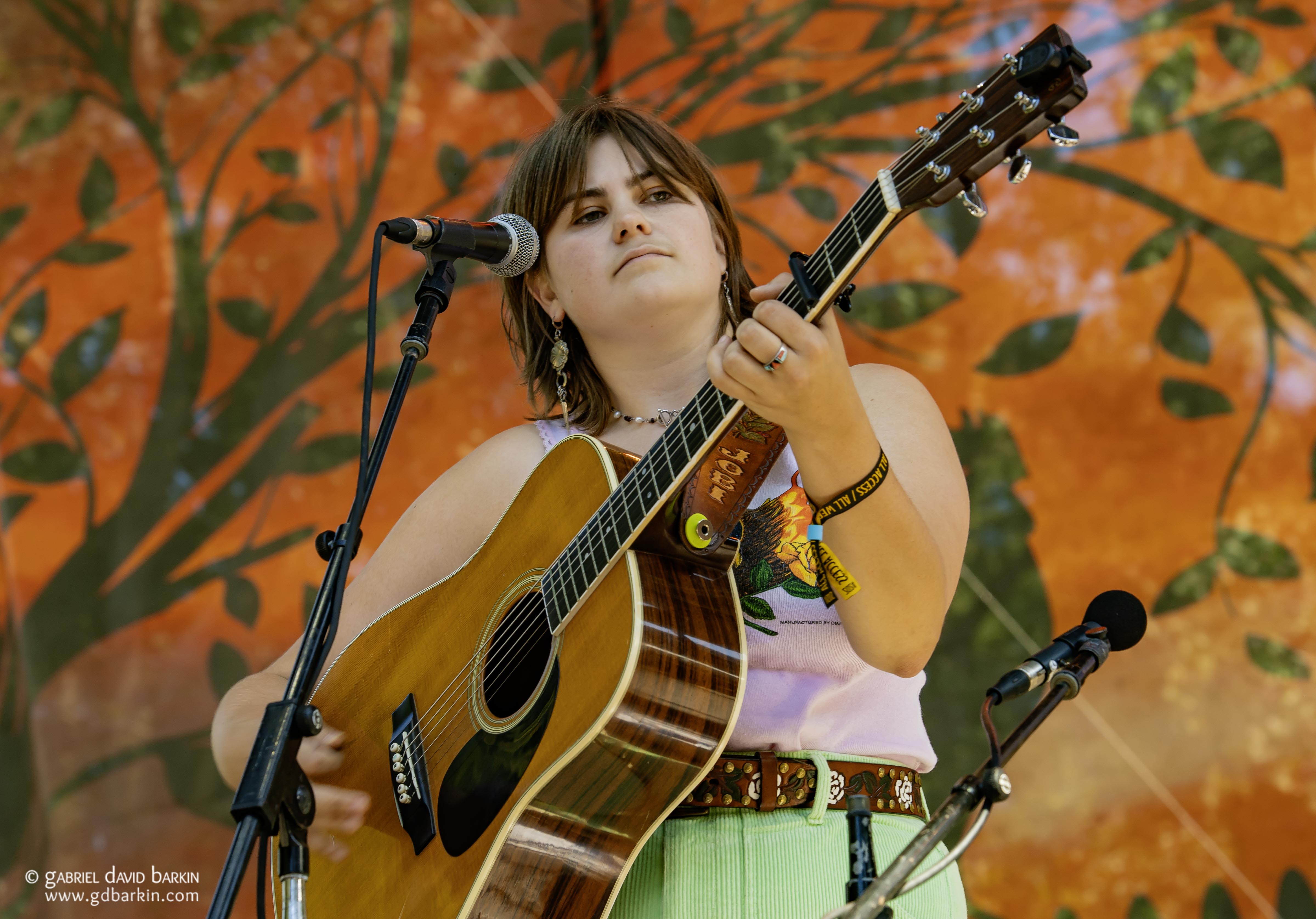
Next up in the “Cavalcade” was Jobi Riccio. The Denver, CO, native attended Berklee College of Music and has won numerous songwriter awards, including the 2023 Newport Folk Festival John Prine Fellowship. Riccio, playing an acoustic guitar and backed by bass and drums, impressed the audience with lyrics on songs like “Whiplash”:
I had a man he thought himself a cowboy
But cowboys are supposed to be brave
And he went running off like a coyote
Running with his tail between his legs
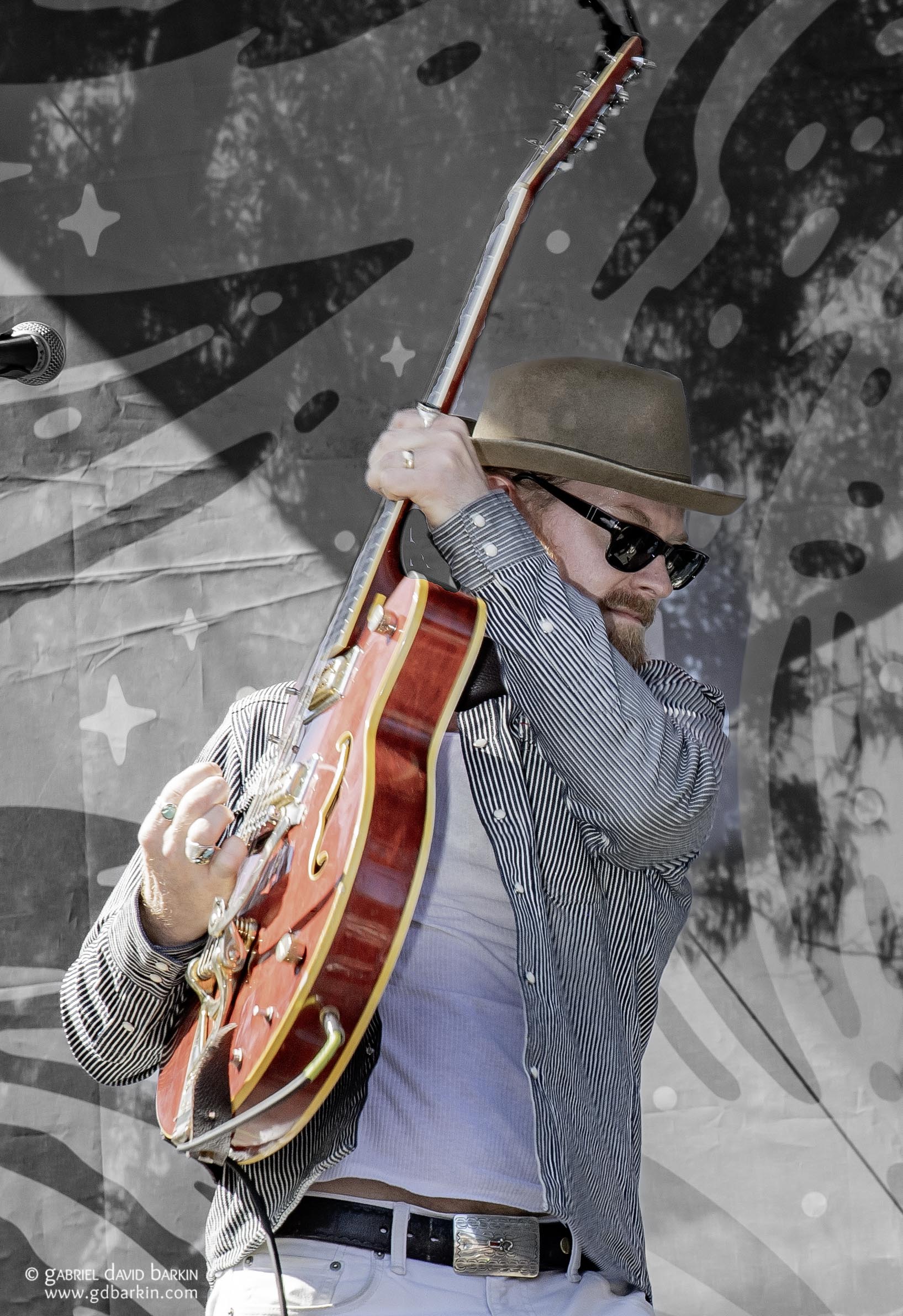

Back at the Swan Stage, Fruition was having fun with a lively and joyful set. The sorta folk, sorta rock, sorta soul band from Portland, OR, is centered around the voices and songwriting talents of founding trio Jay Cobb Anderson (guitar), Kellen Asebroek (guitar, keyboards), and Mimi Naja (mandolin and guitar). The three reminisced on stage about busking in the park with guerrilla sets during the early days of HSBG. (They later recreated that magic with a surprise pop-up set along one of the trails between stages.)

Fruition fans sang along to songs like Naja’s “I Should Be (On Top of the World).” (Sample lyric: “I’ve been sweet, I’ve been stupid, I’ve been salty, sour and putrid.”) Naja and Anderson frequently faced off with their dueling stringed instruments, grinning with obvious affection for their longtime musical partners.
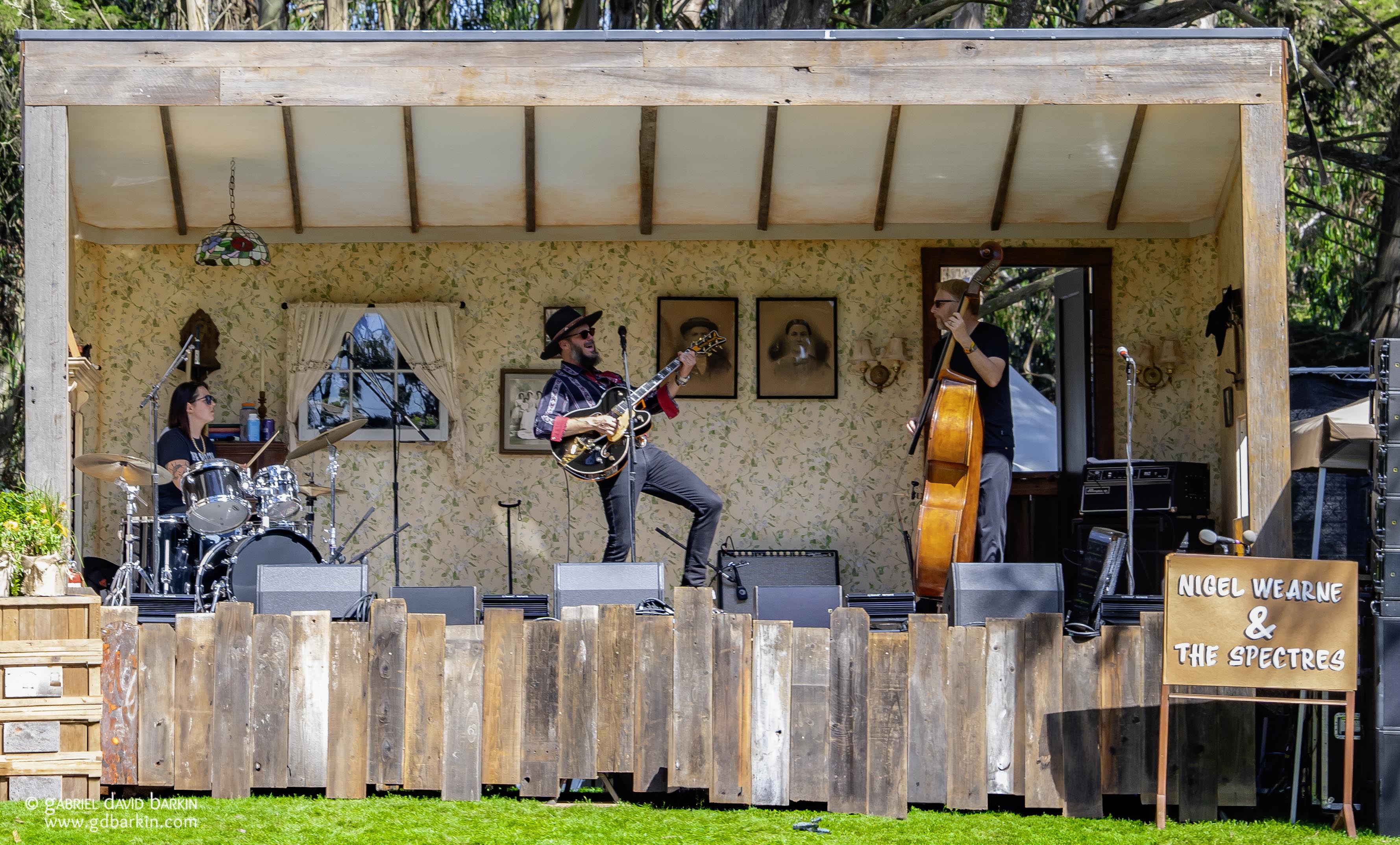
My wife and I sought refuge from the heat at the shady Horseshoe Hill Stage. We were not alone making the call to do so; it was packed to the gills up there, every inch of shade filled by humans (and occasionally, their dogs). Even so, we found a spot to chill by the back fence. There we caught a few songs by Aussie guitar player Nigel Wearne & The Spectres. His twangy licks were giving Django Reinhardt with a cowboy twist.
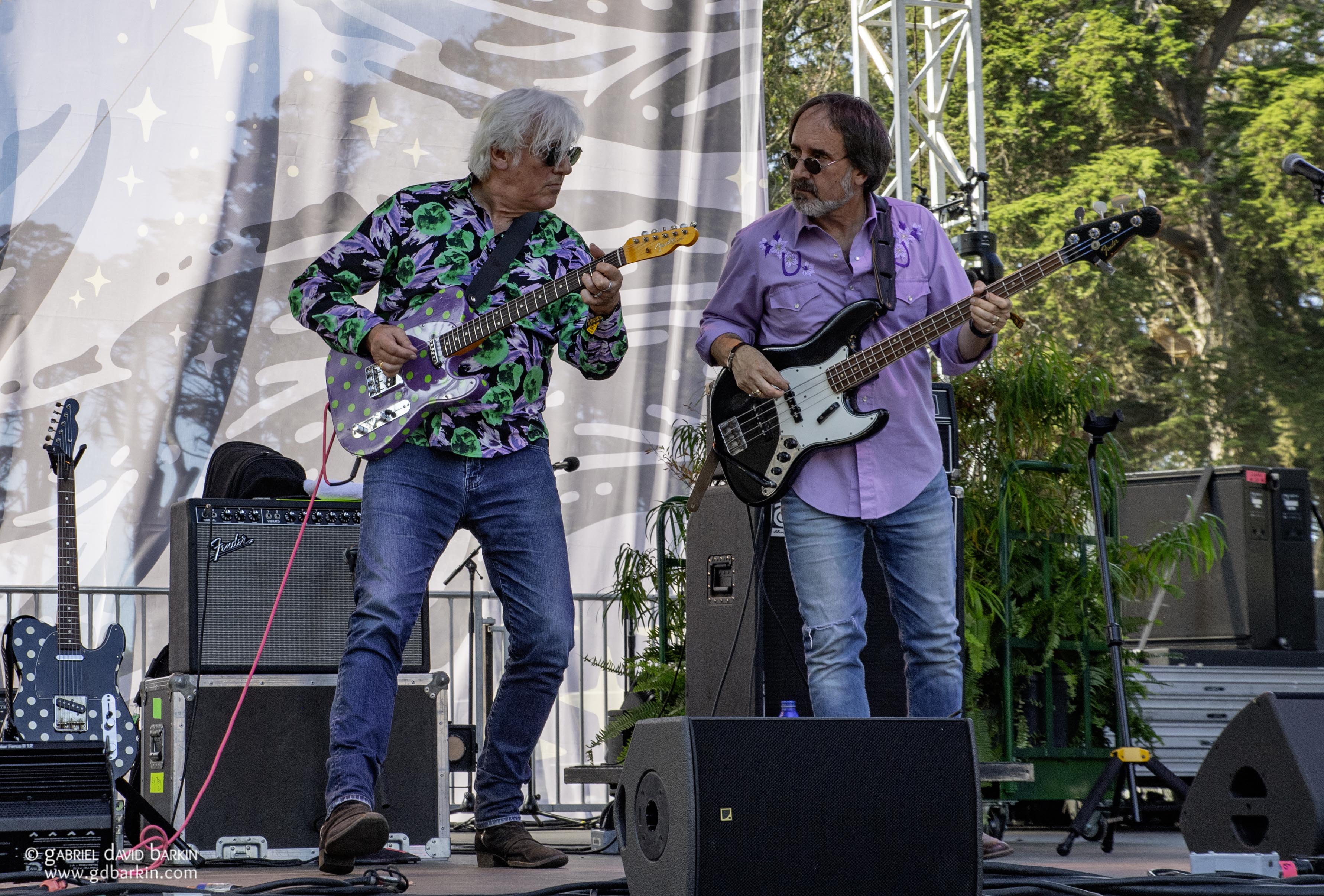
Shortly after, it was '80s new wave star Robyn Hitchcock’s turn on the Swan Stage. With more than half a dozen HSBG appearances under his belt, Hitchcock has earned a semi-regular slot at the festival, but this was the first time I caught his act. Looking very '80s-ish in green and purple, Hitchcock paid tribute to an even earlier era with covers of Syd Barrett-era Pink Floyd (“Astronomy Domine” and “See Emily Play”) and the Kinks (“Waterloo Sunset”). Two Beatles covers also made the set.
For the new wavers in the house, Hitchcock spoke lovingly of the Police’s Stewart Copeland and his influence on chorus-heavy guitars of the early '80s. He threw in a few songs from his own discography with The Egyptians as well, including "Madonna of the Wasps" and “Heaven.”
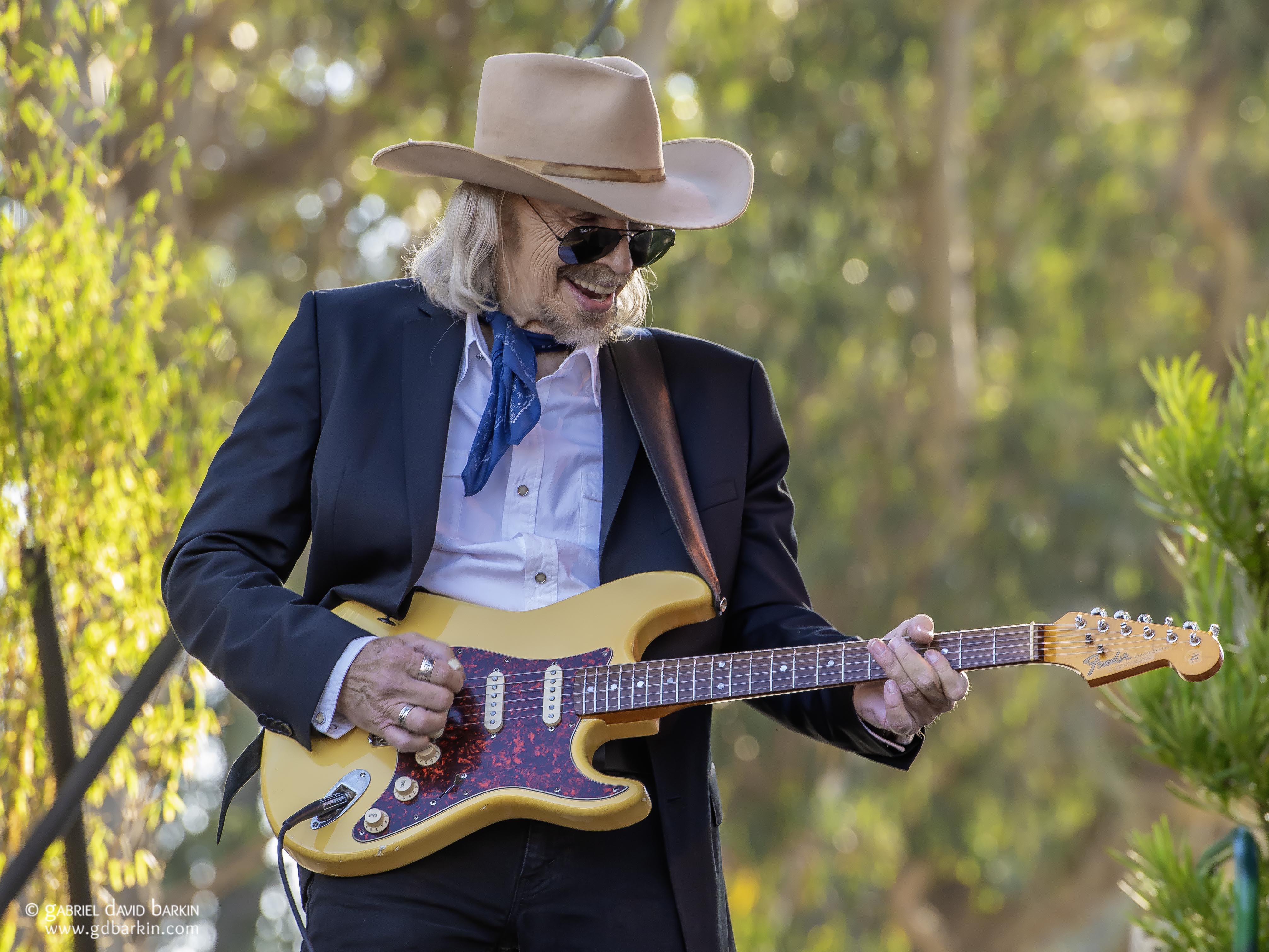
An hour later, the Swan Stage hosted Jimmie Dale Gilmore and Dave Alvin. Backed by The Guilty Ones, Alvin and Gilmore focused on songs from their 2024 collaboration TexiCali. (Gilmore is from Lubbock, TX, and Alvin from Downey, CA.) Dressed in cowboy couture, the songwriters alternated on vocals, and Alvin traded honky-tonk guitar leads with Chris Miller while Brad Fordham (bass) and Lisa Pankratz (drums) provided the rhythm.
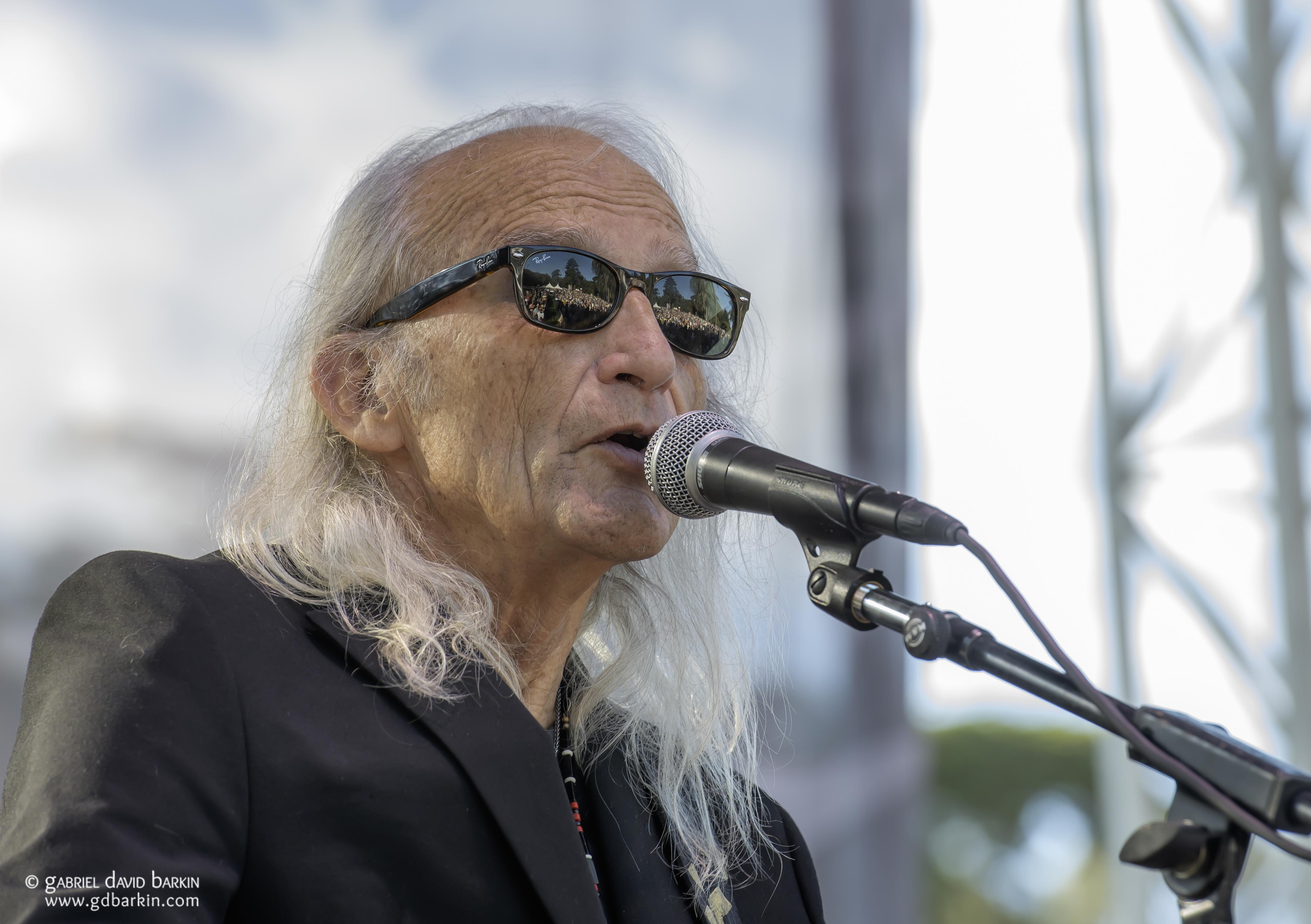
Among the tracks from the new record were the apt “We’re Still Here” and “Blind Owl.” Gilmore also reached deep into his own catalog for a rendition of “Dallas.” A cover of the Youngbloods’ “Let’s Get Together” got the audience singing along on the slightly altered, gender-neutral chorus: “C’mon people now, smile on each other.”

My first exposure to Dave Alvin was when Queen invited the Blasters to open a few shows on their 1980 tour, and I sat in the seventh row with my jaw dropping while rockabilly Alvin brothers Dave and Phil tore up the joint. On the Swan Stage Saturday, Dave introduced a Blasters song, “Long White Cadillac,” with a nod to his brother: “My brother Phillip says he sings this better than me. And Dwight Yoakam says the same thing. But it’s my fucking dog. I wrote it and we’re gonna take my puppy out for a walk.”
Alvin also sang another Blasters song, the barn-burning “Marie, Marie,” to close the set.

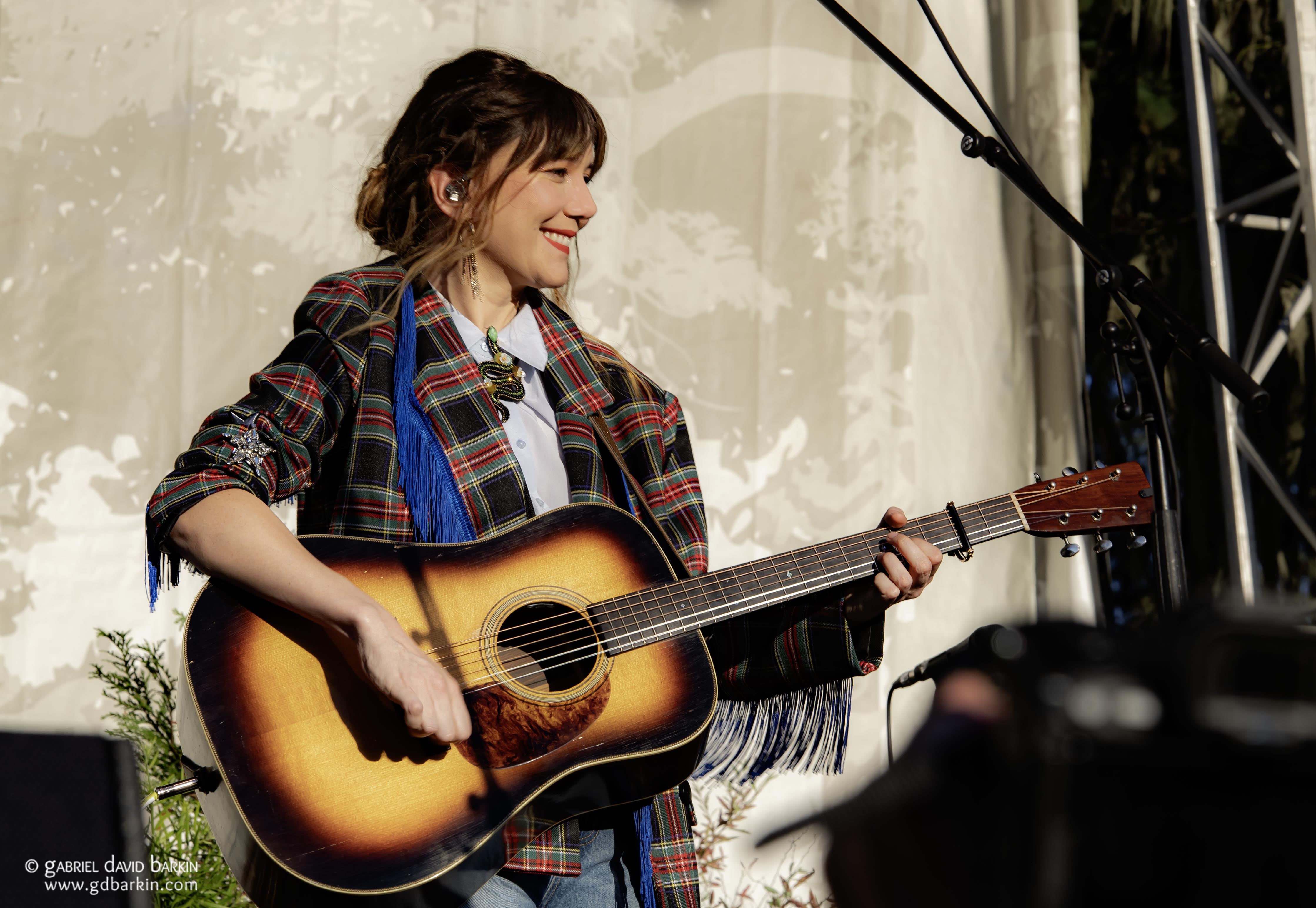
By this point, roughly midway through the entire festival, I had not seen a single bluegrass performance. I headed over to the Banjo Stage to catch the beginning of Steve Earle’s set backed by Molly Tuttle & Golden Highway. To kick it off, Earle invited an octet of members of the extended Hellman clan to sing some a cappella verses. The rest of the set was a mix of traditional bluegrass and songs from Earle’s catalog (including, for the faithful, his hit “Copperhead Road”), with frequent solos by Tuttle and her band.
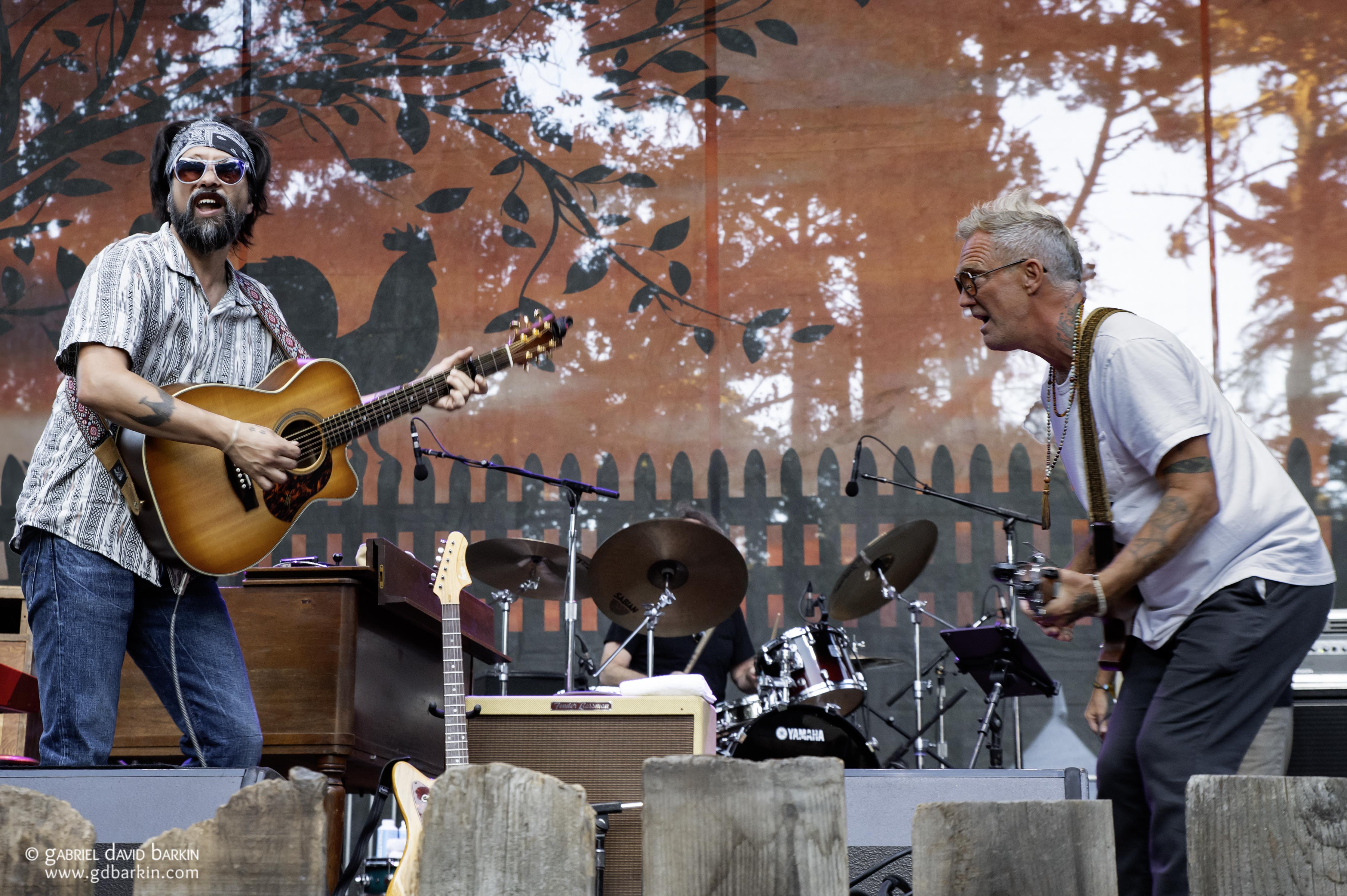
Unfortunately, I can only be in one place at a time, and I was compelled to tear myself away from the Banjo Stage to try to catch some Greensky Bluegrass back at Swan. On the way, I heard the introduction for Anders Osborne and Jackie Greene over on Rooster, so I detoured to spend a few minutes watching California native Greene and New Orleans denizen (and transplant from Sweden) Osborne blend their musical genius. Greene played organ for Osborne’s “Burning on the Inside,” and then he grabbed an acoustic guitar to sing “Don’t Let the Devil Take Your Mind.” Again, it was hard to leave, but I was on a mission.
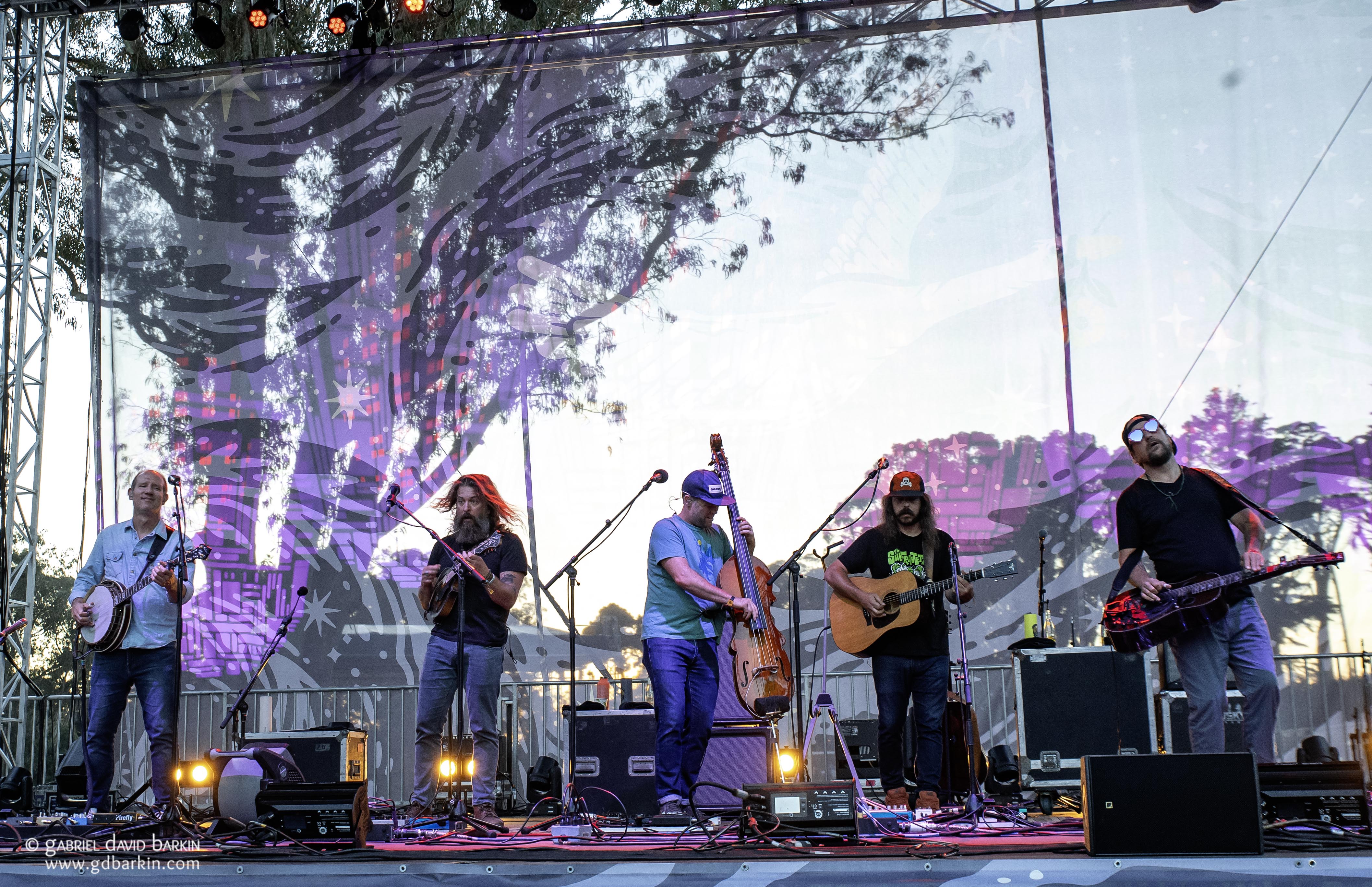
And yes, I had seen Greensky play two sets the night before at the Fillmore. But I still hadn’t got my fill of those guys. Notably, this was the first time I saw them this year (including the previous night) when master pianist Holly Bowling was not on stage as a de facto sixth member of the band. Bowling adds a truly divine, sophisticated, and tasty element to Greensky’s newgrass sound, but it was also nice to hear them without her accompaniment for a change.
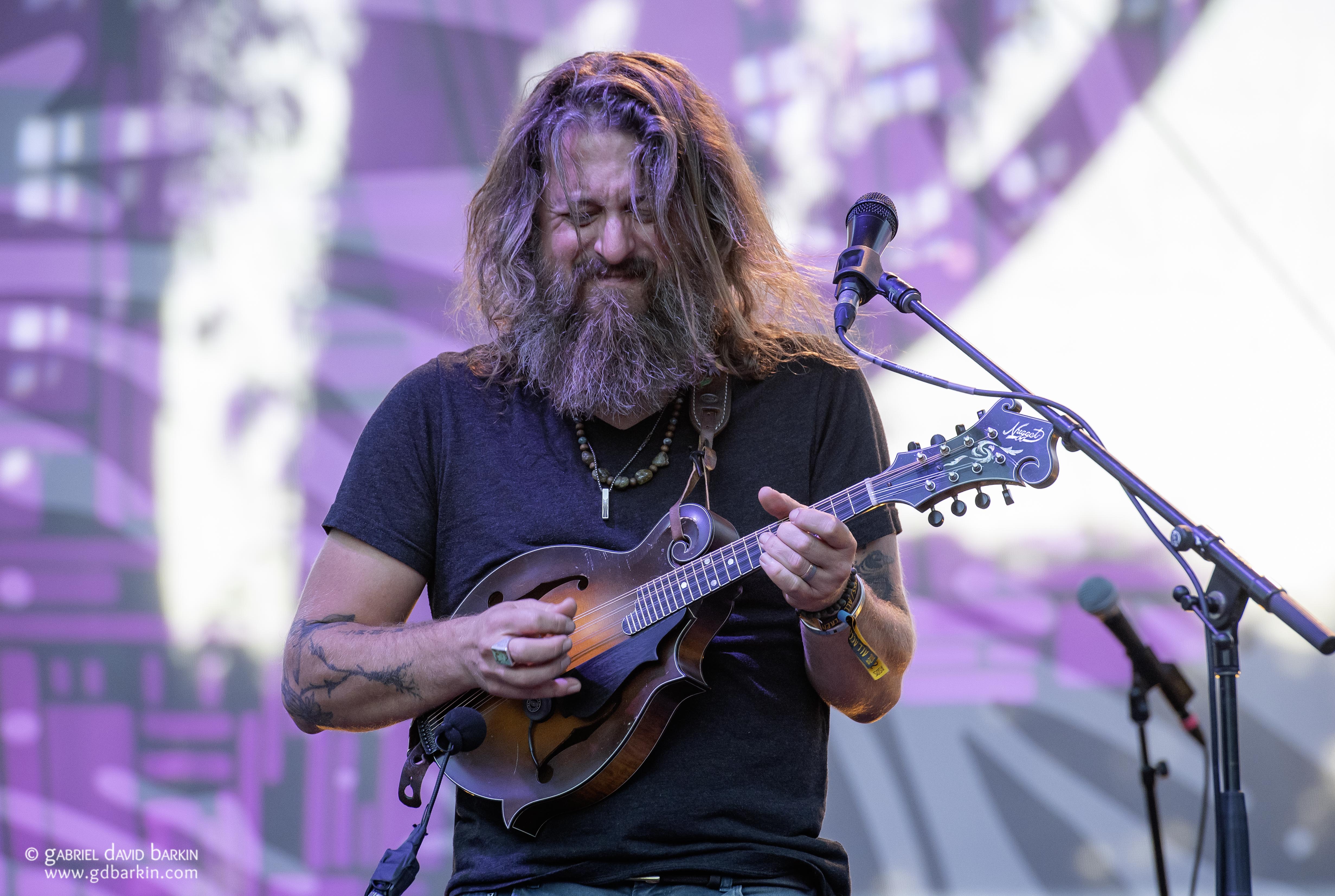
I arrived halfway through the set to hear the last refrain of “Living Over.” With the light fading, Greensky played for another half hour as a psychedelic light show wafted over them. After a closing jam on “Kerosene,” the audience refused to leave. Following a minute or two of avidly chanting “One more song!” the crowd was rewarded with a true HSBG rarity: an encore! Greensky returned for a quick take on “Worry for You” to end the second night.
HSBG by the Numbers – Interlude #5:
- Number of beer stands: officially 0. It's BYOB, but (shhhh!) guerrilla beer vendors abound.
- How many dogs are allowed in: all of them, as long as they’re leashed. (I brought my dog once, but I regretted it. Turns out he was not a big crowd fan.)
- How many children are allowed in: all of them, and most are kept off leash.
DAY THREE: SUNDAY, OCTOBER 6
Most longtime HSBG attendees have heard that Emmylou Harris does a soundcheck at the Banjo Stage early on Sunday morning. Still, it’s an intimate affair. Perhaps 500 people show up for it each year. Most are there to put their tarps and blankets and chairs close to the stage for the day, and the Harris soundcheck is an added bonus, a well-earned reward for showing up early to grab land for friends and family who will show up later.
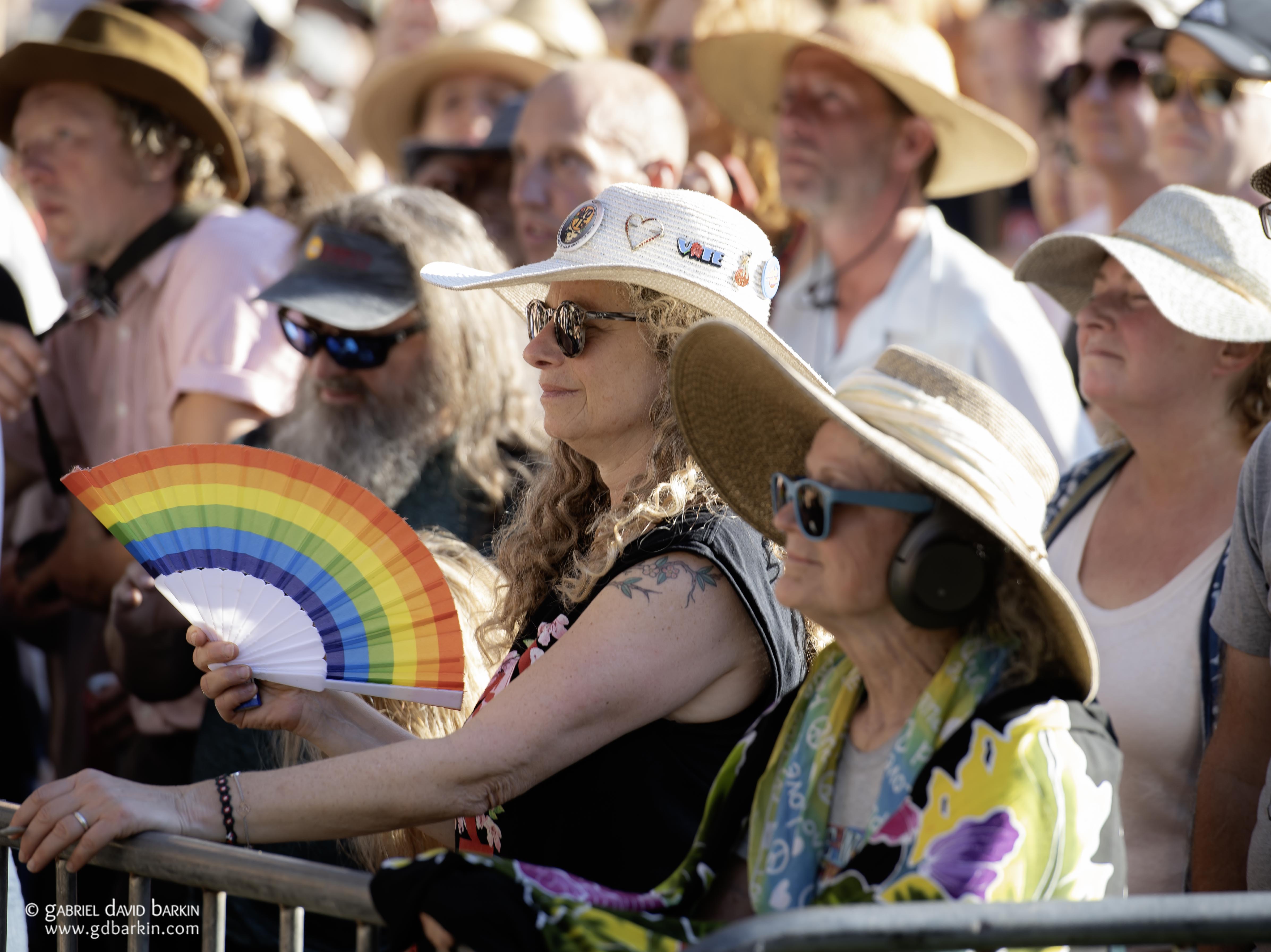
As I walked toward Banjo just before 9 am, I ran into a friend and said, “I’m heading over to Banjo now to see Emmylou do her soundcheck.”
He said, “Oh yes, church.”
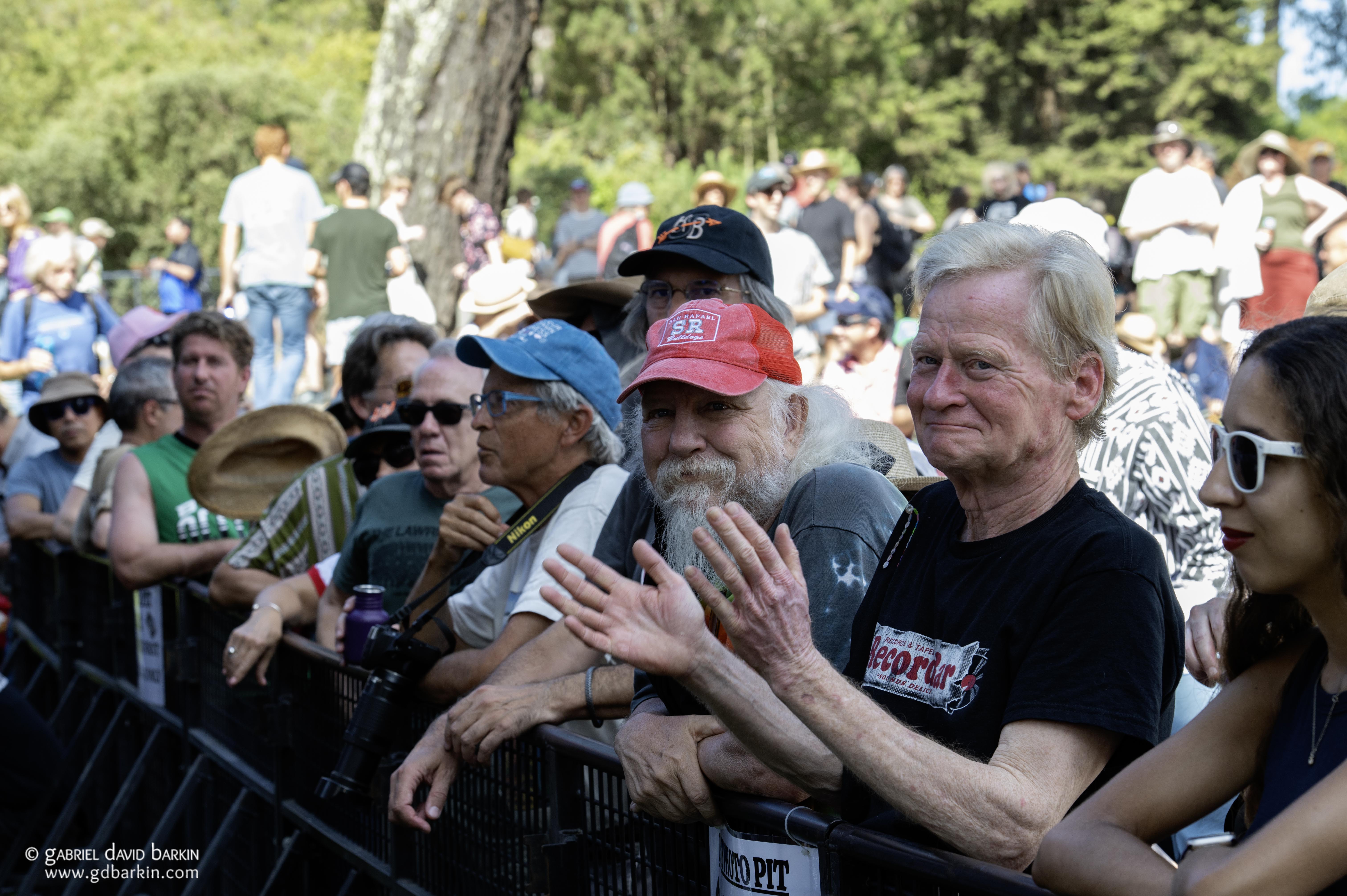
With my photo pass, I had the opportunity to get in just before the gates opened, so I got to see “the running of the tarps” at Banjo just as Harris was beginning her soundcheck. Those of us who know the drill also know that Harris prohibits photos during the short morning session. Security people walk through the crowd each year asking people to put their cameras and even their cell phones down. Fair trade—we get to hear something special, and Harris doesn’t see the internet flooded with pics of her sans makeup. I asked a member of her production team for permission to take a photo of people laying down their tarps in front of the stage with a promise that her face would not be recognizable.
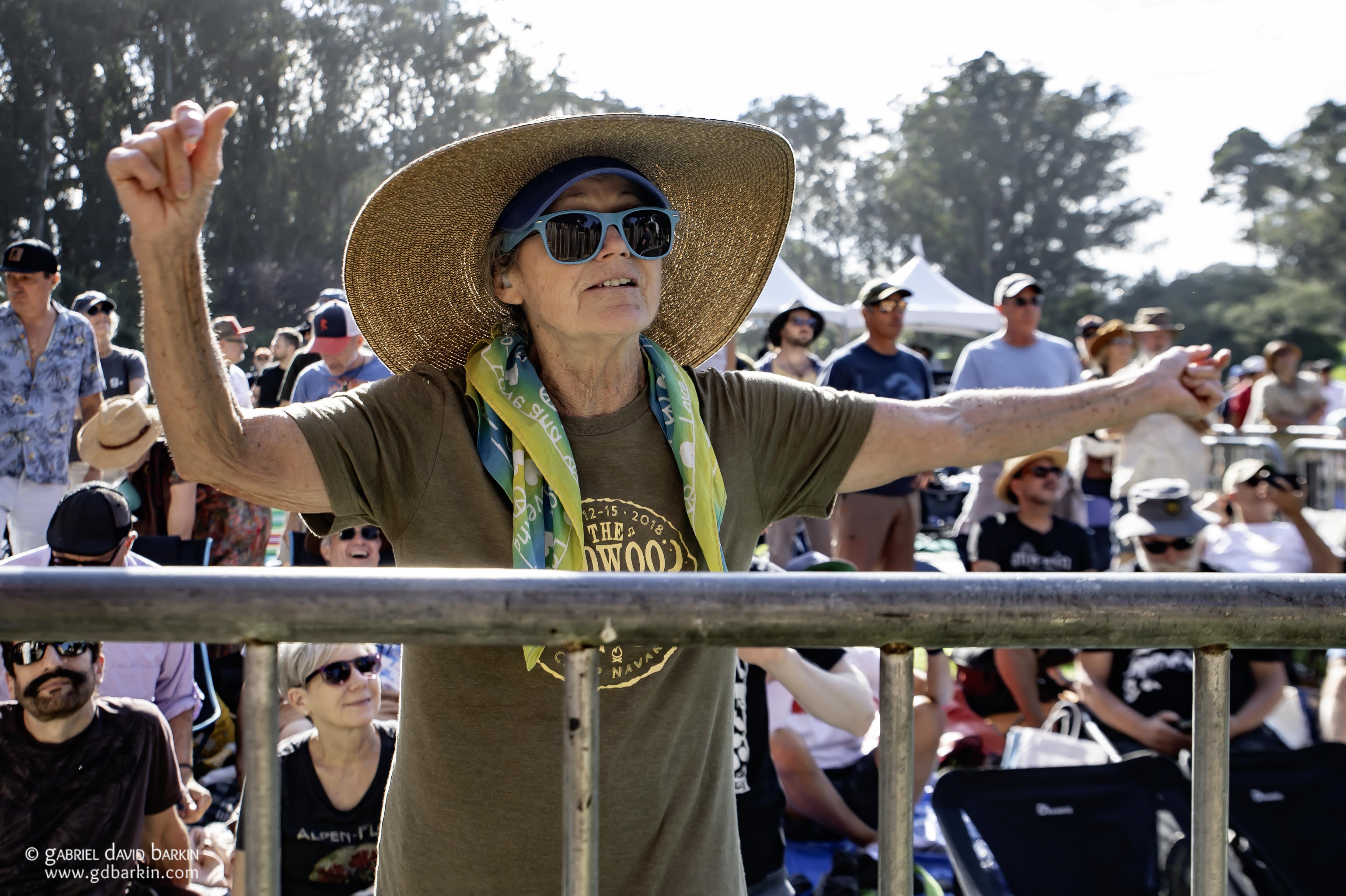
Harris made the audience swear not to tell anyone else what songs they were rehearsing—but that was two days ago now, so I’m free to spill the beans. She played snatches of “Red Dirt Girl,” “Get Up John,” and “Tulsa Queen,” among others. Typically, Harris and the Red Dirt Boys only run through about half of each song they play at the soundcheck, mostly to warm up and get their monitors right, etc. On Sunday this year, Harris signaled the band to stop each rendition by throwing her arms out like an ump calling a runner “Safe!” at first base.
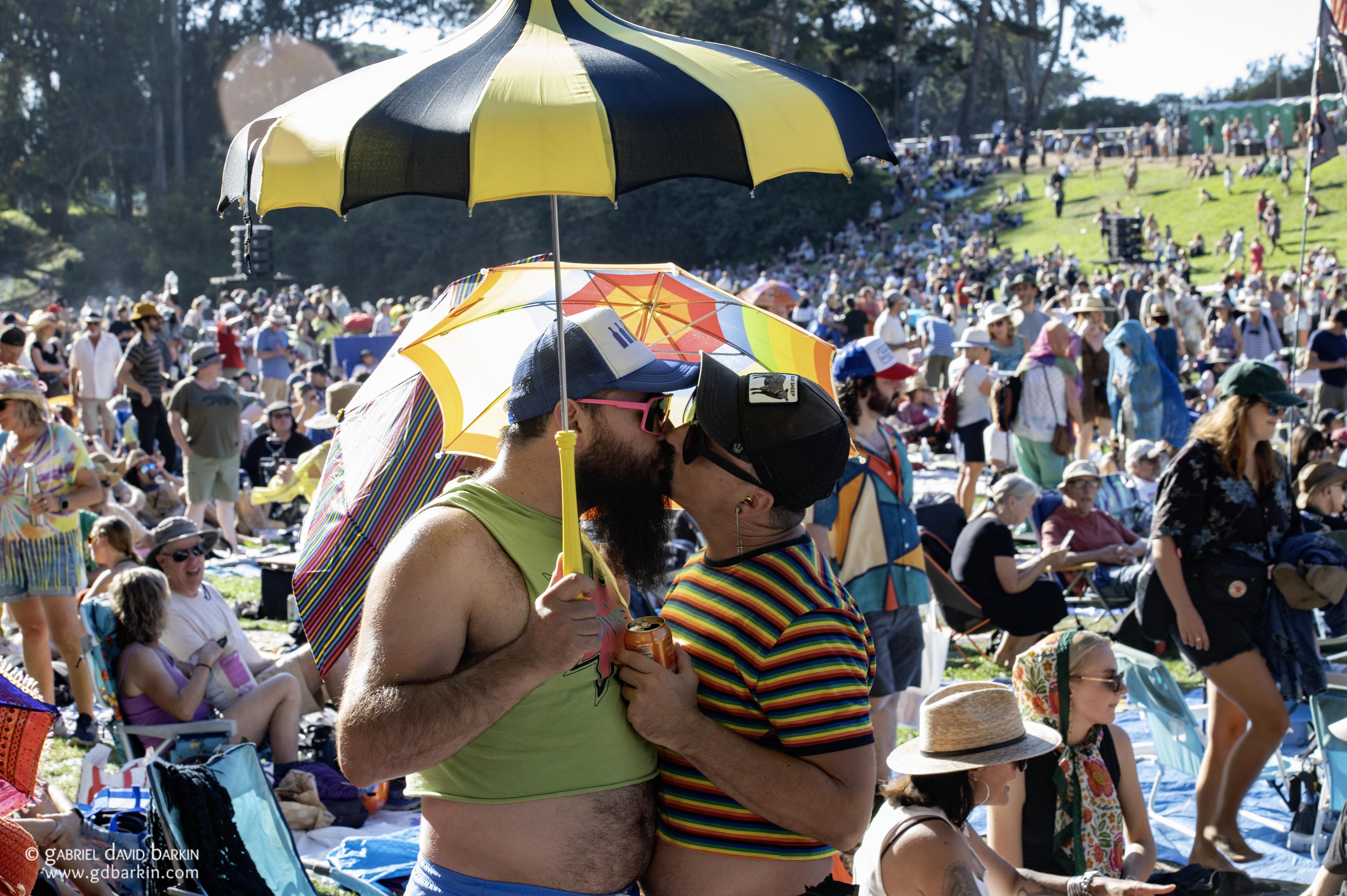
More than once, she commented to the crowd after playing half a song with asides like, “To be continued.” Toward the end of the 35-minute stretch, she said, “You’re sworn to secrecy, right? Well, it seems like you folks show up every year, so I’m trying to do something different.” She treated us to almost all of “Return of the Grievous Angel,” the Gram Parsons song that was, for many people, the first time they ever heard Harris sing. There was also a bit of a cappella singing to get the mics right. Then she headed off to breakfast and presumably, eventually, the makeup table.
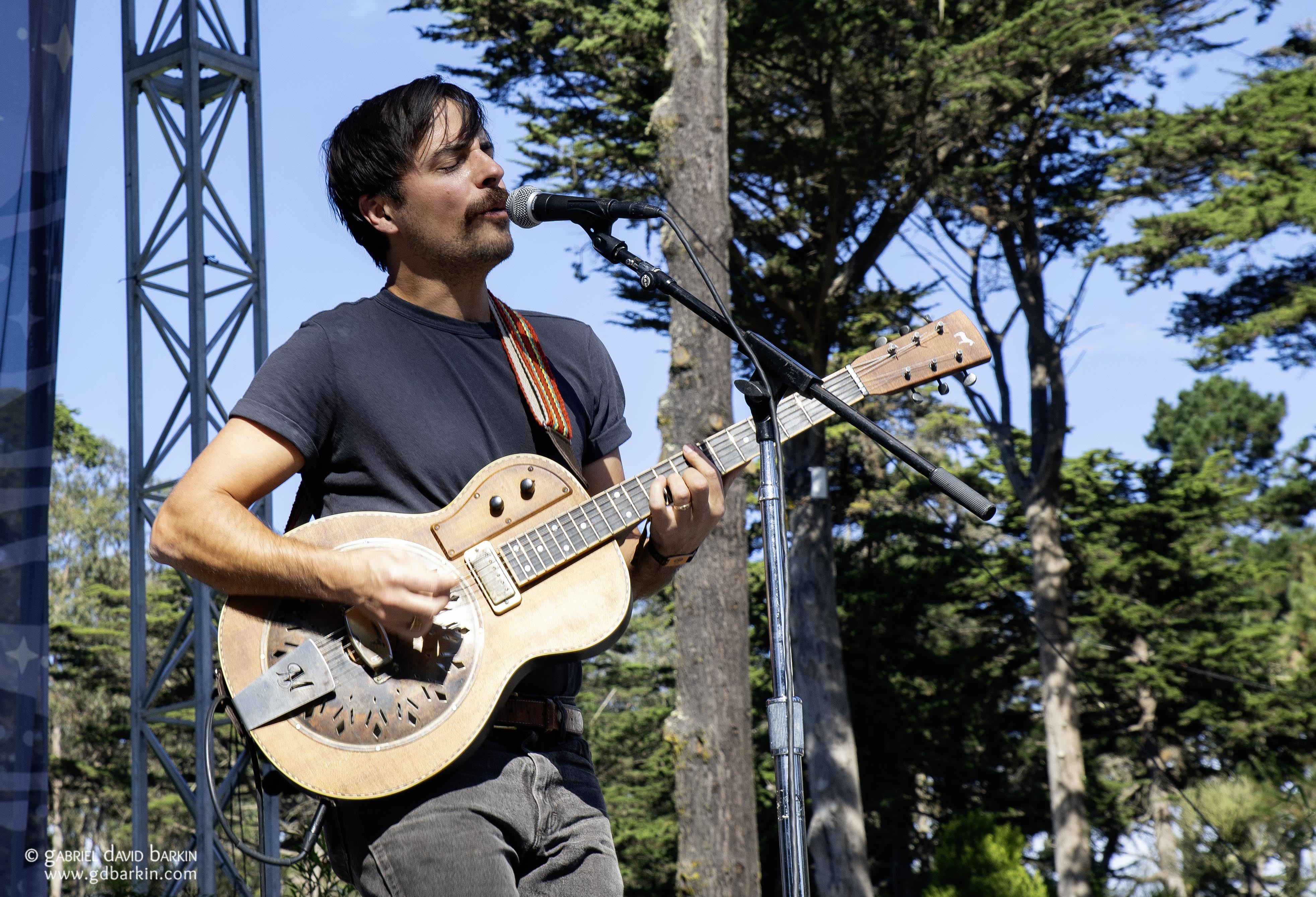
Festivals are often a great opportunity to discover new music. For me, the biggest find at HSBG this year was The Bones of J.R. Jones. Upstate New York songwriter Jonathon Linaberry got his start playing in hardcore and punk bands before becoming enamored with gospel, folk, and blues. The Bones of J.R. Jones is a Linaberry solo project in studio, but on stage he brings a drummer (Jeremy Kolker). At first glance, it’s easy to compare the duo to the Black Keys, especially in the latter’s early years. And yes, they both travel roads well-paved with the blues—but the comparison ends there. Linaberry’s voice is more like Sturgill Simpson’s, soft yet strong with a bit of tremolo. And not all of the songs are raucous blues.
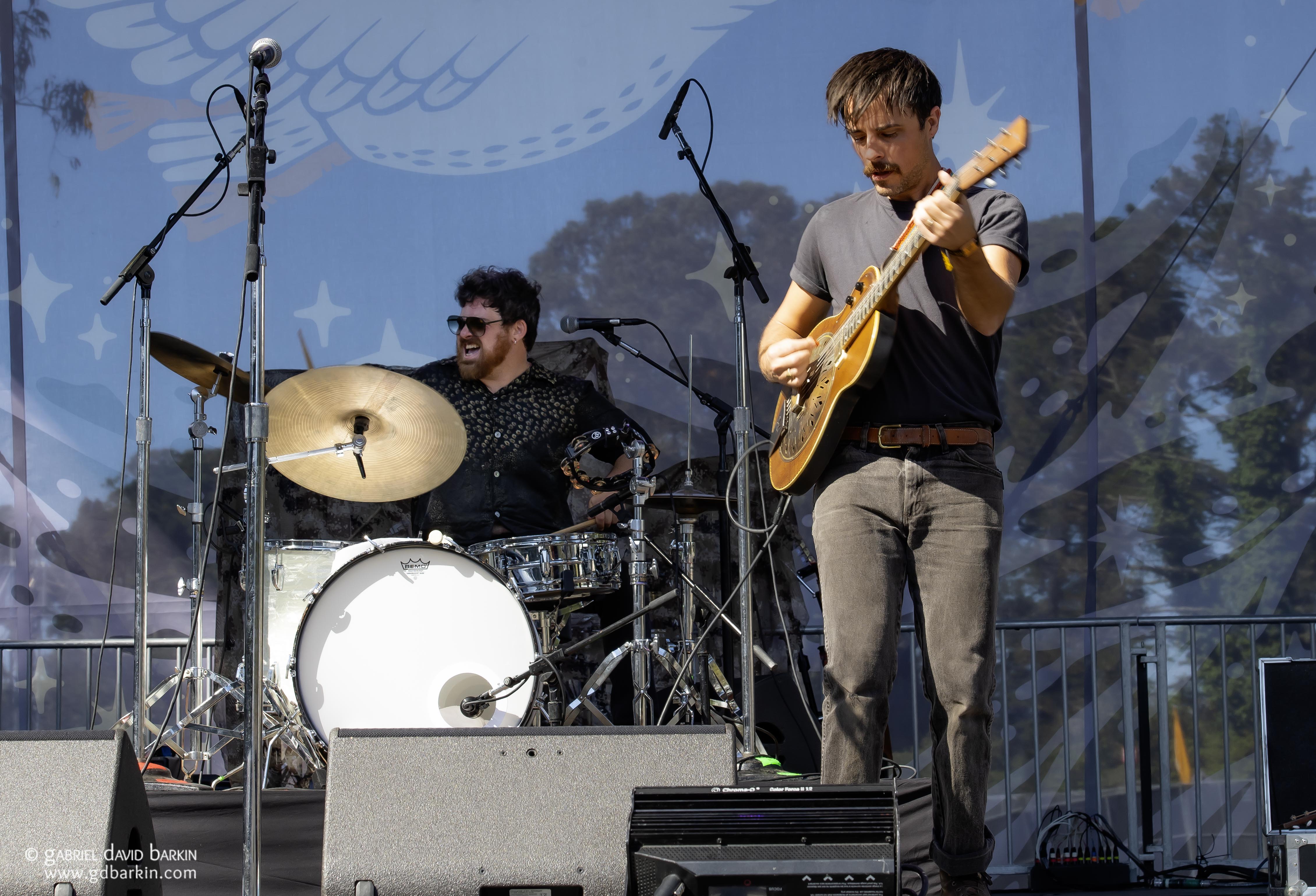
A standout in the opening set on the Swan Stage was “Animals,” which featured an audience singalong at the end on the lyric, “I wanna be your animal at night.” Linaberry framed his request for audience participation this way: “I used to be a preschool teacher, so I like singalongs.” He also gave away his age a bit (he’s 42) by reminiscing about the first cassette tape he ever owned. “I had to wind it up with a pencil.” That was his introduction to Bruce Springsteen’s “My Hometown.”

The Bones of J.R. Jones was a great back-to-back pairing (literally, both in terms of scheduling and stage placement) with Cedric Burnside. The Memphis-born blues singer and guitar player, accompanied on bass and drums, crushed it on the Towers of Gold Stage with his traditional Delta blues set. Burnside’s guitar picking is in the timeless vein of his idol Hound Dog Taylor and other pioneers like John Lee Hooker. He certainly earned the sweat beading on his brow in the morning sun! (It was already in the 90s.)
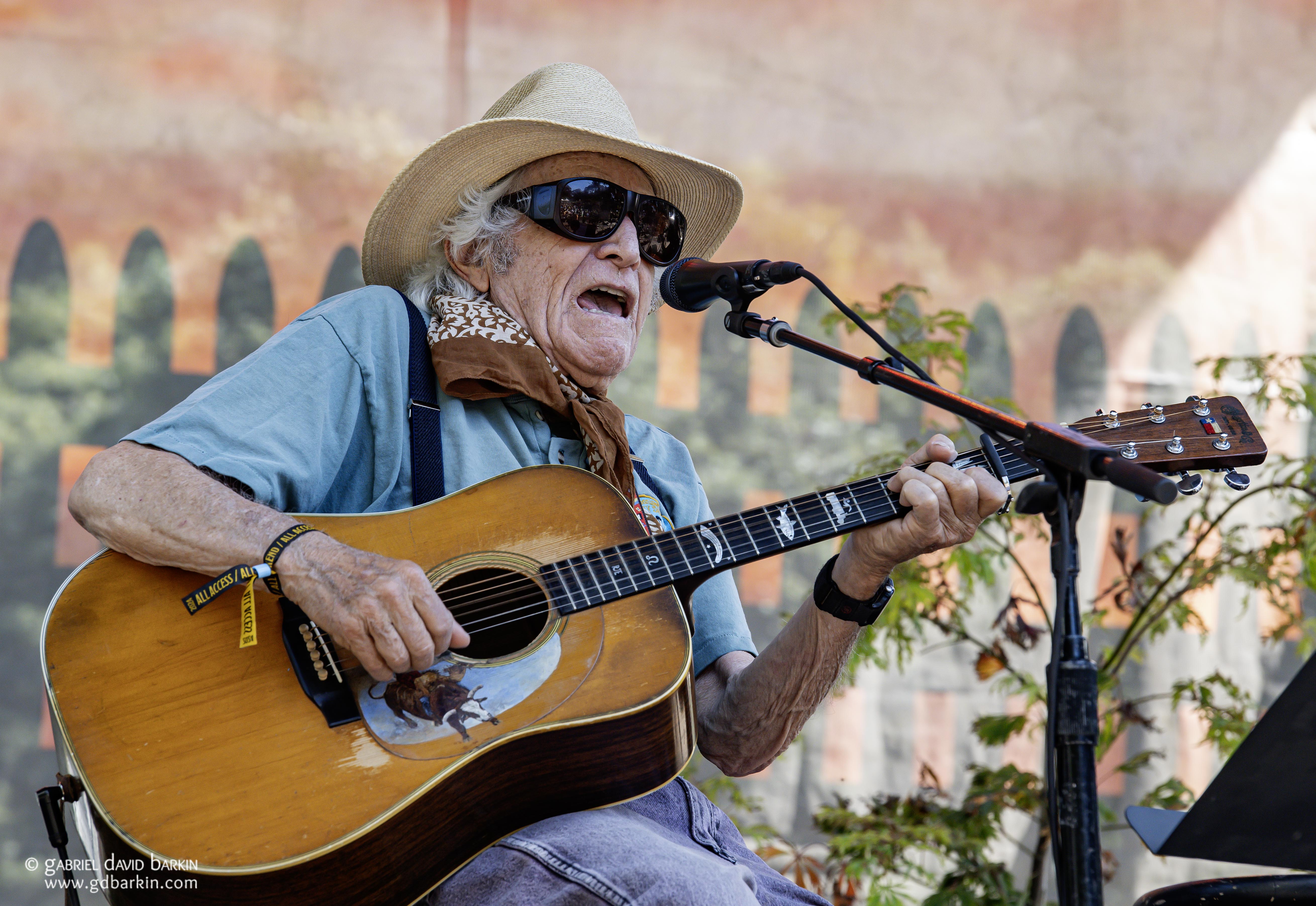
Among my personal don’t-miss acts of the weekend was Ramblin’ Jack Elliott. They say, “Never miss a Sunday show”? Well, I say, “Never miss an opportunity to see anyone in their 90s who still has the mojo to take the stage.” At 93, Elliott is an institution. He opened his all-too-short set with “Waiting for a Train” by Jimmie Rodgers. Next was “1913 Massacre,” a song by Elliott’s friend Woody Guthrie. And of course, Ramblin’ Jack had a bit of ramblin’ to do first. “Woody was born in 1912, and the 1913 massacre was in 1913, so he was only one year old when he wrote this song.”
Elliott played an acoustic guitar, accompanied by acoustic bass and mando-guitar. Bass player Banana said at one point, “I want to thank Jack at 93 years old for getting his ass down to GG Park.” That triggered Elliott to ramble about a trip he made to the Bay Area when he was young:
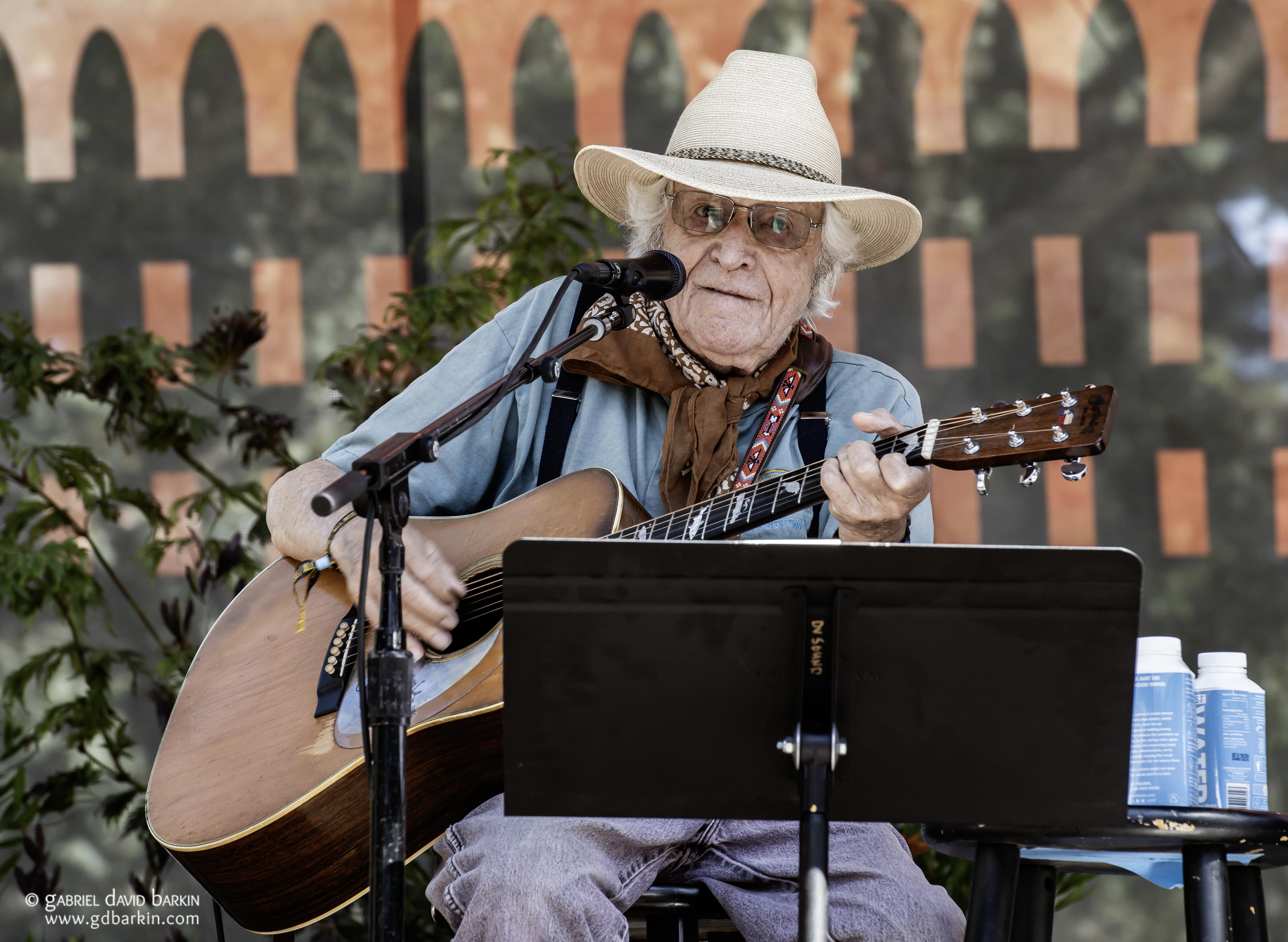
“Pete Seeger did a great show at a store in Sausalito—although I missed half of it because I fell asleep after hitchhiking up to SF. While I was here, I saw Jesse Fuller play.” Elliott’s delightful freight-train-of-thought chugged on. “I got to go on a tour with Jesse. We were in London. You know, the traffic was going the wrong way. Jesse stepped into the street without looking. He had a guitar on his shoulder. I grabbed him and gave him a light shove back. Jesse said, ‘That’s okay. I got insurance.’” Elliott might have gone on a-ramblin’ even further, but Banana whispered in his ear that time was running short.
To close the set, Elliott invited Steve Earle to sing the former’s “912 Greens.” Before turning the mic over to Earle, Elliott said, “This is a song I allegedly wrote. It may be the only song I ever wrote.”

Earle had performed his version of “912 Greens” earlier this year at a tribute to Elliott in San Francisco. This time, Elliott sat at his side interjecting from time to time while Earle spun the tale his own way.
Harking back to his high school days, Earle mused, “My hobby was turning cowboys into LSD—so when I discovered Ramblin’ Jack, he made perfect sense to me.” The two legends hugged when it was over.
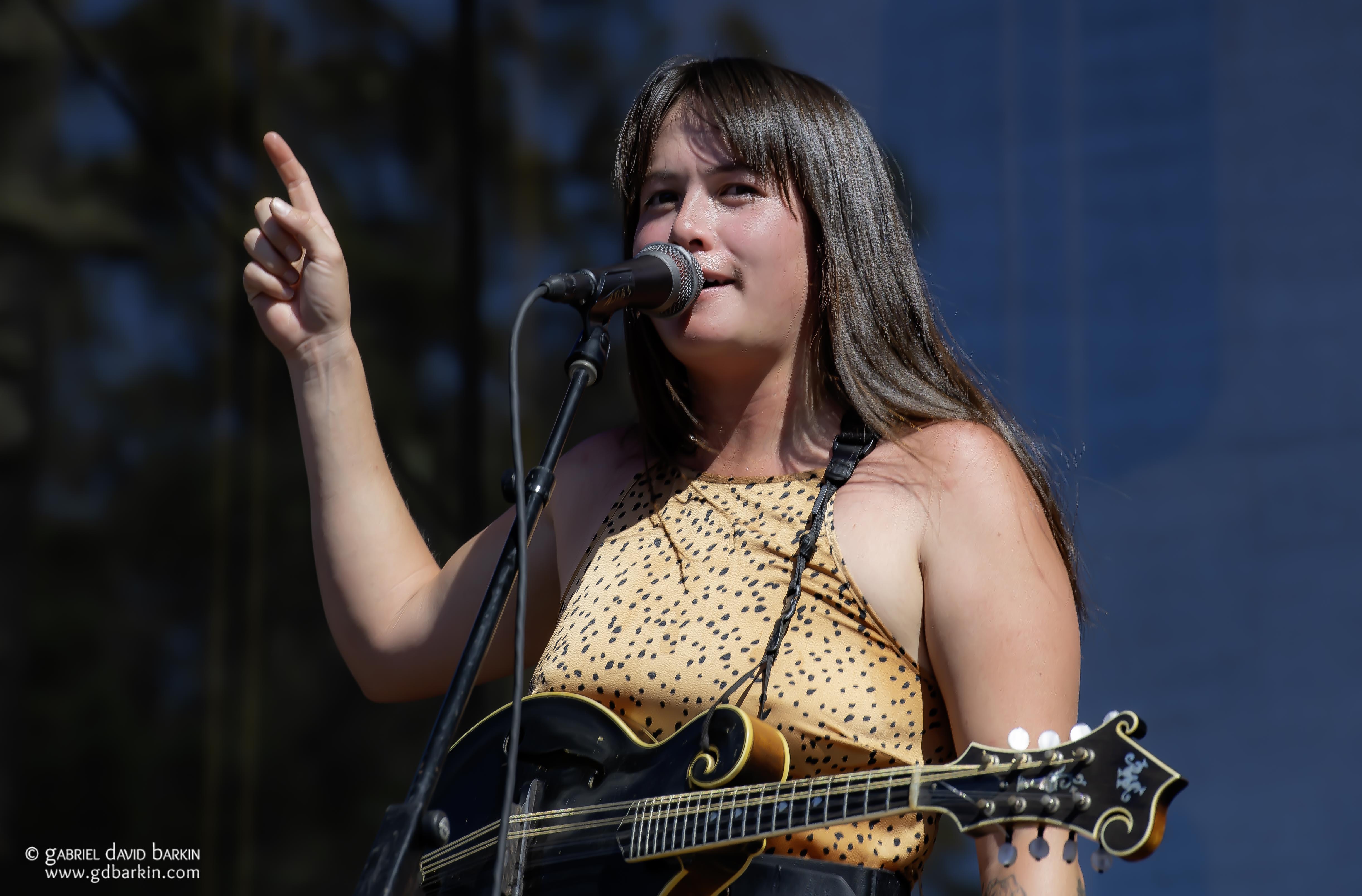
I hustled back to the Towers of Gold Stage next for some bluegrass by Santa Cruz’s AJ Lee & Blue Summit. Covers of “He Called Me Baby” (quite soulful) and The New Riders’ classic “Glendale Train” fit in nicely with Lee’s own “Lemons and Tangerines” and other originals by Blue Summit’s two stellar guitar players Scott Gates and Sully Tuttle (yes, he is Molly’s brother). The sun was beating down furiously on the band, but they sweated it out like pros.
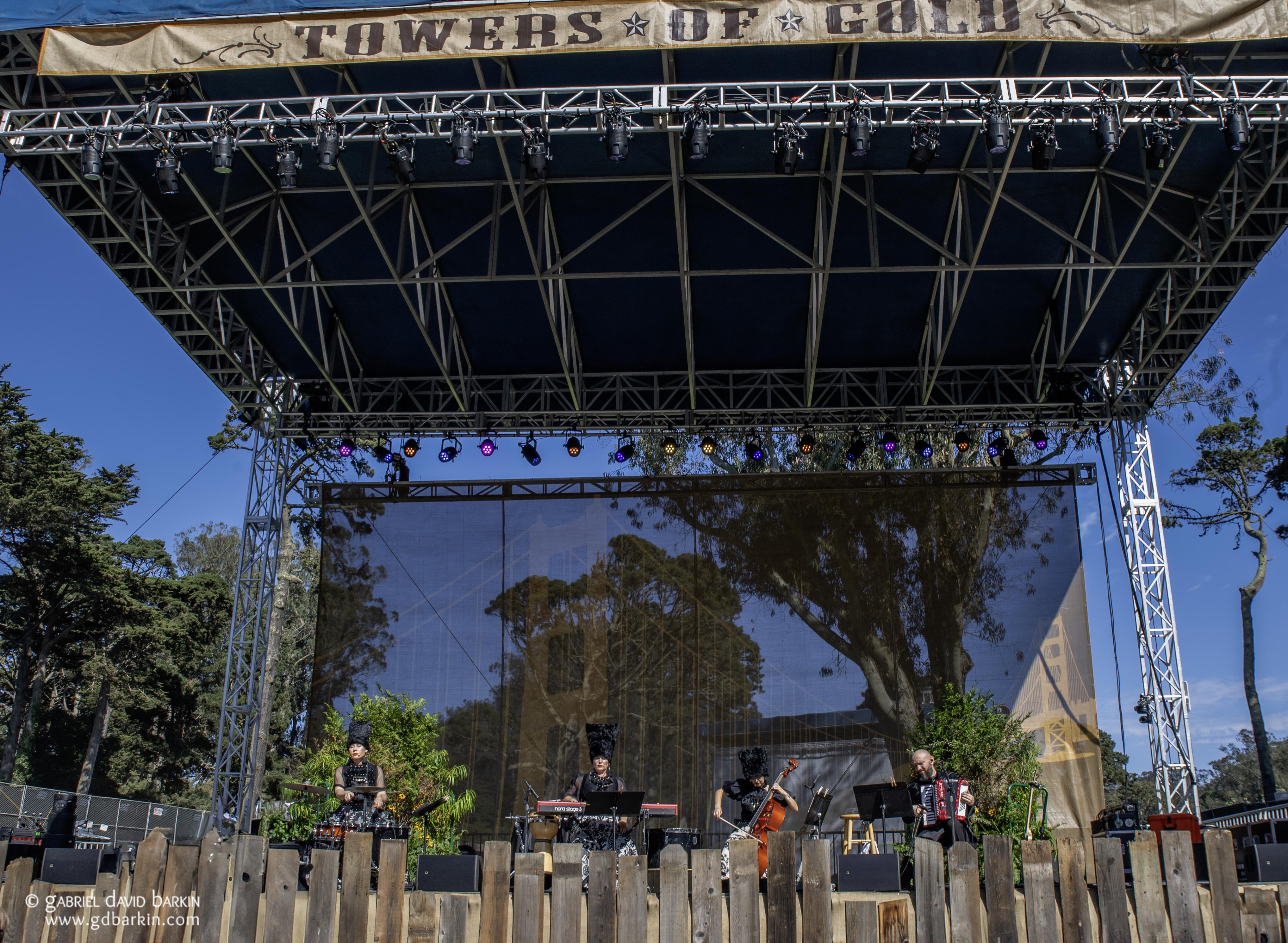
When I said that Sleater-Kinney wins my vote for “Hardly’est Bluegrass,” I was well aware that others might award the honor to Ukraine’s DakhaBrakha. But the quartet is rooted deeply in their own country’s roots music, so there’s a kinship with bluegrass in DakhaBrakha’s Eastern European mélange. Having said that, DakhaBrakha, also on Towers, was one of my favorite sets of the year.
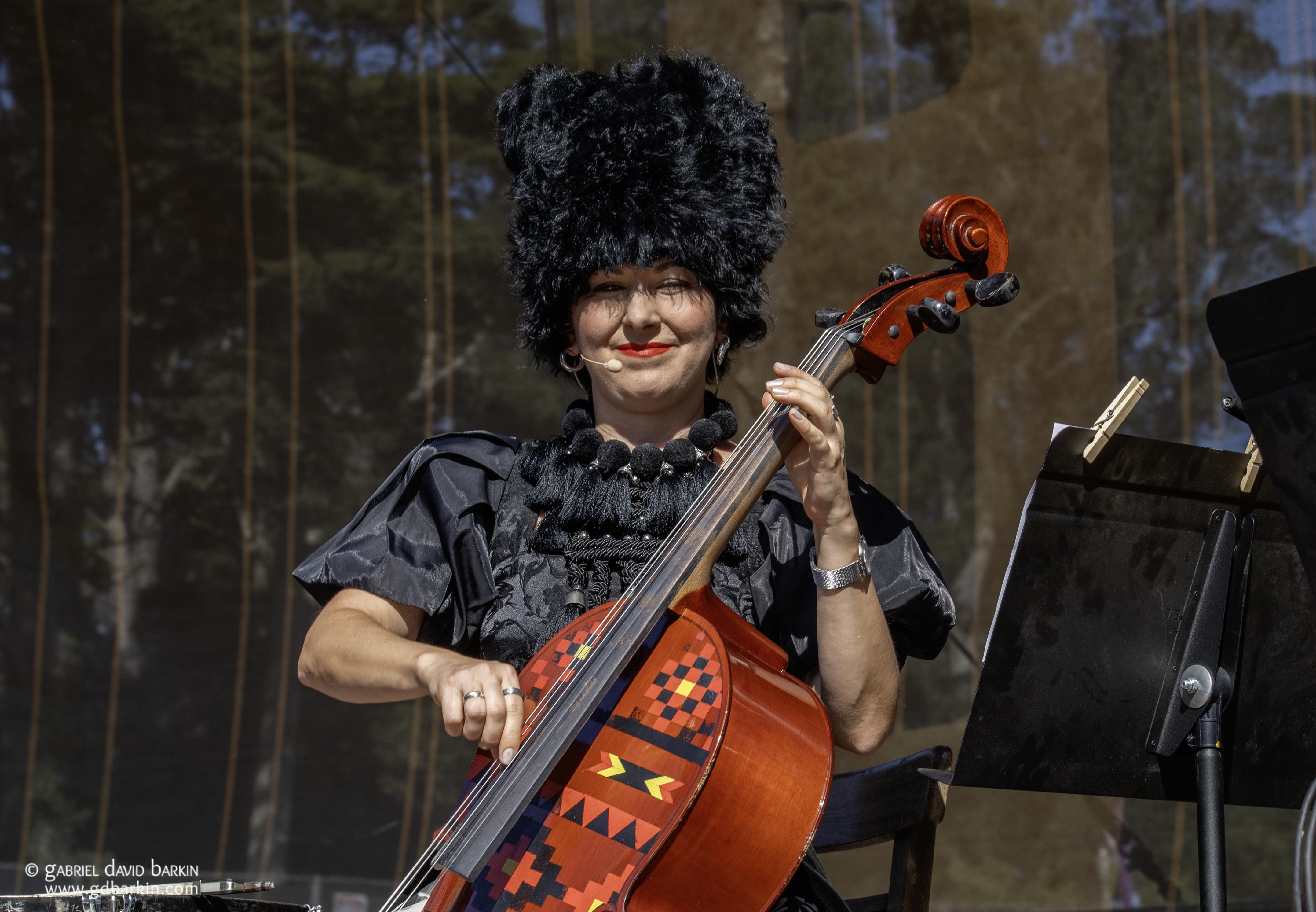
I first “discovered” them in a small café on Frenchmen Street in New Orleans a few years ago. If their traditional Ukrainian clothing doesn’t grab your attention, their infectious smiles and deep passion for their music will reel you in. And it’s not all what some might derisively call “goat farm music.” Some of their songs rock with Velvet Underground intensity. Think “Heroin” with accordion. Others are funky; one rap song about a woman trying to find a husband was deep in Fugees territory. The spoken intro for this one, in broken English with a heavy accent, was, “Life can be complicate [sic], like when girl try to find husband. Sometimes it go—” As the speaker’s voice trailed off, a twang from a Jew's harp completed the sentence. For another song, their self-description of being “ethno-techno” summed it up perfectly.
I strongly suggest finding a live video of DakhaBrakha and dancing madly like a trippin’ goat herder in your living room.
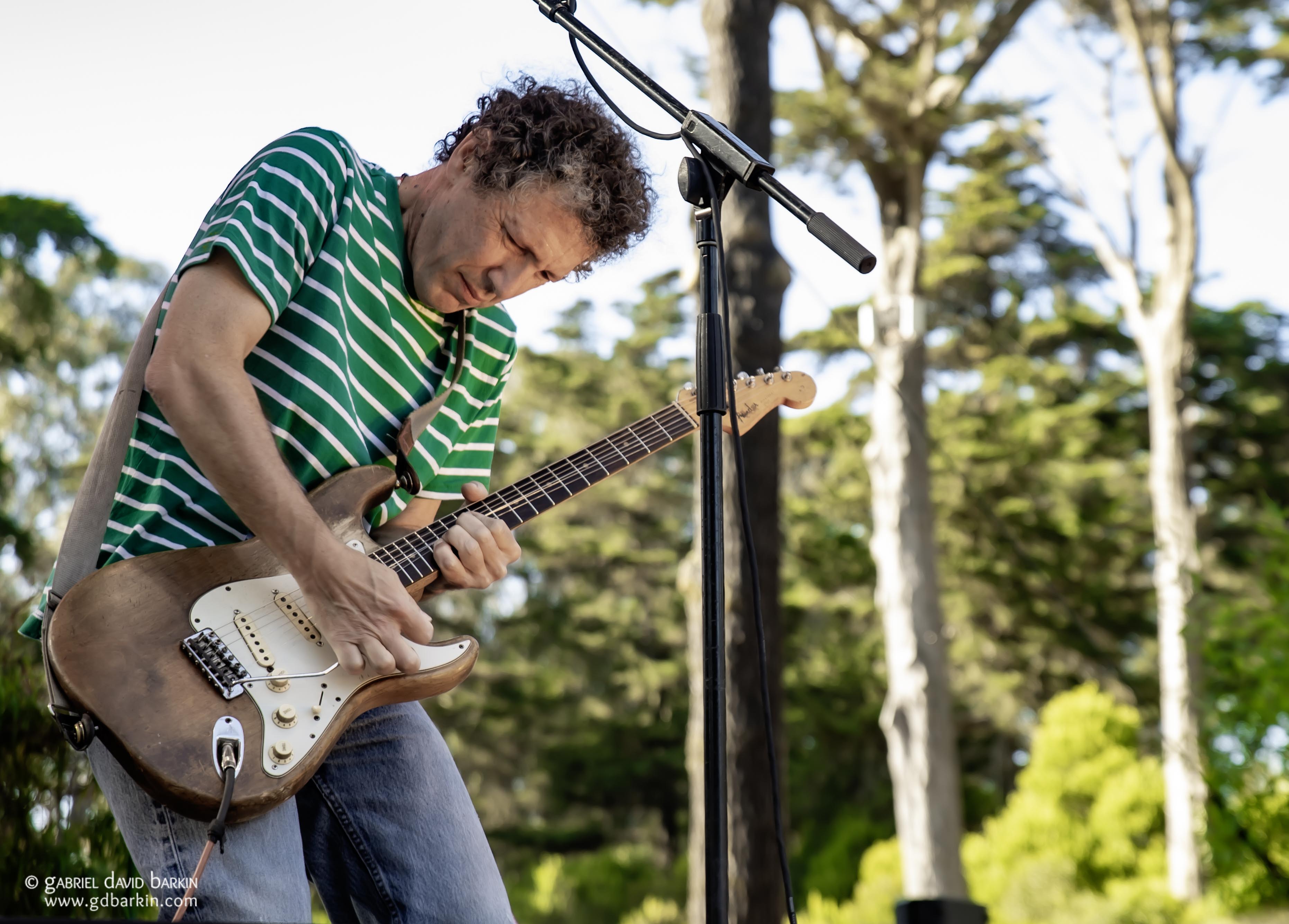
Given my love for alternative rock, it’s a mystery to me why I never spent time listening to Yo La Tengo. The trio from Hoboken, NJ, has been together for 40 years, and their mark on the world of indie music is indelible. More than anything, I was impressed on Sunday by Ira Kaplan’s shredding guitar work on the Swan Stage. I was also impressed by the massive crowd, the largest I saw for any act all weekend.
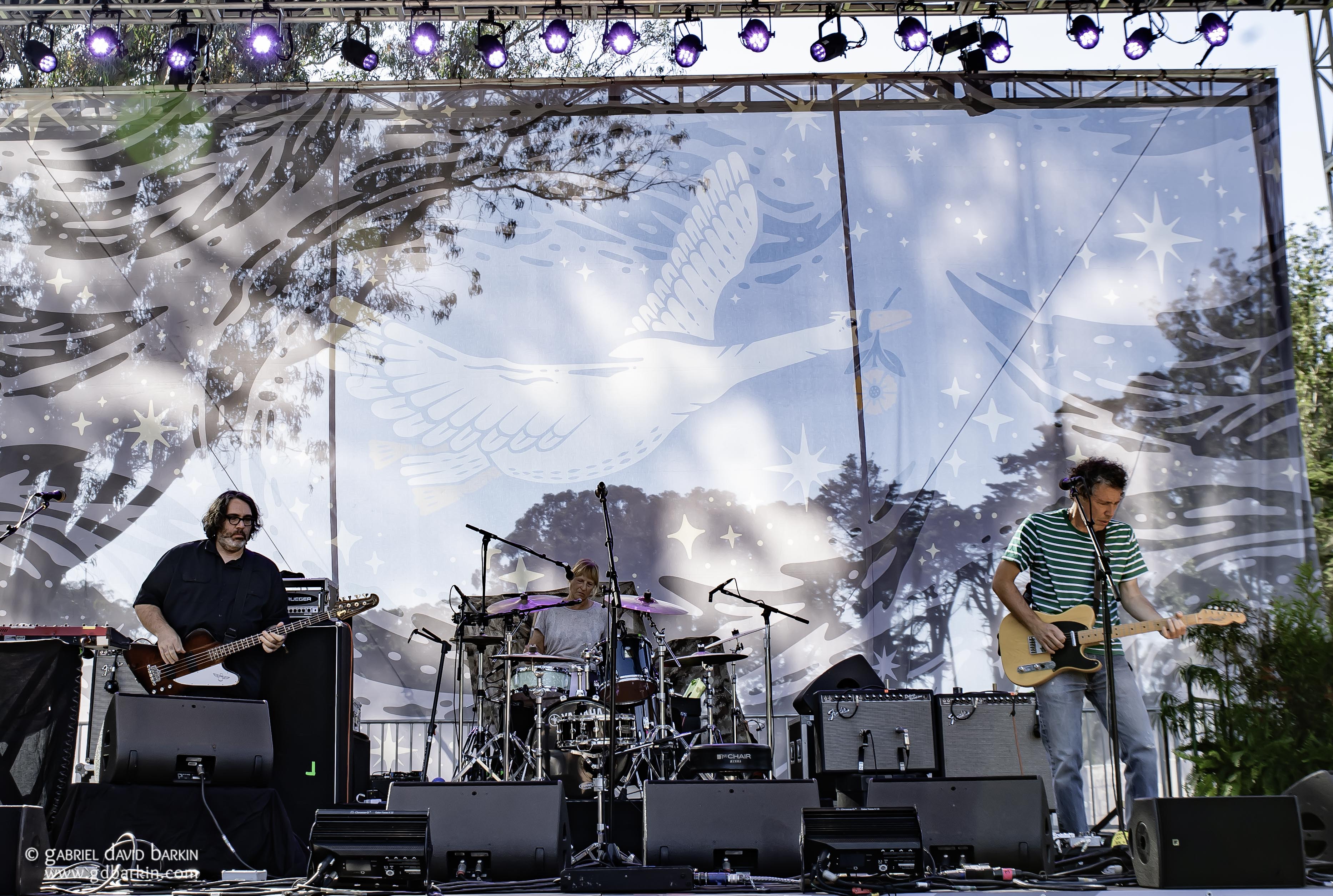
At 4:45 pm on Sunday, all the festival stages were scheduled to spend a moment without music to honor the passing of Greg Wynn, the longtime Operations Producer of HSBG. Wynn died in March this year. In recognition of his significant contributions to the festival, including his efforts to manage the flow of festivalgoers and minimize traffic snarls, the organizers named a central intersection in Golden Gate Park, between the Rooster Stage and Arrow Meadow, "Wynn’s Crossing."

Patti Smith was the final act of the weekend on the Towers of Gold Stage. Notably, her band for this show did not include longtime collaborator Lenny Kaye, but her son Jackson Smith (his father was Fred “Sonic” Smith of the MC5) played guitar alongside bass player/keyboardist Tony Shanahan and Barrett Martin on drums.
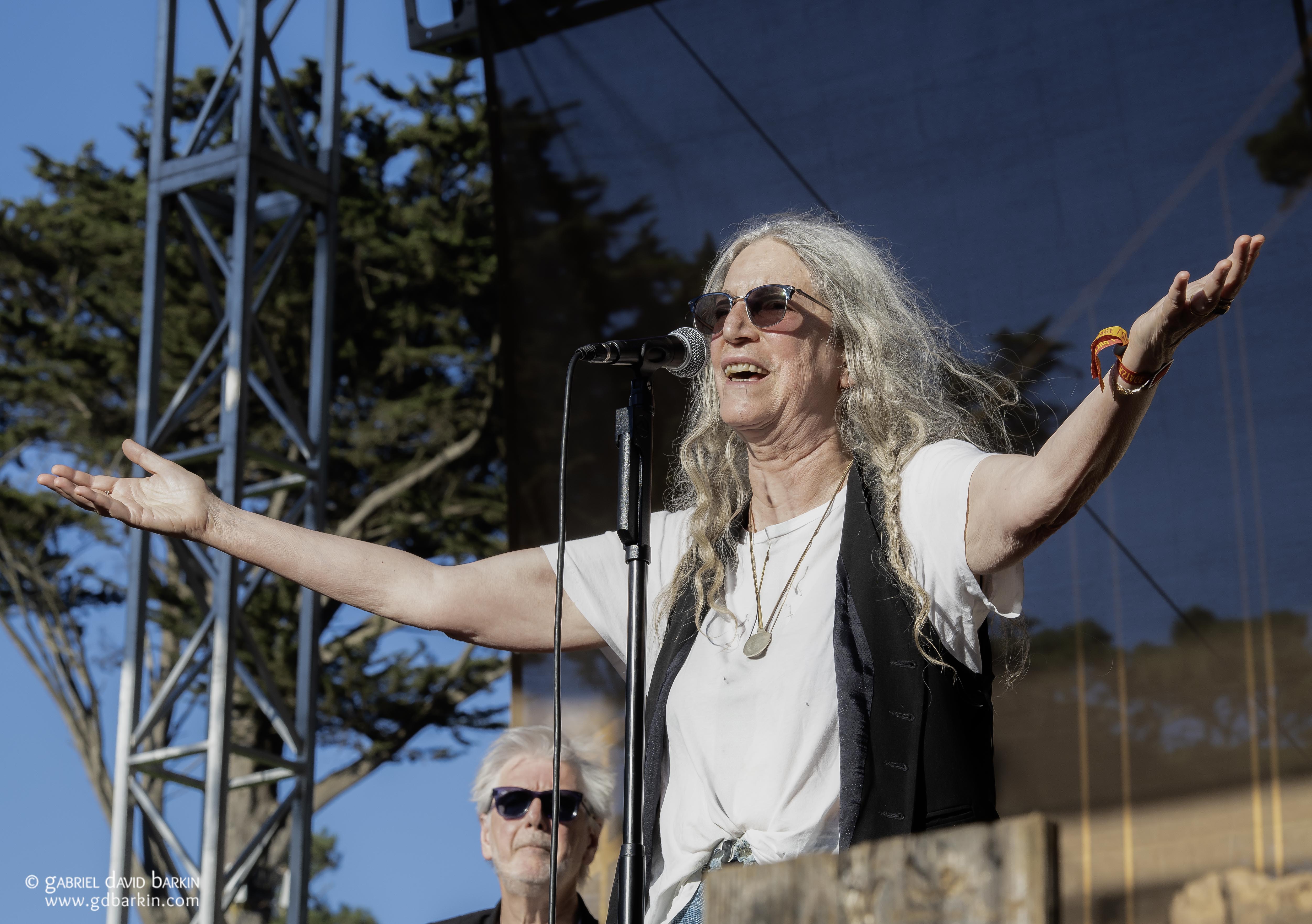
She opened with “Dancing Barefoot,” which was probably the only Patti Smith song many of the audience members recognized. Surely, many also knew Nirvana’s “Smells Like Teen Spirit” when she covered it. This came after singing her own tribute song to Kurt Cobain, 1996’s “About a Boy.”
At one point, she read poetry from a sheet of printer paper, and you could hear a pin drop during her recitation. “Cry humanity, your song is done. Who shall remain to greet the sun?” Throughout her set, Smith scowled, she smiled, she basked in the adoration of thousands of fans, and she strutted like a rock god—which she certainly is.
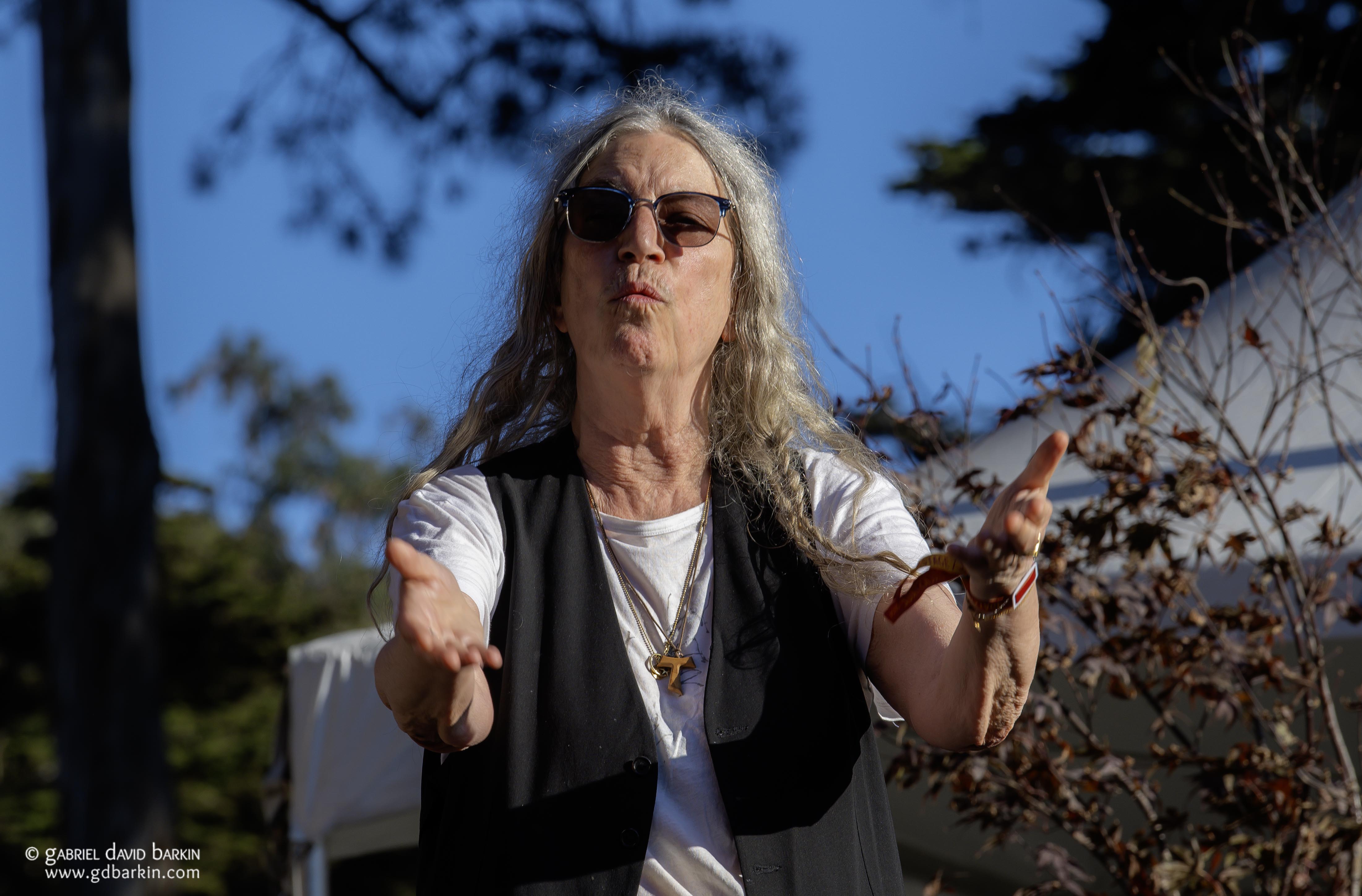
Smith, who notably disdains cameras in her face when she’s on stage, literally shooed off the photogs in the pit after our allotted three songs. One shutterbug stubbornly remained behind, and Smith was visibly outraged a song later when she strode to the side of the stage to tell a member of her production team to get that person out of the pit. That’s Patti Smith.
The set closer was her anthemic “People Have the Power.” They do, and Smith reminds us to use our power for good every time. That’s Patti Smith too.
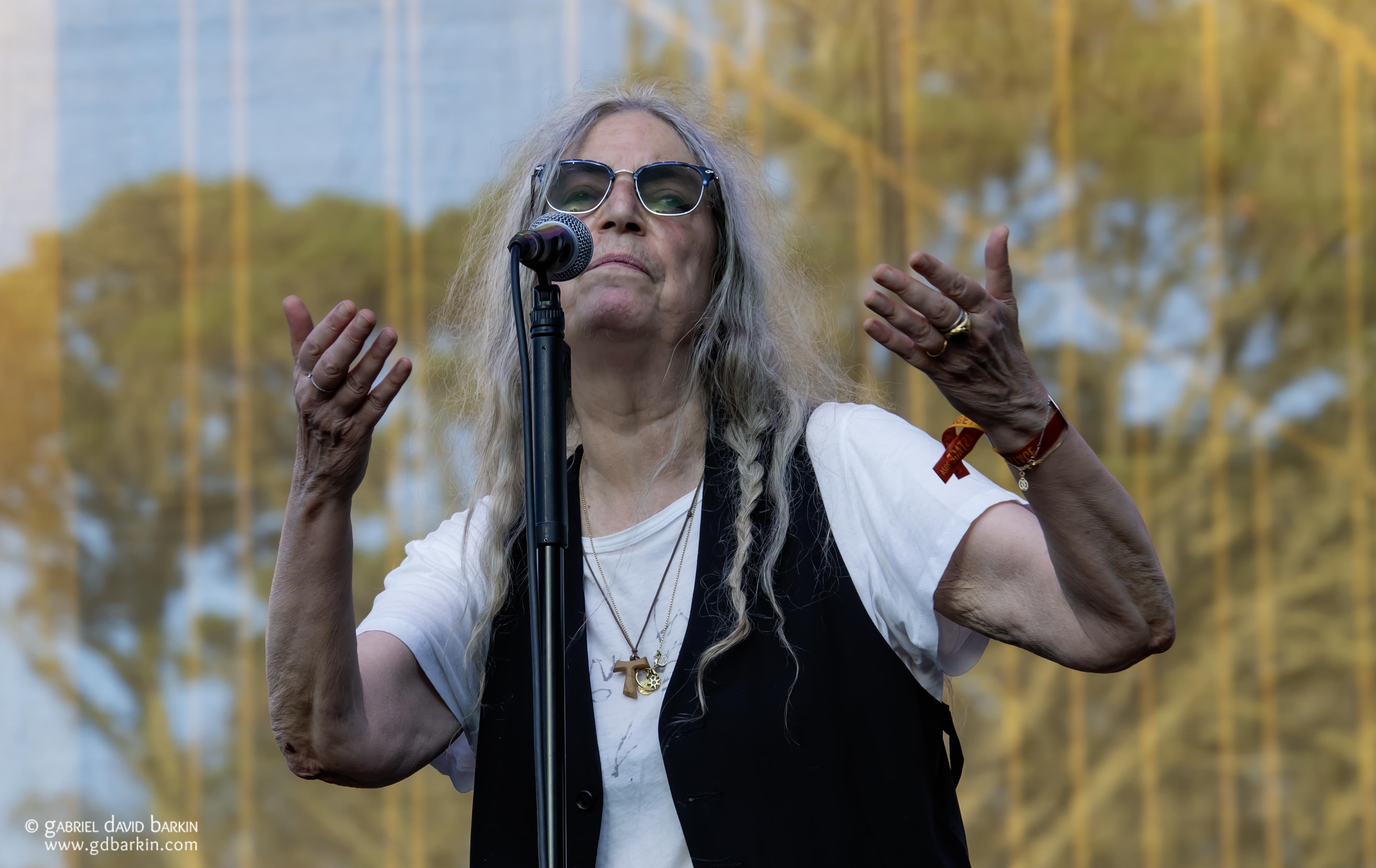
As The Wood Brothers began playing on the Swan Stage, most of the crowd at Towers of Gold began to drift off toward their cars, Ubers, buses, and homes. Some stayed in the park to wander over to see Emmylou Harris or The Infamous Stringdusters elsewhere in the festival. The heat was waning as the sun set on another incredible year of Hardly Strictly Bluegrass.
HSBG by the Numbers – Interlude #6:
- Final year of the festival: the Hellman Foundation says it will fund HSBG at least through 2034, and perhaps beyond.
- Average ticket price over the lifespan of HSBG: $0.
- Number of thanks to founder Warren Hellman and the Hellman family for staging HSBG year after year: immeasurable.





